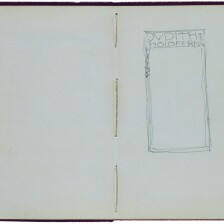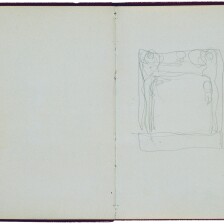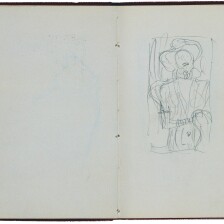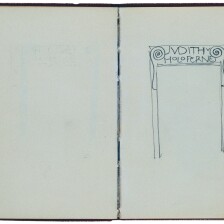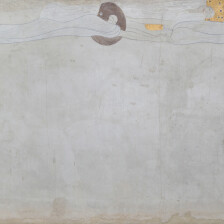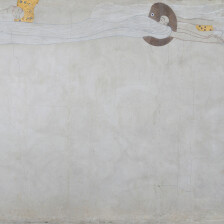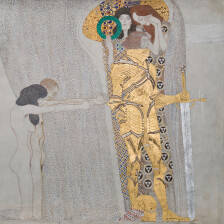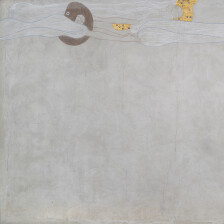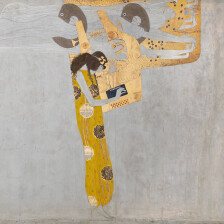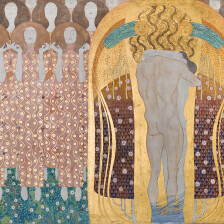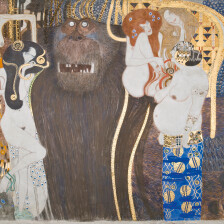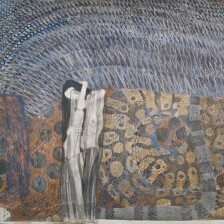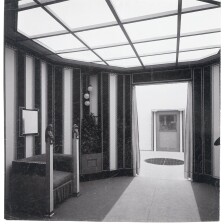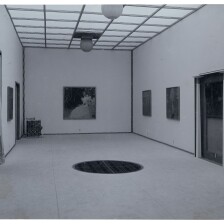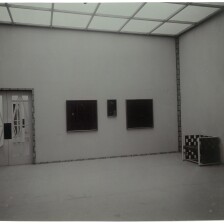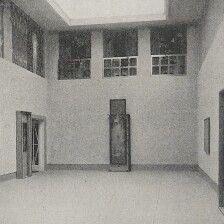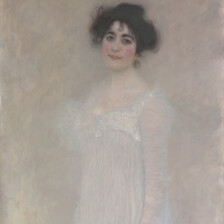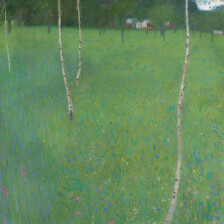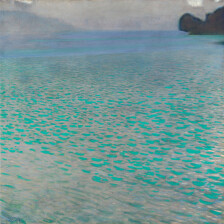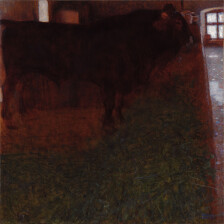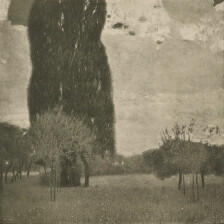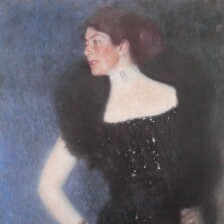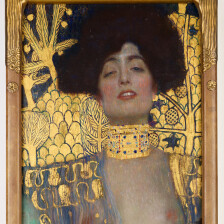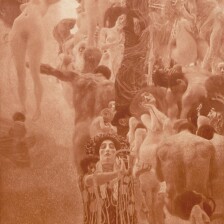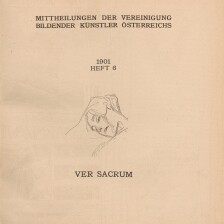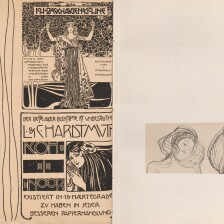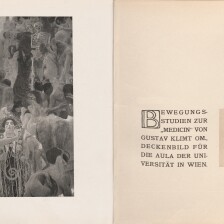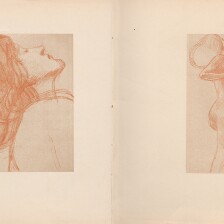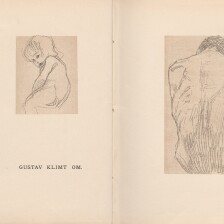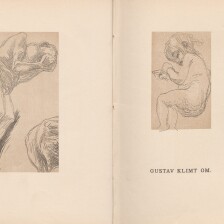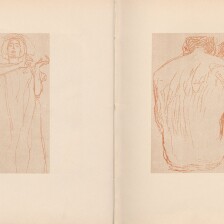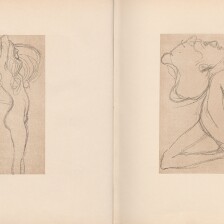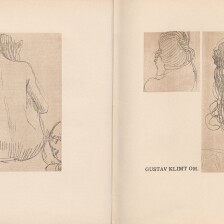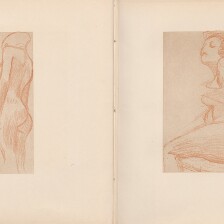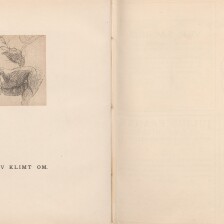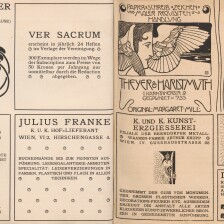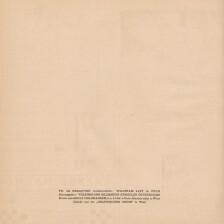Klimt's work focuses on all aspects of the Art Nouveau master's oeuvre. Visualized through a timeline, Klimt's creative periods are rolled up here, starting with his training, his collaboration with Franz Matsch and his brother Ernst in the "Künstler-Compagnie", the affair surrounding the faculty paintings and his post-fame and the myth that still surrounds this exceptional artist today.
The Golden Knight and Femmes Fatales
Between 1901 and 1903, Gustav Klimt created some of the most important works of his entire oeuvre: the Faculty Paintings, the Beethoven Frieze, and Hope I. In the "Klimt-Kollektive" ["Gustav Klimt Collective Exhibition"], his first solo exhibition at the Vienna Secession, he presented himself as a painter of female portraits, landscapes of square format, and mysterious underwater worlds.
→
Gustav Klimt: The Golden Knight (Life a Battle), 1903, Aichi Prefectural Museum of Art
© Aichi Prefectural Museum of Art, Nagoya
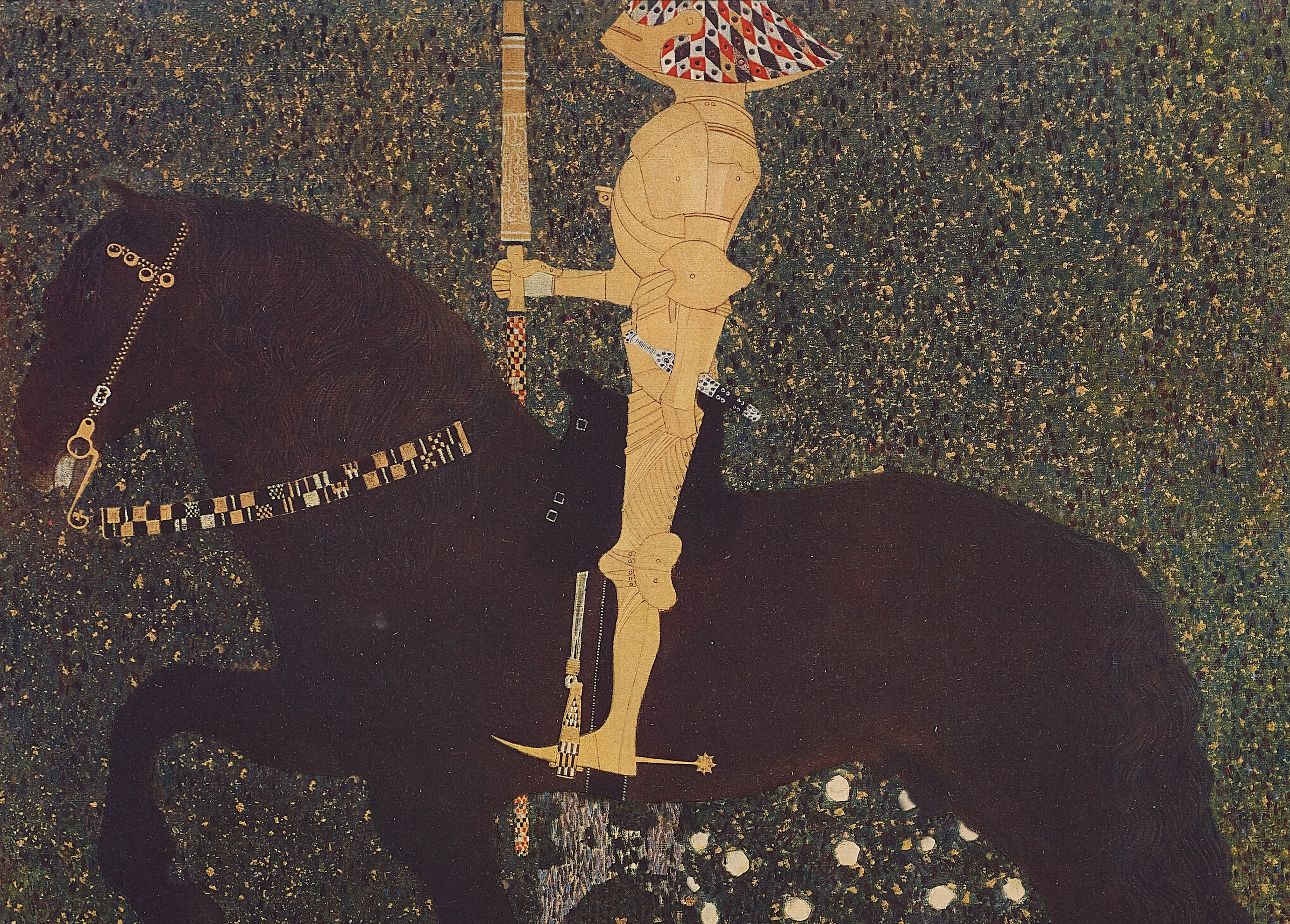
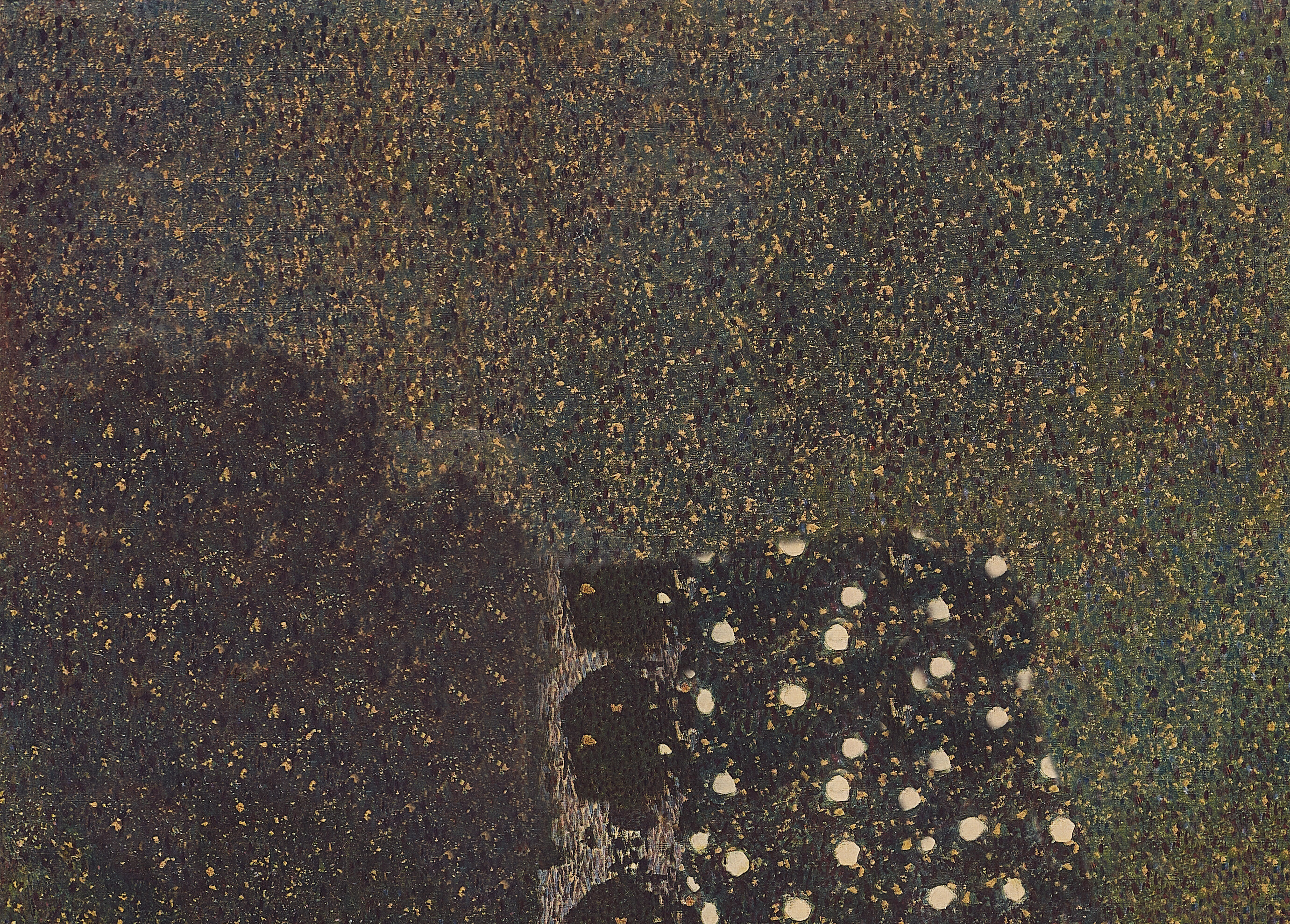
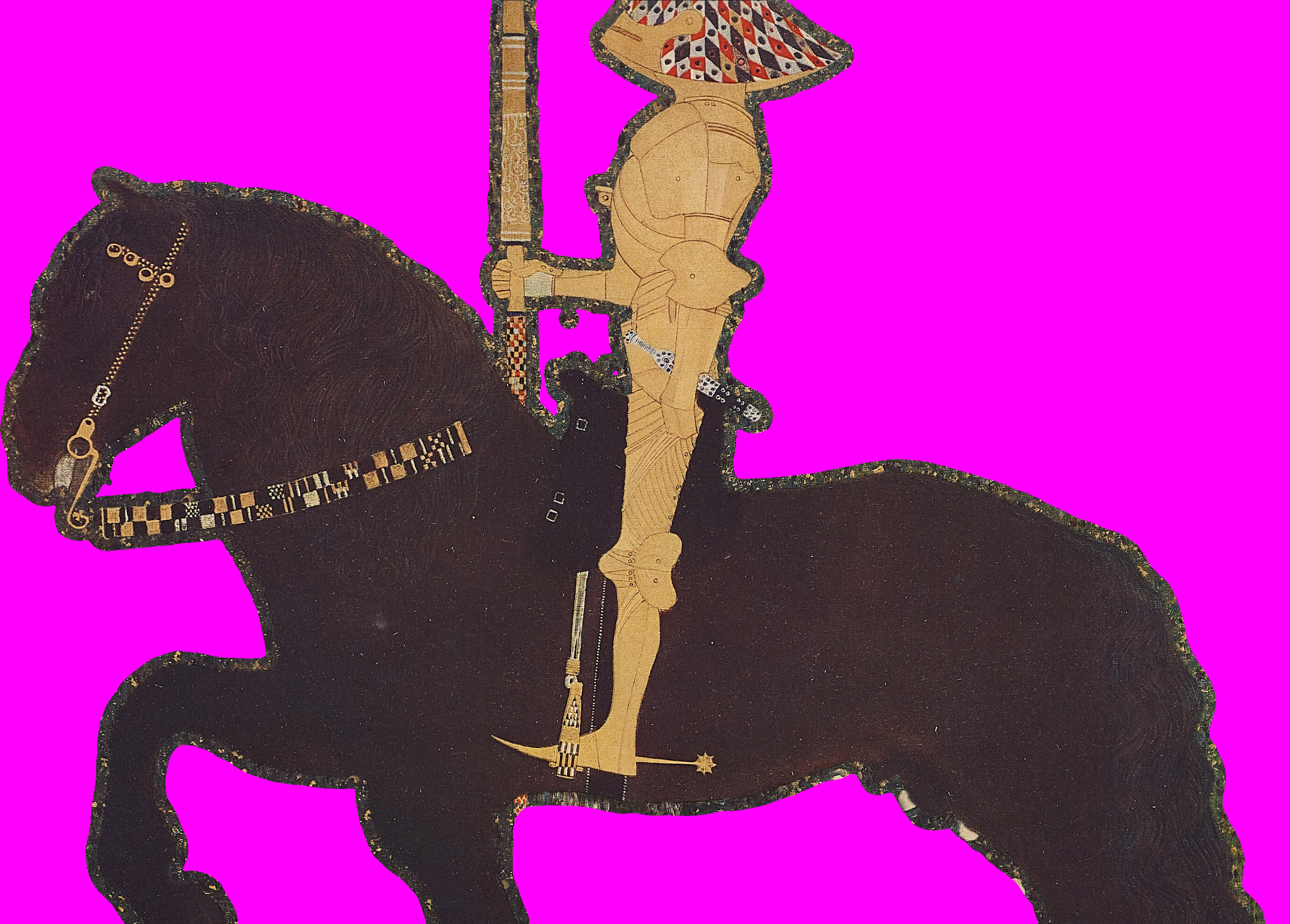
Allegories of Danger
In his allegories dating from the beginning of the 20th century, Klimt dealt primarily with the subject of dark forces, personified by the wicked femme fatale, the knight and his eternal struggle, or the vision of Death. In 1903 he turned to the subject of death and life and the relationship between man and woman in Hope I.
To the chapter
→
Gustav Klimt: Hope I, 1903/04, National Gallery of Canada
© NGC
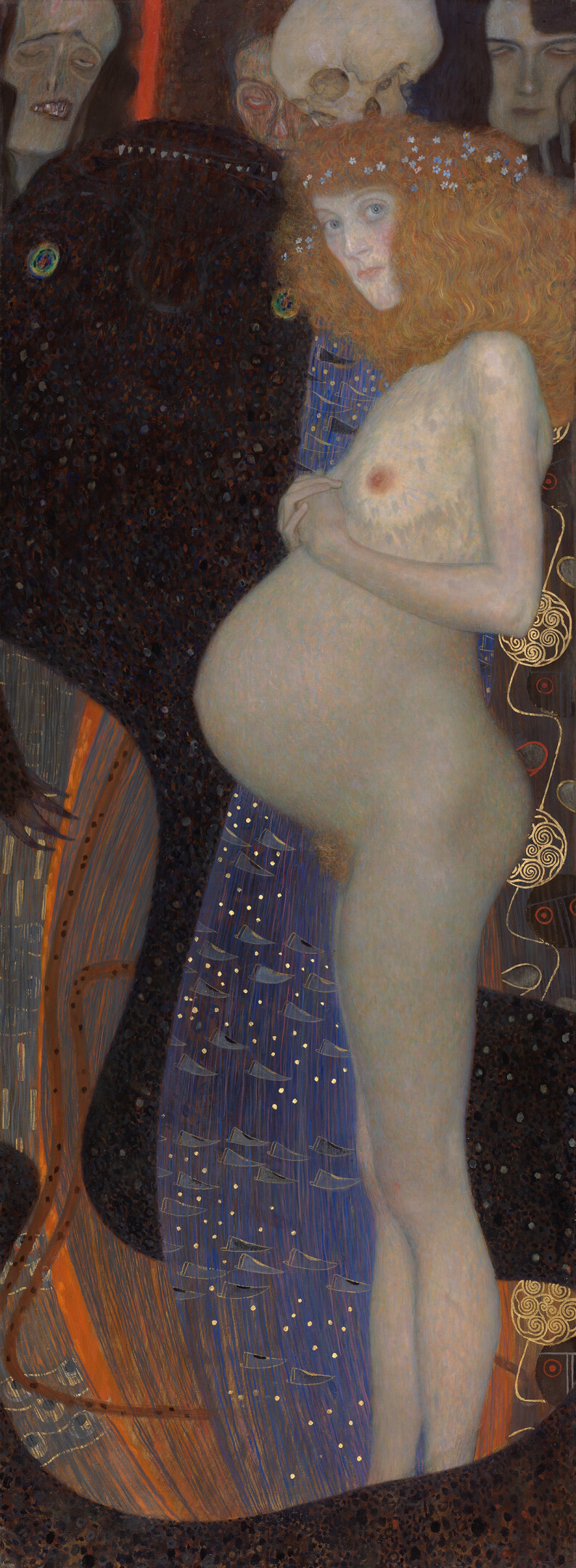
Mystic Underwater Worlds
Klimt’s output between 1901 and 1903 is characterized by such fantastic and mystical figures as mermaids, will-o’-the-wisps, and whimsical aquatic creatures.
To the chapter
→
Gustav Klimt: Goldfish, 1901/02, Kunstmuseum Solothurn, Dübi-Müller-Stiftung
© Kunstmuseum Solothurn
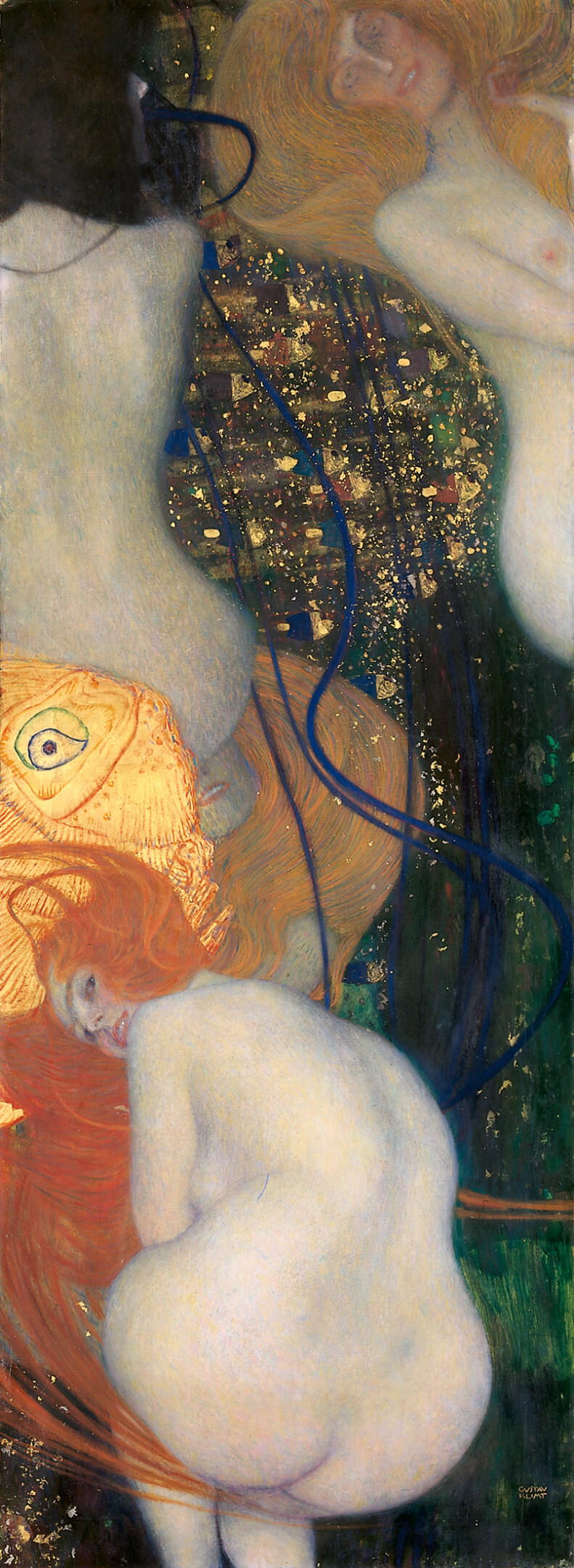
The Beethoven Frieze
On the occasion of the presentation of Max Klinger’s monumental Beethoven statue at the Vienna Secession in 1902, Gustav Klimt conceived the so-called Beethoven Frieze. Painting directly onto three exhibition walls using casein paints, the artist intended his work to lead up to the central sculpture thematically, thus contributing with the frieze to what was to become a Gesamtkunstwerk or universal work of art. Although Ludwig van Beethoven is mentioned in the title, the composer is not depicted.
To the chapter
→
Gustav Klimt: The Beethoven Frieze (The Suffering of Weak Mankind, The Well-Armed Strongman), 1901/02, Österreichische Galerie Belvedere
© Belvedere, Vienna
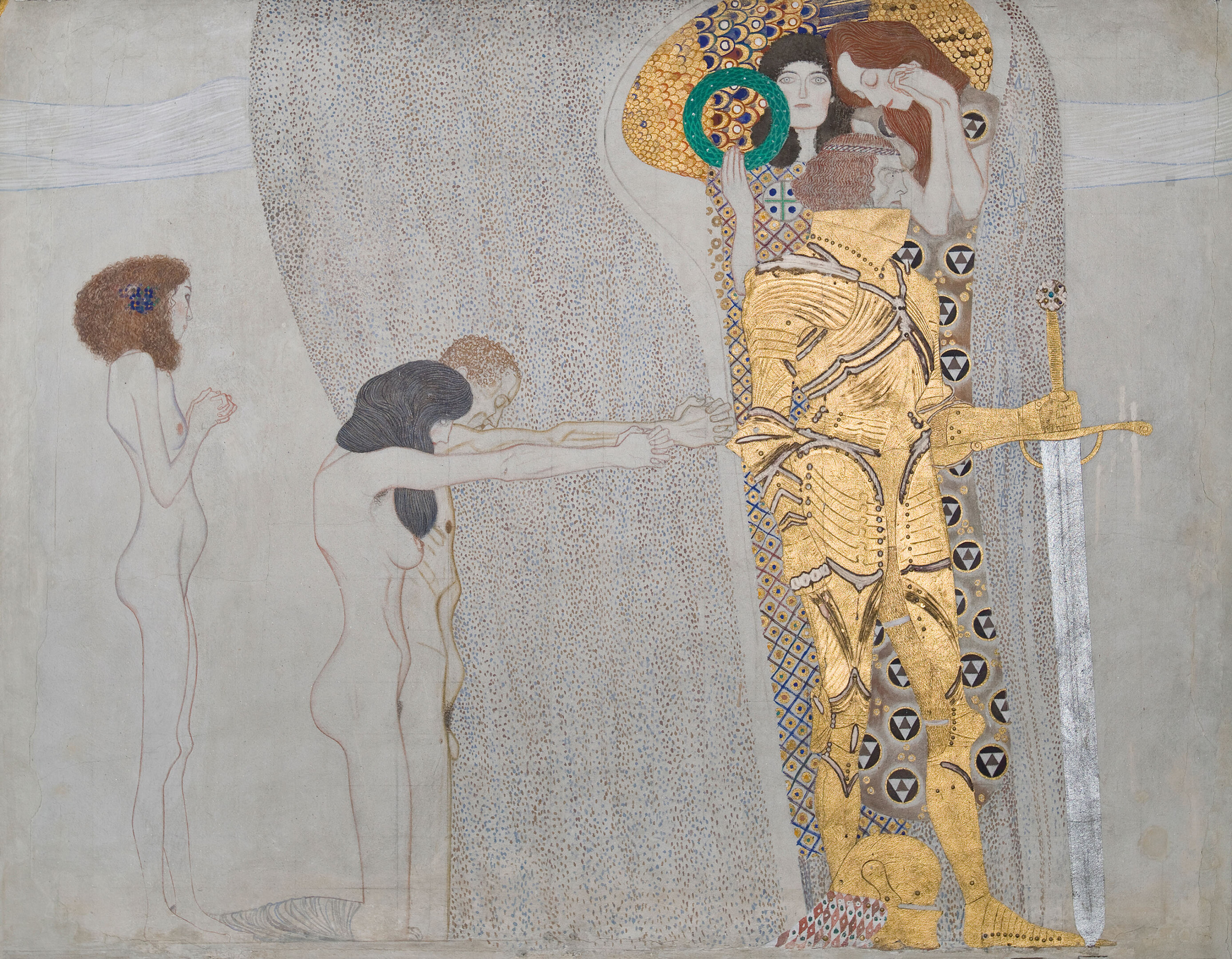
Trees and Forests
Having arrived at a personal approach to landscape painting between 1898 and 1900, Klimt made use of the motif of the forest view for stylistic experiments in the years between 1901 and 1903. A phase of Post-Impressionism and Pointillism was followed by the artist’s turn toward flatness.
To the chapter
→
Gustav Klimt: The Large Poplar II (Gathering Storm), 1902/03, Leopold Museum
© Leopold Museum, Vienna
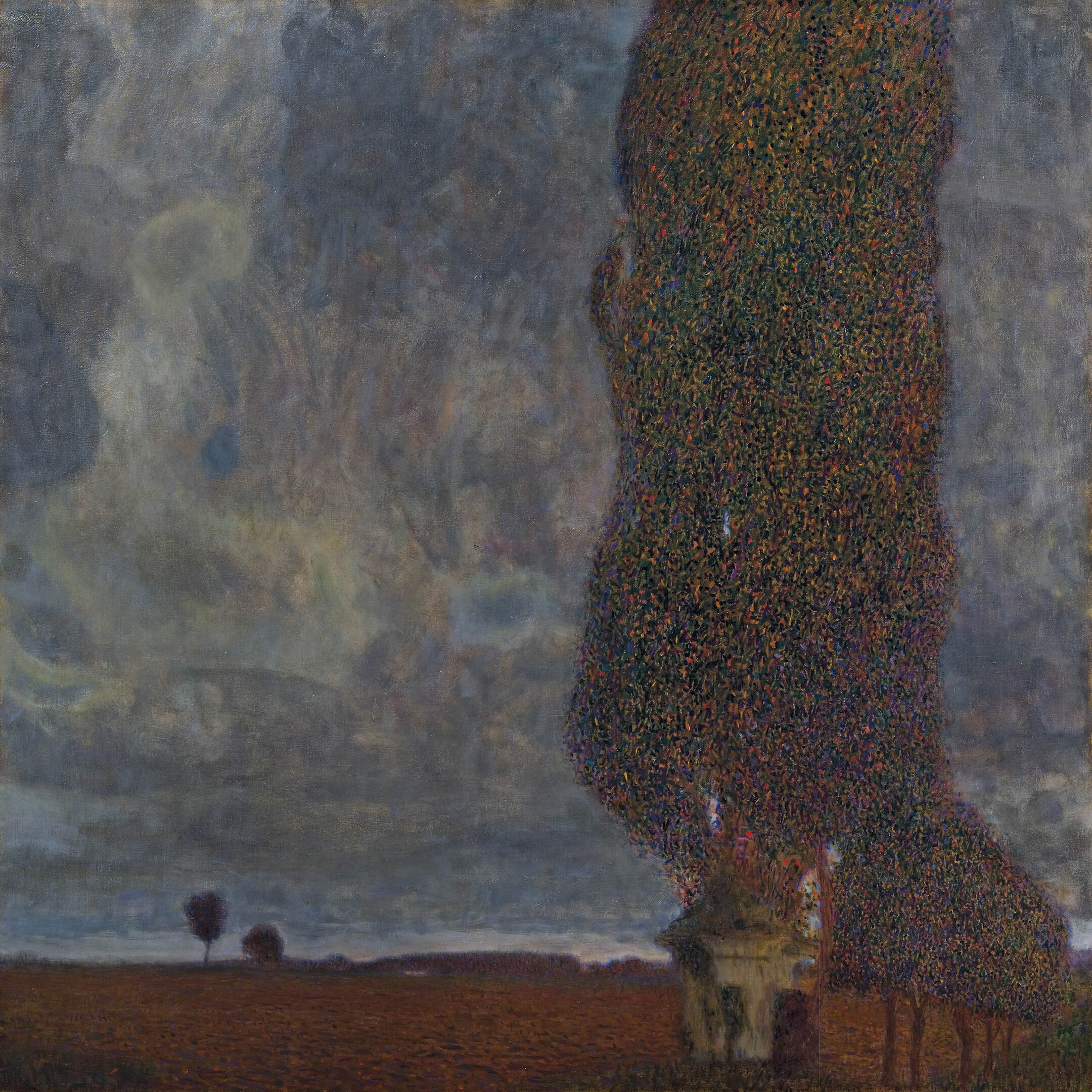
Viennese Society Portraits
From 1900 onwards, Gustav Klimt increasingly established himself as a portraitist of the upper echelons of Viennese society. Above all, his ability to capture the latest fashion trends on canvas in a gossamer painting style quickly became his personal signature. Successively introducing more ornamentation in his portraits, Klimt already anticipated the two-dimensionality of his subsequent works.
To the chapter
→
Gustav Klimt: Portrait of Emilie Flöge, 1902/03, Wien Museum
© Wien Museum
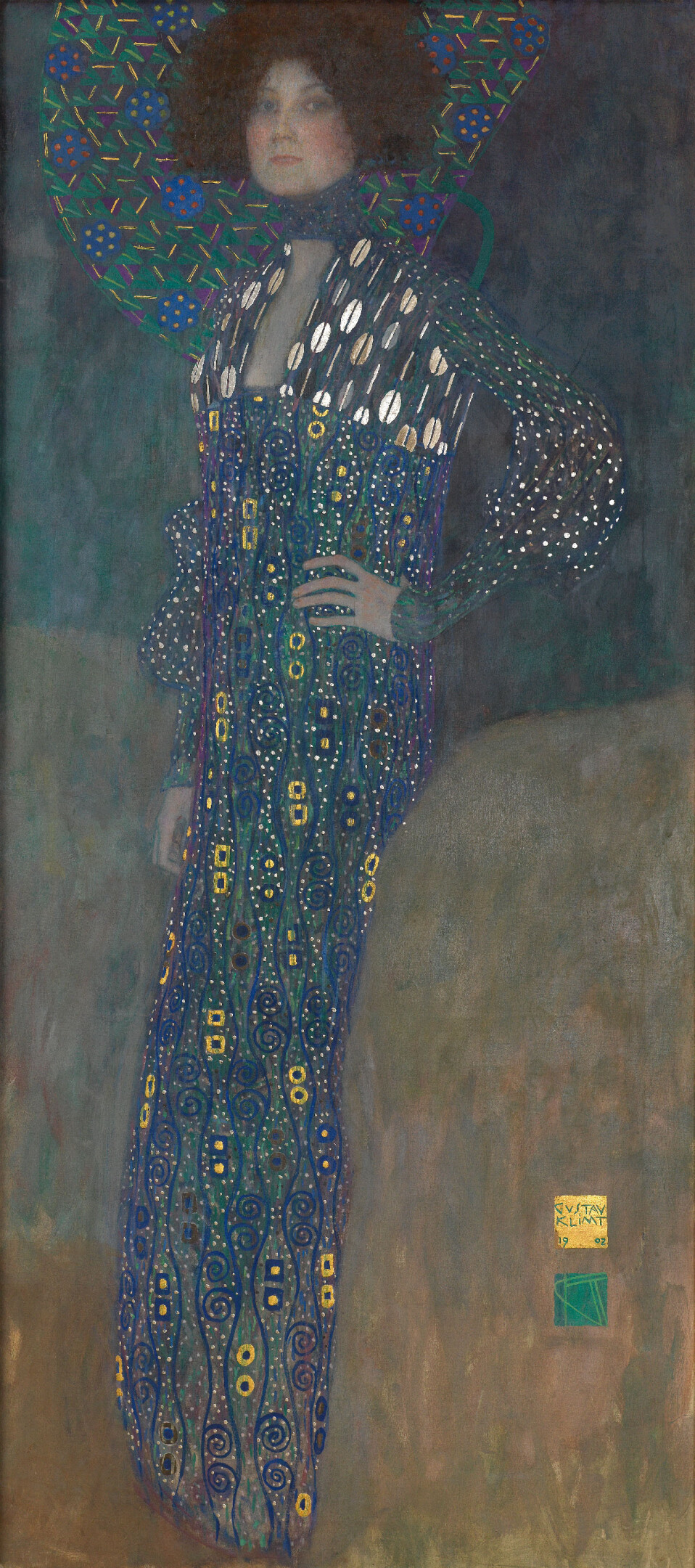
Faculty Paintings. Medicine and Jurisprudence
Between 1900 and 1903, Gustav Klimt worked intently on the two Faculty Paintings Medicine and Jurisprudence for the auditorium of Vienna University. When the paintings were first presented in 1901 and 1903, they caused scandals, as the Faculty Painting Philosophy had done in 1900. Following numerous alterations and additions carried out until 1907, the works were destroyed in fire at Immendorf Castle in 1945.
To the chapter
→
Gustav Klimt: Medicine, 1900-1907, 1945 in Schloss Immendorf verbrannt, in: Kunstverlag Hugo Heller (Hg.): Das Werk von Gustav Klimt, Vienna - Leipzig 1918.
© Klimt Foundation, Vienna
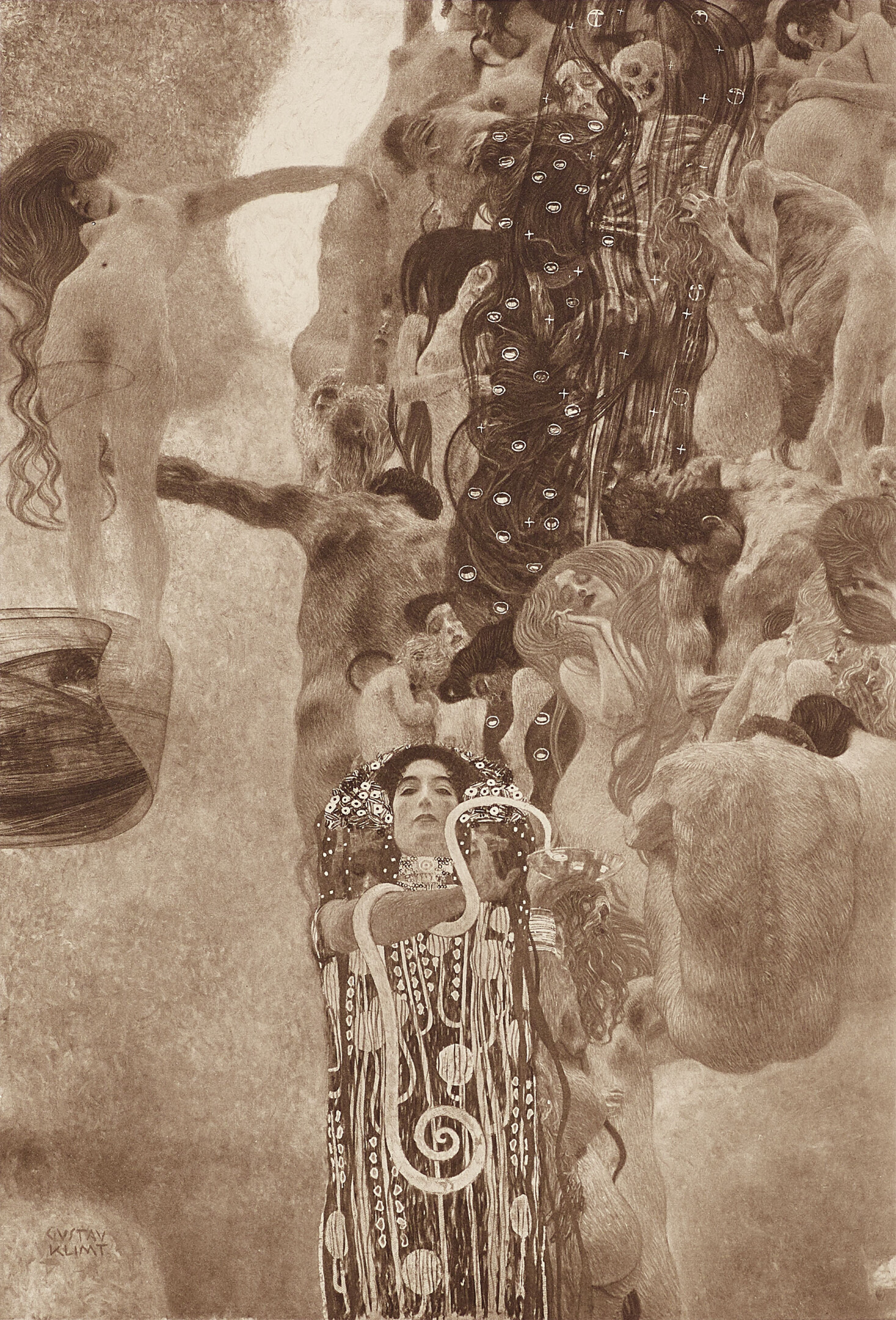
Klimt-Kollektive
The XVIII. Ausstellung der Vereinigung bildender Künstler Österreichs Secession Wien [13th Exhibition of the Association of Austrian Artists Vienna Secession] presented a comprehensive monographic exhibition dedicated to its former president Gustav Klimt. Comprising as many as 80 works, the show offered a survey of the artist’s works created to this date. For the first time, the Faculty Paintings Philosophy, Medicine, and Jurisprudence were displayed together in an exhibition.
To the chapter
→
Gustav Klimt: Poster of the XVIII Secession Exhibition (Klimt Collective), 1903, Wien Museum
© Wien Museum

Exhibition Activity
Between 1901 and 1903, Klimt took part in more than twenty exhibitions. The Faculty Painting of Medicine, which was presented in 1901, caused a scandal but at the same time brought about a lively interest in Klimt as an artist both at home and abroad. The highlight during these three years full of exhibitions was certainly the “Kollektiv-Ausstellung Gustav Klimt” [“Gustav Klimt Collective Exhibition”] in Vienna in 1903.
To the chapter
→
Kolo Moser: Poster of the XIII Secession Exhibition, 1902, Museum für Kunst und Gewerbe Hamburg (MK&G)
© Museum für Kunst und Gewerbe Hamburg
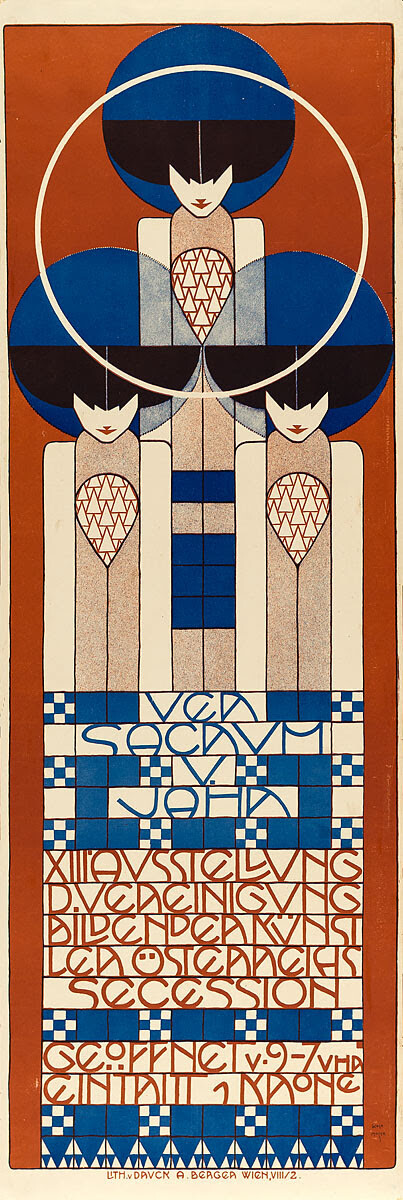
Drawings
Shortly after 1900, Klimt expanded his previously preferred medium of charcoal to include a pointed pencil and polychromy in the form of colored pencils. Beautifully curved outlines and parallel hatching became increasingly relevant. Using nude models, he studied postures and emotions in coherent series.
To the chapter
→
Gustav Klimt: Bust portrait of a man from the front, 1901-1903, Wien Museum
© Wien Museum
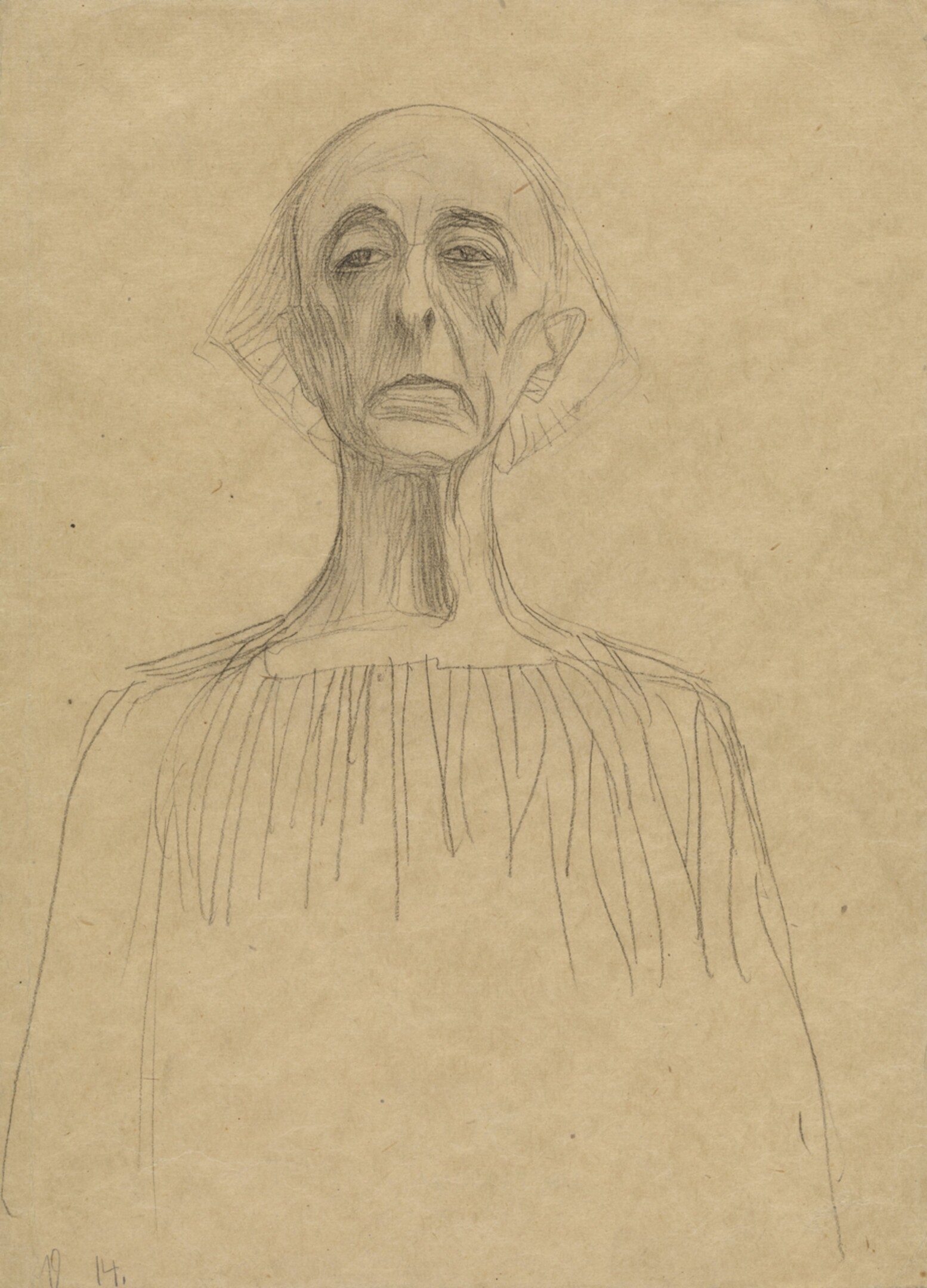



The Golden Knight and Femmes Fatales
Between 1901 and 1903, Gustav Klimt created some of the most important works of his entire oeuvre: the Faculty Paintings, the Beethoven Frieze, and Hope I. In the "Klimt-Kollektive" ["Gustav Klimt Collective Exhibition"], his first solo exhibition at the Vienna Secession, he presented himself as a painter of female portraits, landscapes of square format, and mysterious underwater worlds.
→
Gustav Klimt: The Golden Knight (Life a Battle), 1903, Aichi Prefectural Museum of Art
© Aichi Prefectural Museum of Art, Nagoya
Allegories of Danger
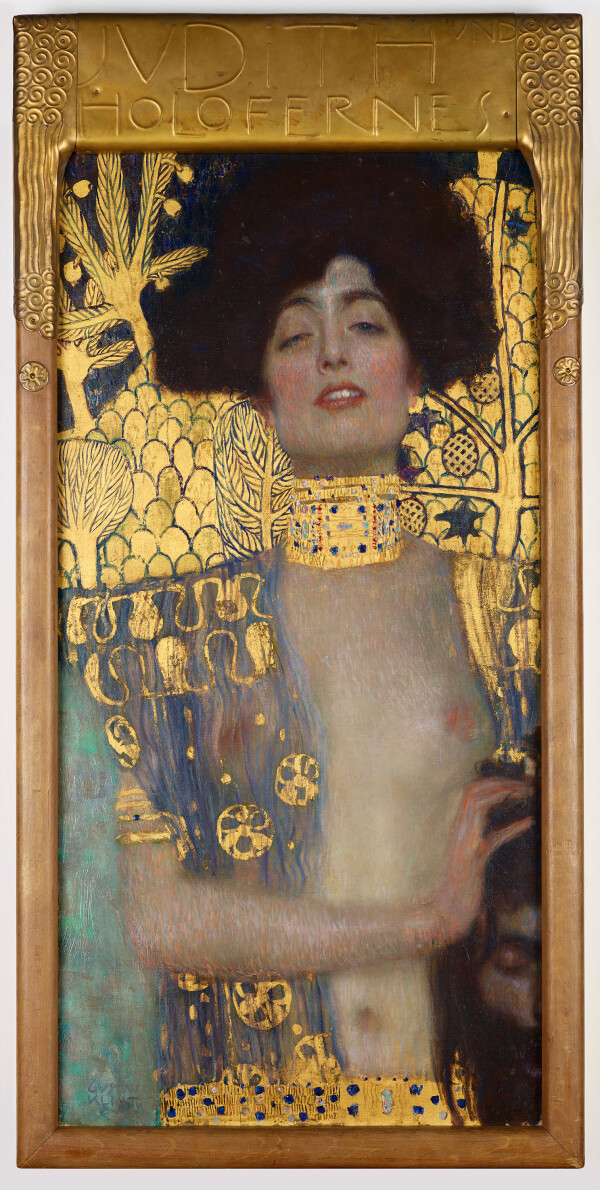
Gustav Klimt: Judith I, 1901, Österreichische Galerie Belvedere
© Belvedere, Vienna
In his allegories dating from the beginning of the 20th century, Klimt dealt primarily with the subject of dark forces, personified by the wicked femme fatale, the knight and his eternal struggle, or the vision of Death. In 1903 he turned to the subject of death and life and the relationship between man and woman in Hope I.
Judith I
The painting Judith I (1901, Belvedere, Vienna) can be seen as a prime example of women shown as femmes fatales. It shows the heroine from the Old Testament with the head of the cruel commander Holofernes embedded in a shiny golden composition with oriental pictorial elements inspired by Assyrian reliefs. The focus is entirely on the female protagonist. The head of Holofernes, half of which is overlapped by the margin of the picture, has been assigned the function of a mere attribute. The feminine aspect is dominant, while the male component is literally marginalized.
The frame, designed by Klimt and inscribed “JUDITH UND HOLOFERNES,” can be seen as part of the composition in the sense of a Gesamtkunstwerk or total work of art. It was executed by Georg Klimt, the painter’s brother, who was a successful metal sculptor. Despite the fact that the protagonist can clearly be identified as Judith thanks to the inscription on the frame, her ambivalent portrayal as a seductive, erotic femme fatale led to her sometimes also being interpreted as Salome – virtuous Judith’s sinful counterpart in the Bible. The art critic Ostini thus remarked:
“For the splendid biblical figure of the slayer of Holofernes, this face is much too lustful and much too perverse. There is a slackness to it that comes not from the act [!] but from the pleasure.”
Klimt’s depiction thus oscillates between triumphant, heroic patriot and sexually dominant, mantis-like killer of men. Sketches in the so-called Red Sketchbook (1898, Belvedere, Vienna), which was once in the possession of Sonja Knips, show that Klimt deliberately heightened the aspect of eroticism by emphasizing the lips and navel. What is crucial here is above all the transposition of time-honored iconographic themes and their simultaneous incorporation in contemporary history. As early as 1903, Felix Salten recognized Klimt’s ability to update mythological figures by seeing in Klimt’s Judith a beautiful Jewish ‘jourdame.’”
Individual Pages from the Red Sketchbook
-
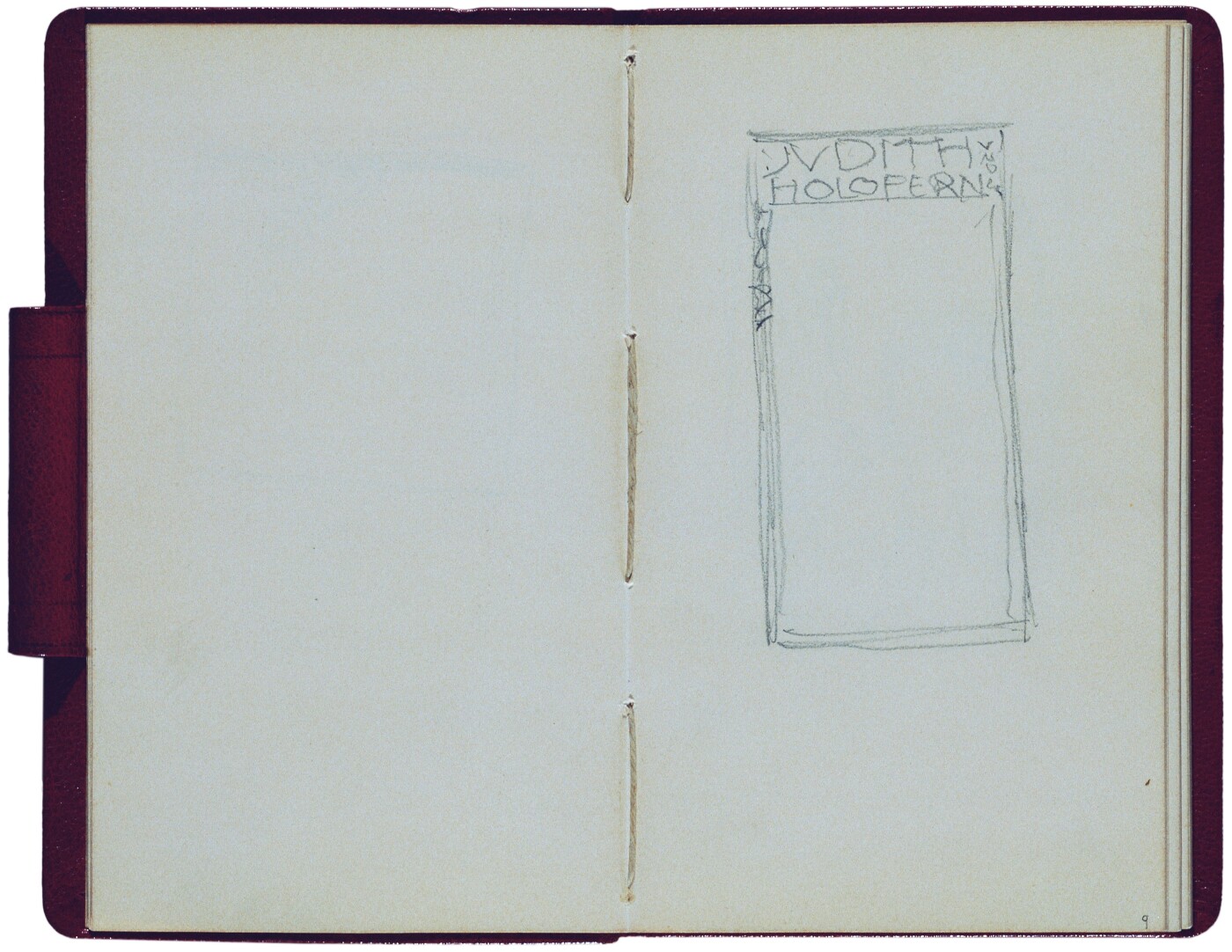 Gustav Klimt: Sonja Knips' red sketchbook, 1898, Österreichische Galerie Belvedere
Gustav Klimt: Sonja Knips' red sketchbook, 1898, Österreichische Galerie Belvedere
© Belvedere, Vienna -
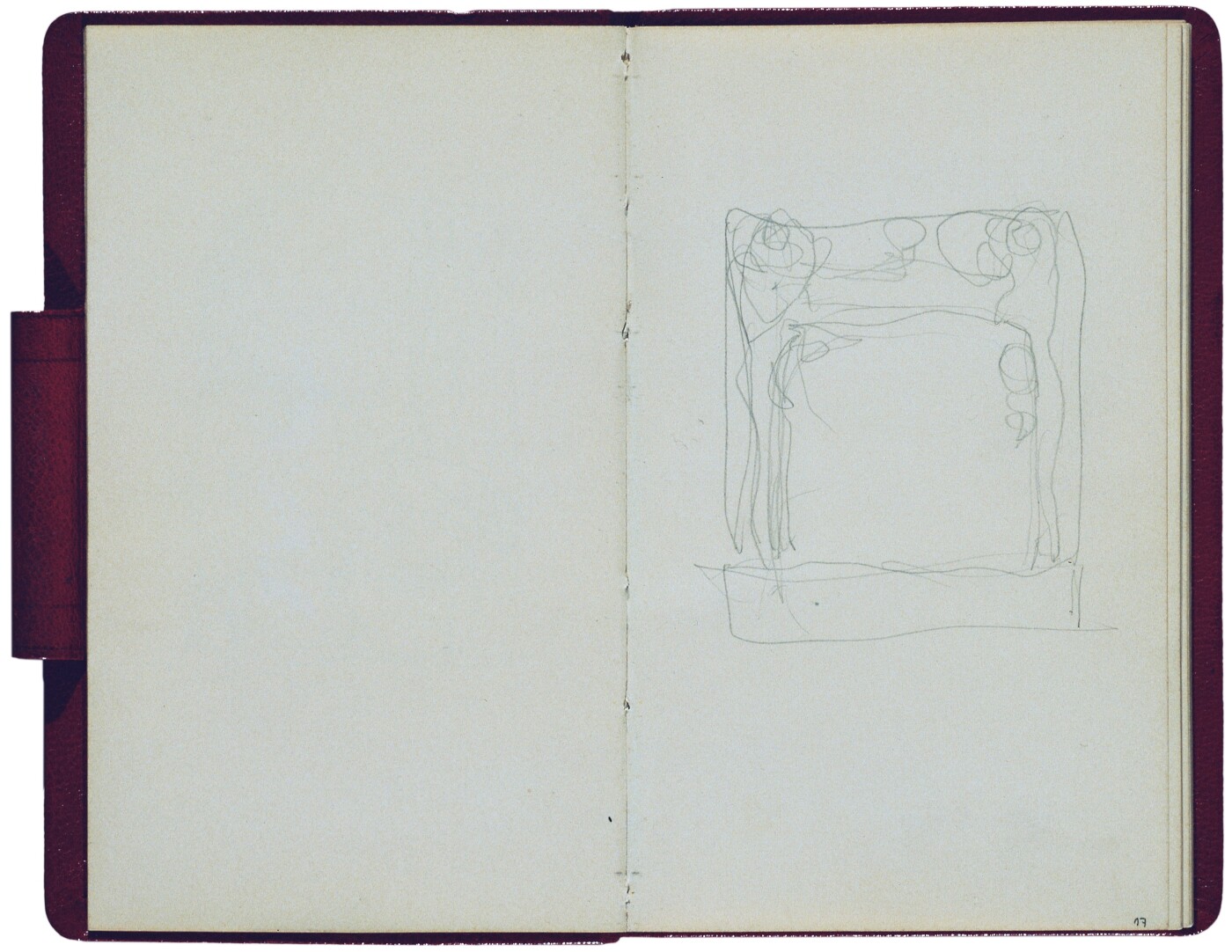 Gustav Klimt: Sonja Knips' red sketchbook, 1898, Österreichische Galerie Belvedere
Gustav Klimt: Sonja Knips' red sketchbook, 1898, Österreichische Galerie Belvedere
© Belvedere, Vienna -
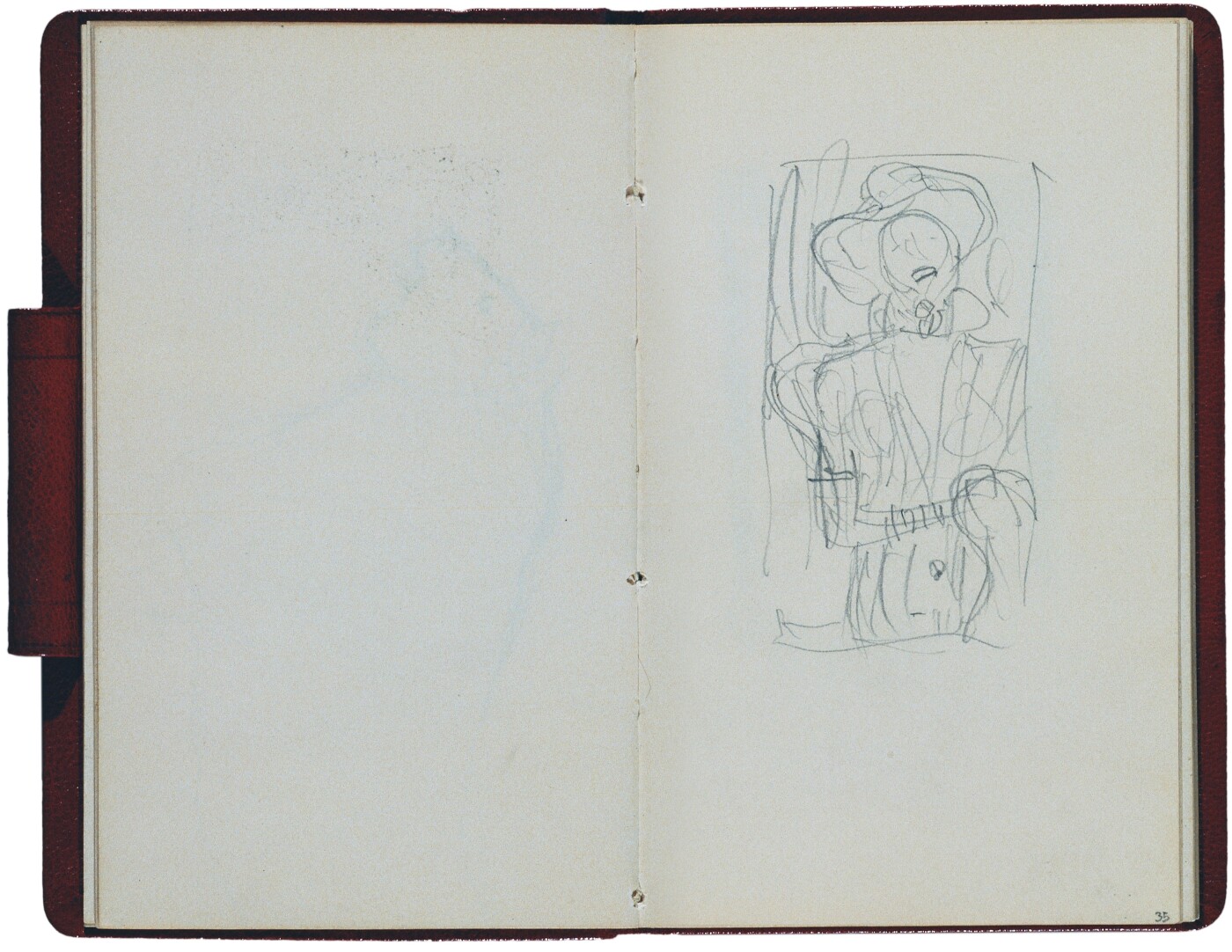 Gustav Klimt: Sonja Knips' red sketchbook, 1898, Österreichische Galerie Belvedere
Gustav Klimt: Sonja Knips' red sketchbook, 1898, Österreichische Galerie Belvedere
© Belvedere, Vienna -
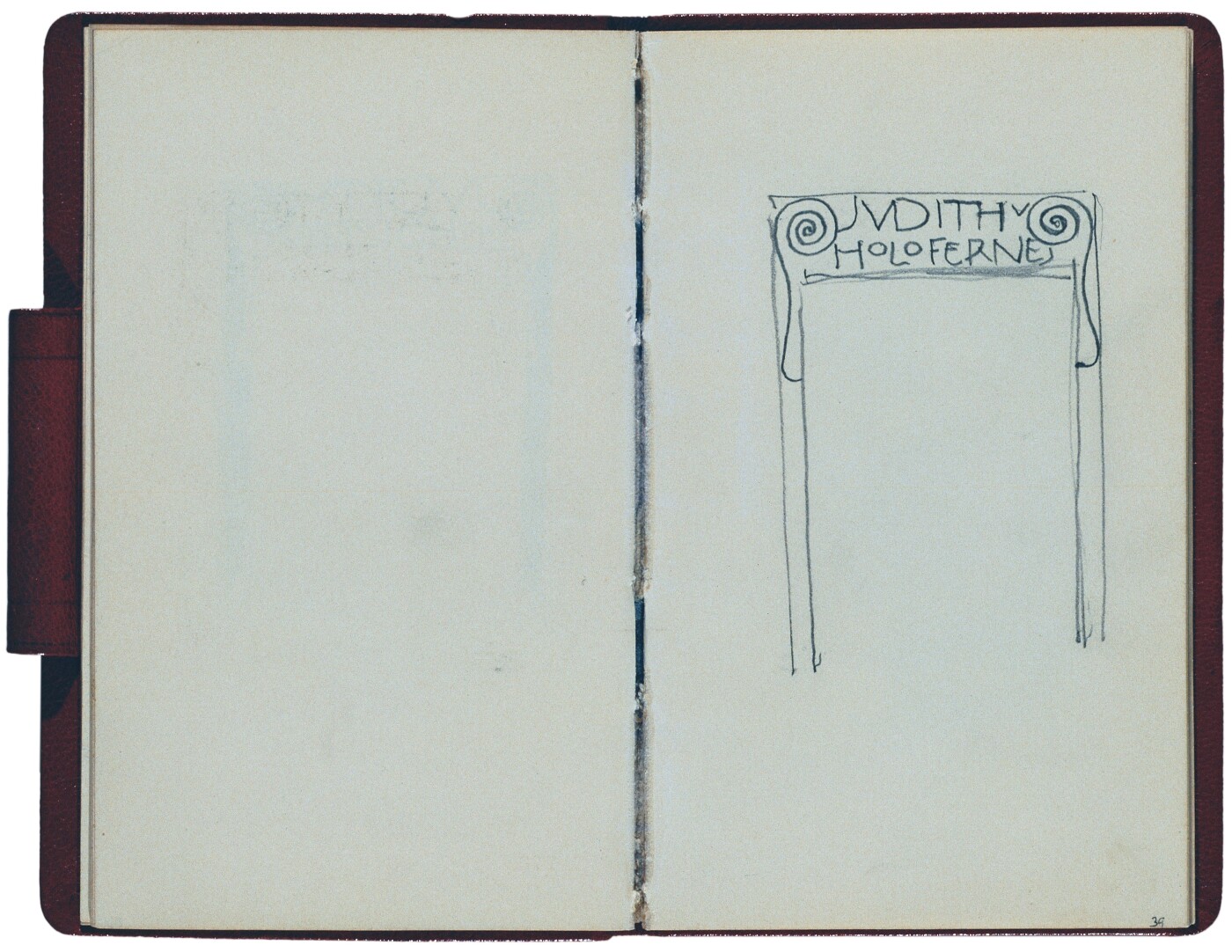 Gustav Klimt: Sonja Knips' red sketchbook, 1898, Österreichische Galerie Belvedere
Gustav Klimt: Sonja Knips' red sketchbook, 1898, Österreichische Galerie Belvedere
© Belvedere, Vienna
With his interpretation of Judith, Klimt followed in the footsteps of various writers and artists of the fin de siècle – above all Friedrich Hebbel – who associated their idea of the modern, sexual woman dominating men with the figure of Judith. With his Judith I, Klimt positioned himself stylistically in the midst of the international discourse around Symbolism and Décadence. One of his inspirations from the field of painting was certainly Franz Stuck’s series revolving around his work The Sin (c. 1893, Neue Pinakothek, Munich), in which Stuck establishes the principle of the seductive woman who, in her obvious sexuality, is also always surrounded by an air of danger. This is picked up by Klimt in his own interpretation of Judith.
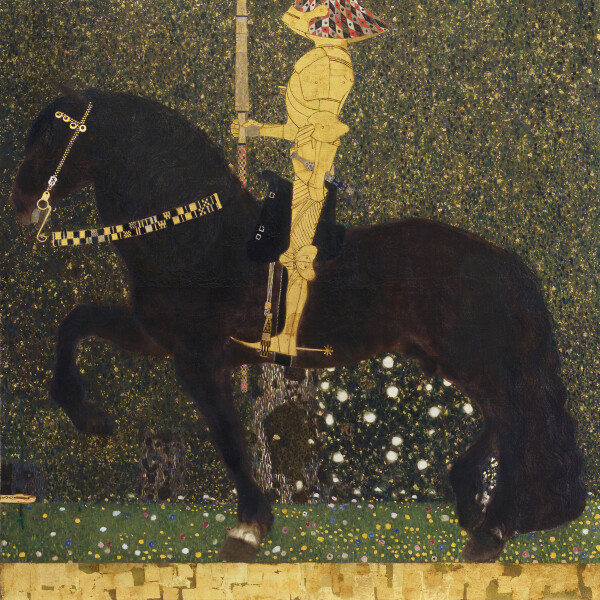
Gustav Klimt: The Golden Knight (Life a Battle), 1903, Aichi Prefectural Museum of Art
© Aichi Prefectural Museum of Art, Nagoya
The Golden Knight
The “Kollektiv-Ausstellung Gustav Klimt” [“Gustav Klimt Collective Exhibition”], which took place at the Secession from late 1903 to early 1904, presented another two new allegories by Klimt.
In contrast to the frequent depictions of women, men rarely appear as protagonists in Klimt’s oeuvre. In the painting Life Is a Battle, later referred to as The Golden Knight (1903, Aichi Prefectural Museum of Art, Nagoya), Klimt draws on the figure of the knight from The Beethoven Frieze (1901/02, Belvedere, Vienna), isolating it as a symbol of constant struggle. While the knight in the Beethoven Frieze fights as a “well-armed, strong man” against the monster Typhaeon and his horrible daughters in order to lead suffering humankind to music and happiness, the Golden Knight marches toward an uncertain future on the back of a giant black warhorse, past trees painted in the Pointillist style. The adder already hints at danger. Snakes play a major role in Klimt’s works from the Golden Period, appearing time and again in depictions such as Nuda Veritas (1899, Österreichisches Theatermuseum, Vienna) and shortly after 1900 in the Faculty Paintings of Medicine and Jurisprudence (1900–1907 and 1903–1907 resp., both destroyed by fire at Immendorf Castle in 1945).
Could Gustav Klimt, who throughout his life saw himself as a lone fighter, sole breadwinner of his family and illegitimate children, and dissatisfied artist caught in a ceaseless struggle with his works, have created an allegorical parable in this painting? It would be quite obvious to see in the knight the constantly troubled painter, fighting against the empty canvas and, following the program of the Beethoven Frieze, leading suffering humankind to art and happiness. However, there is no (historical) proof of this theory.
That the painting meant a creative struggle for Klimt himself is evidenced by the fact that the artist could not finish it in time for the beginning of the exhibition in 1903. The Viennese public was forced to wait almost two weeks before the master won the battle and completed the work. The industrialist Karl Wittgenstein, a passionate Klimt collector, subsequently acquired the painting for his collection.
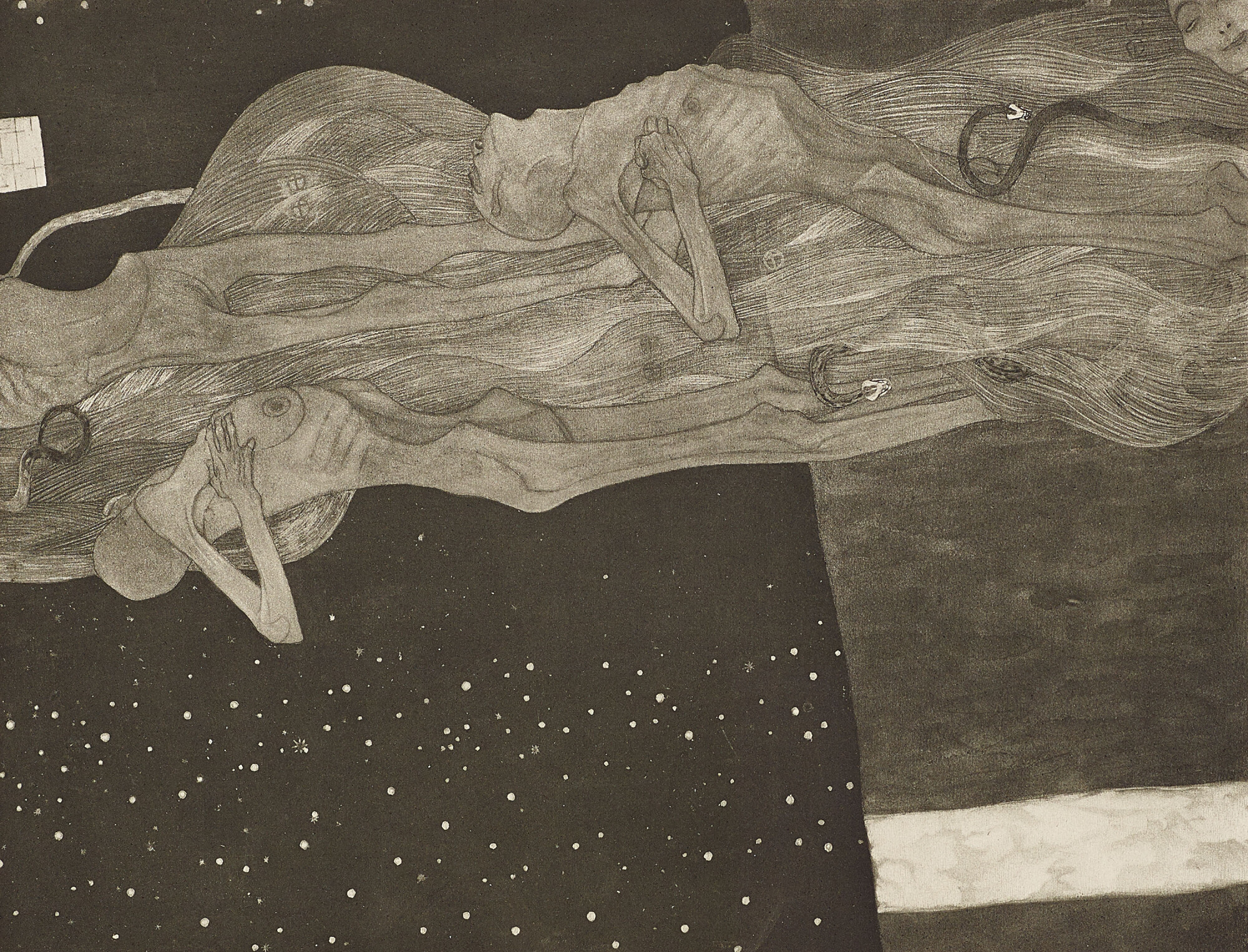
Gustav Klimt: From the Realm of Death (Stream of the Dead), 1903, Verbleib unbekannt
© Klimt Foundation, Vienna
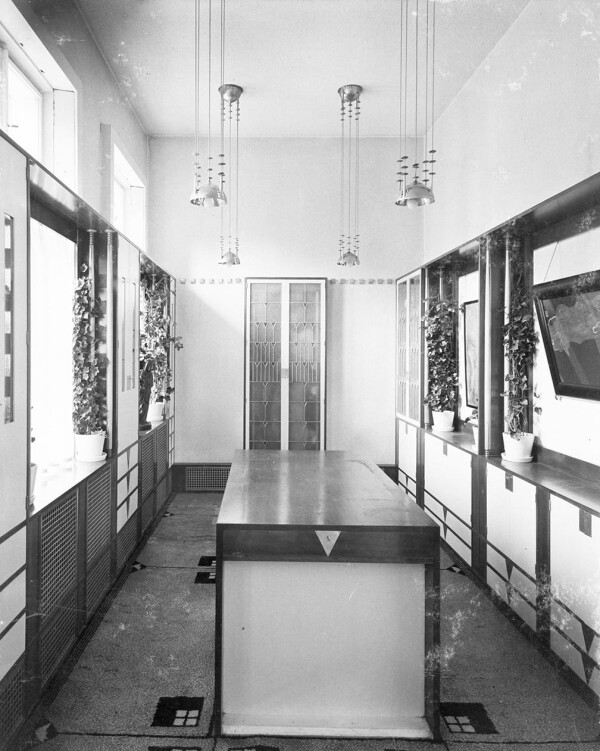
View into Villa Waerndorfer, 1903/04, MAK - Museum für angewandte Kunst, Archiv der Wiener Werkstätte
© MAK
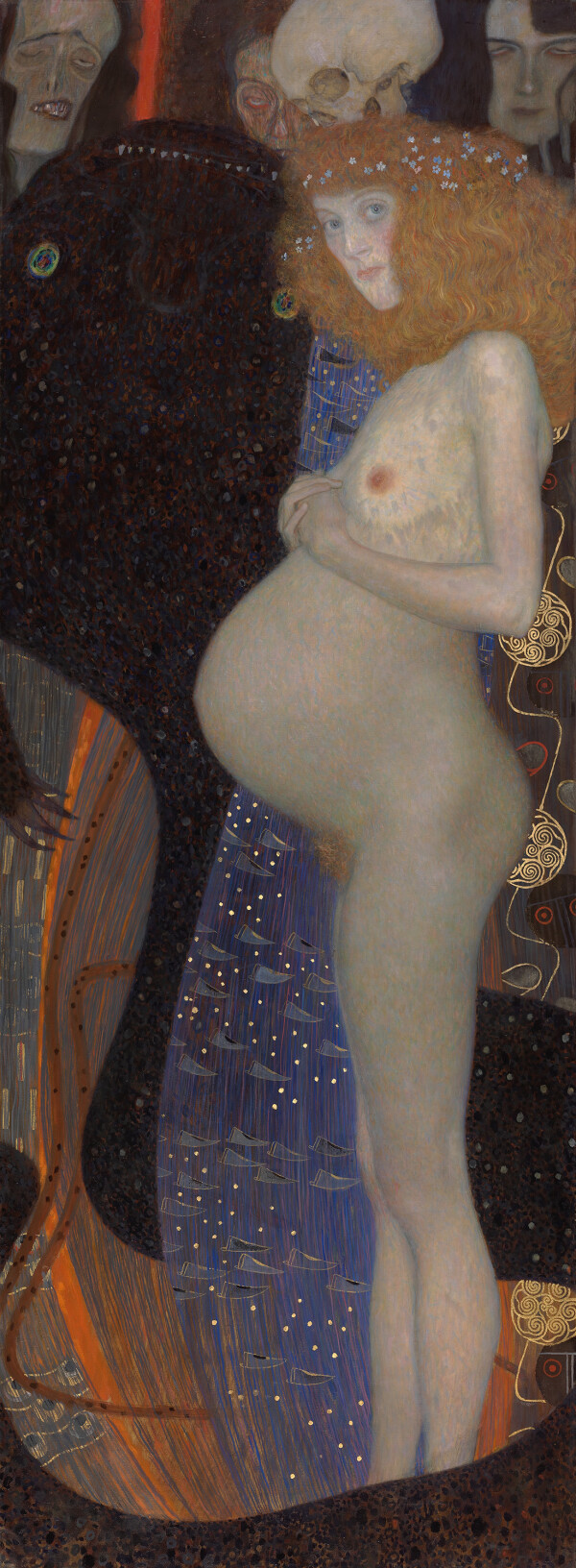
Gustav Klimt: Hope I, 1903/04, National Gallery of Canada
© NGC
From the Realm of Death
The snakes mentioned above also play a role in Klimt’s first allegory dealing with the theme of death, From the Realm of Death (Stream of the Dead) (1903, whereabouts unknown, considered lost since the end of the war in 1945). The vision of the afterlife, in which emaciated human bodies seem to be floating weightlessly in the universe, has unfortunately only survived in the form of a black-and-white reproduction. However, the painting can be partially reconstructed in its color scheme thanks to a description by art critic Ludwig Hevesi. White scarfs featuring an irregular pattern of green double squares are said to have connected the dead, who are said to have spanned the surface of the picture like the “Milky Way across the night sky,” with dark blue vipers with golden heads meandering between them. Both the background and the frame may have suggested an infinite black void, now and then interspersed with colored stars. In terms of the structure of the painting, with its stream-like flow of arched bodies in the throng of an undulating, billowing ornamental band, Klimt formally harked back to Moving Water (1898, private collection) and Will-o’-the-Wisp (1903, private collection).
The first explorations of life and death had already taken place in the Faculty Painting of Medicine (1900–1907, destroyed by fire at Immendorf Castle in 1945). Klimt drew on anatomical sketches for the realistic depiction of the decomposed bodies. They were probably the same he had already used for said Faculty Painting. According to Hevesi, he had gained access to his lifeless models through his physician friend, Emil Zuckerkandl:
“How many hours he spent in Prof. Zuckerkandl’s dissecting room this summer, eagerly drawing in order to distill this pale, rigid play of colors and lines from all this death.”
It was precisely this ruthlessly realistic depiction of death, entirely devoid of idealization or abstraction, that struck a chord with viewers and led to criticism and rejection. Fritz Waerndorfer eventually acquired the painting and kept it at his villa in Vienna’s Cottage Quarter.
Hope I
In the painting Hope I (1903/04, National Gallery of Canada, Ottawa) Klimt once again dealt with the theme of death. A naked pregnant woman – who is thus proverbially “expecting” – is shown standing in the foreground of the composition as a luminous figure. A personification of death in the form of a skeleton, emaciated faces, and a black shadowy figure loom menacingly in the background. The woman, however, who puts her hands protectively over her belly, looks at the viewer and is not aware of the imminent danger. Again, Klimt combines here a depiction of a woman with the element of threat. However, since Judith I, the connotations of the two terms have changed fundamentally. The woman has transformed from femme fatale to an almost sacred and innocent maternal figure. Her nakedness no longer radiates seduction but exhibits a childlike vulnerability. The symbols of danger are no longer meant as a warning directed at the viewer, but rather pose a threat to the protagonist. This change in Klimt’s image of women was probably due to the death of his son Otto Zimmermann in 1902, when he was not yet a year old.
Klimt actually wished to present Hope I in mid-November 1903 as part of the “Gustav Klimt Collective Exhibition.” However, Berta Zuckerkandl reported that Hartel, the Minister of Education, feared that the depiction of a naked pregnant woman might cause another scandal, as had happened with the Faculty Paintings earlier. It was at his request that Klimt withdrew the painting from the exhibition. When Hans Koppel saw the work in Klimt’s studio in November 1903, he referred to it as “Klimt’s most recent painting,” which would have been completed except for a few minor details. The painter still intended to change the background from landscape to patterned carpet and add “characteristic heads clarifying the thoughts behind the work.” In 1904, Gustav Klimt revised the composition and then sold the picture to Fritz Waerndorfer. The latter asked Koloman Moser to design a piece of furniture especially for the purpose of protecting the scandalous work from unwanted glances. On 25 November 1905, Ludwig Hevesi reported on the occasion of a visit to Villa Waerndorfer:
“That evening we were sitting together for a long time, looking at the gloomy works of art Herr Wärndorfer collects. Over a large picture, a double-wing door is hermetically closed to shield off any profane eye. This picture is Klimt’s famous or, rather, notorious ‘Hope’ – said young woman expecting in the most interesting ways, whom the artist dared to paint without clothes. One of his masterpieces. […] In the Klimt exhibition two years ago the picture could not be shown, as some superior authority prevented it. Now it has become a private matter at Waerndorfer’s house.”
Literature and sources
- Hans Koppel: Bei Gustav Klimt, in: Die Zeit, 15.11.1903, S. 4-5.
- Berta Zuckerkandl (Hg.): Zeitkunst. Wien 1901–1907, Vienna 1908.
- Franz Servaes: Klimt-Ausstellung (Sezession), in: Neue Freie Presse (Abendausgabe), 23.11.1903, S. 1-4.
- Ludwig Hevesi: Weiteres zur Klimt-Ausstellung. 21. November 1903, in: Acht Jahre Sezession (März 1897–Juni 1905). Kritik – Polemik – Chronik, Vienna 1906, S. 448–452.
- Joris-Karl Huysmans: Gegen den Strich, Bremen 1991.
- Neues Wiener Tagblatt, 16.02.1902, S. 12.
- Johannes Dobai: Gustav Klimt’s Hope I, in: National Gallery of Canada Bulletin, Nummer 71 (1971).
- Alice Strobl: Klimts Irrlichter. Phantombild eines verschollenen Gemäldes, in: Klimt-Studien. Mitteilungen der Österreichischen Galerie, Heft 66-67 (1978/79), S. 119–145.
- Agnes Husslein-Arco, Alfred Weidinger (Hg.): Gustav Klimt 150 Jahre, Ausst.-Kat., Upper Belvedere (Vienna), 13.07.2012–27.01.2013, Vienna 2012.
- Alfred Weidinger: Les Belles Dames. Gedanken zum Frauenbildnis bei den Präraffaeliten und Gustav Klimt, in: Agnes Husslein-Arco, Alfred Weidinger (Hg.): Schlafende Schönheit. Meisterwerke viktorianischer Malerei aus dem Museo de Arte de Ponce, Ausst.-Kat., Lower Belvedere (Vienna), 14.06.2010–03.10.2010, Vienna 2010, S. 103-110.
- N. N.: Theater- und Kunstnachrichten, in: Neue Freie Presse (Morgenausgabe), 04.04.1901, S. 7.
- N. N.: X. Ausstellung der Vereinigung vom 15. März bis 12. Mai 1901. Liste der verkauften Werke, in: Vereinigung bildender KünstlerInnen Wiener Secession (Hg.): Ver Sacrum. Mitteilungen der Vereinigung bildender Künstler Österreichs, 4. Jg., Heft 12 (1901), S. 209.
- Tobias G. Natter (Hg.): Gustav Klimt. Sämtliche Gemälde, Vienna 2017.
- Fritz von Ostini: Die VIII. Internationale Kunstausstellung im kgl. Glaspalast zu München, in: Die Kunst. Monatshefte für freie und angewandte Kunst, 16. Jg., Band 3 (1901).
- Ludwig Hevesi: Haus Wärndorfer, in: Altkunst – Neukunst, Vienna 1909, S. 221–227.
Mystic Underwater Worlds
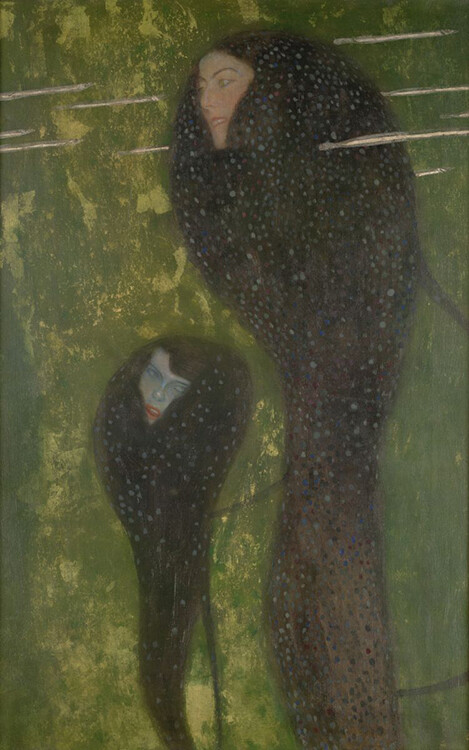
Water Nymphs (Silverfish), 1902/03, The Albertina Museum
© The ALBERTINA Museum, Vienna
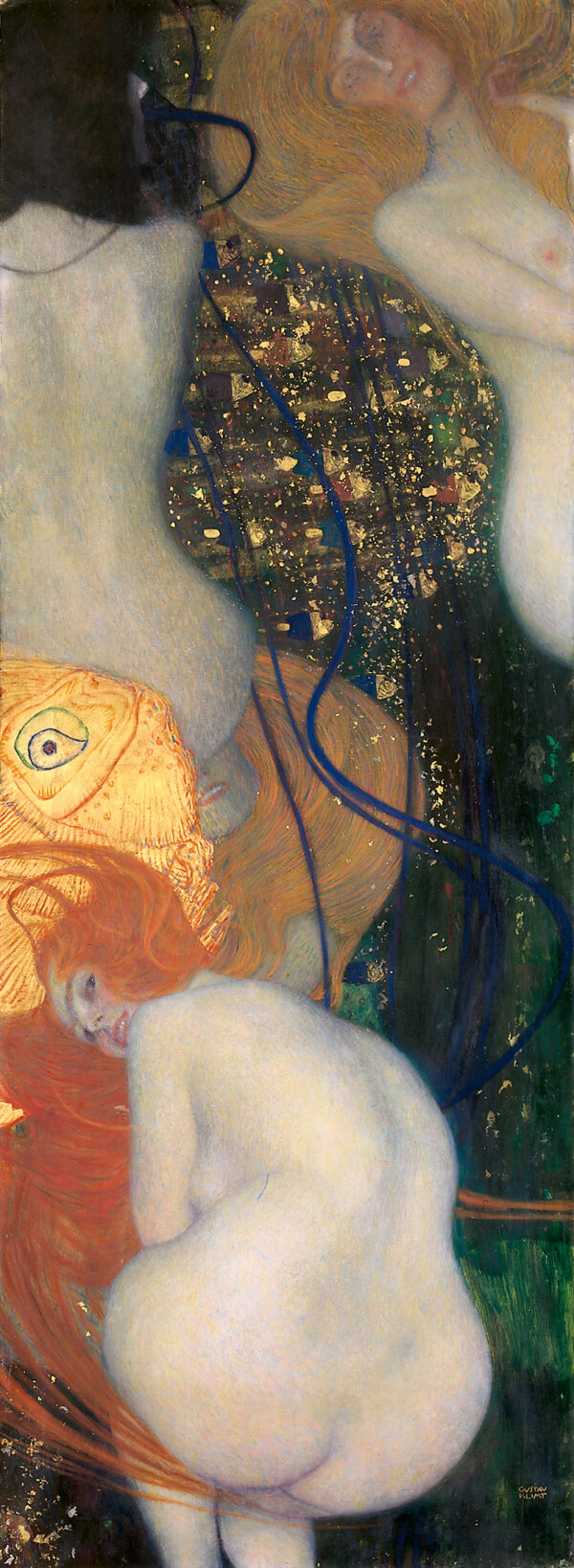
Gustav Klimt: Goldfish, 1901/02, Kunstmuseum Solothurn, Dübi-Müller-Stiftung
© Kunstmuseum Solothurn
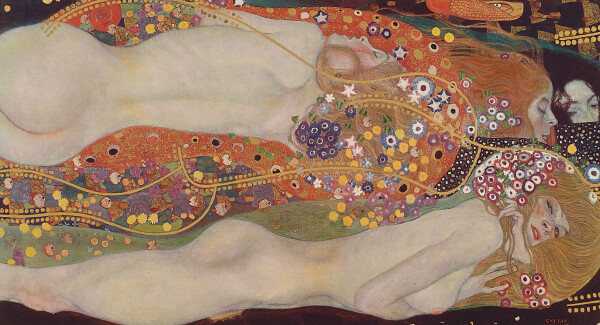
Gustav Klimt: Water Snakes II, 1904, private collection
© Klimt Foundation, Vienna
Klimt’s output between 1901 and 1903 is characterized by such fantastic and mystical figures as mermaids, will-o’-the-wisps, and whimsical aquatic creatures.
“He populates the mysterious depths of water with the most terrific, most seductive mermaid magic. Goldfish, the Wave, and now, as the latest caprice, the chromatically delightful little picture of the ‘Water Nymphs’ are full of dewily sparkling poetry. A ‘Daphne’ and the ‘Will-o’-the-Wisps’ are also among these absolutely fantastic creations.”
In 1903/04, a contributor to Die Kunst für Alle found these words to describe said group of Klimt’s paintings, which deals primarily with fantastic beings from the aquatic realm. Klimt’s images of erotically charged female aquatic creatures and light phenomena rank among his most mysterious paintings. In four works – Water Nymphs (Silverfish) (1902/03, Albertina, Vienna), Goldfish (1901/02, Kunstmuseum Solothurn, Dübi-Müller-Stiftung), Will-o’-the-Wisp (1903, private collection), and Daphne (1902/03, private collection) – he revisited the theme of floating, mystical underwater beings he had first explored in Moving Water (1898, private collection).
Scholars consider all of these images as evidence of woman’s misogynistic image prevalent at the turn of the century. Many thought that, women, being creatures of nature, developed an erotic attraction that could be dangerous for men. Gustav Klimt translated this idea into images of teasing, mostly naked women with long hair floating in the water. Swimming with goldfish or silverfish, they drift in dark green waters, existing far removed from all cultural norm.
While Klimt mostly developed his compositions from a multitude of motion studies of anonymous models, individual women from reputable bourgeois backgrounds also made their way into these dubious and somber compositions. Thus, upon closer inspection of Water Nymphs, one can recognize in the face of one of the two black, tadpole-like creatures the features of Rose von Rosthorn-Friedmann, whose society portrait Klimt had completed in 1900/01. The art critic Ludwig Hevesi had already noticed their resemblance:
“But I would rather call them tadpoles, all dotted with matte-colored trout spots, and charming, quiet, lurking mermaid faces. One is truly related to one of his best female portraits. How the painter understood to insert these faces in such a self-understood fashion is quite a piece of natural humor.”
Whether the elegant lady knew about her role as a model, or whether Klimt decided to use the sketches for her portrait without her consent can unfortunately not be verified.
It was above all the painting Goldfish, compositionally reminiscent of the human tower in the Faculty Painting of Philosophy (1900–1907, destroyed by fire at Immendorf Castle in 1945) that caused quite a stir. Much more than a mere display of unbridled femininity, Klimt here deliberately directed a provocative message at the critics of his Faculty Paintings, aptly summarized by Ludwig Abels as follows:
“[...] and in a jaunty, brilliantly painted fantasy called ‘Goldfish,’ he ostentatiously turned his back on any influence through public opinion.”
An exception among Klimt’s paintings from the realm of mythology and aquatic life is Daphne. Conceived more as a lady’s portrait than as a crowded and dynamic scene, the painting only very subtly reveals the protagonist’s identity. While the meadow landscape represents Daphne’s flight ashore from Apollo, implied here only by the title, since there is no trace of the god, the cloth fluttering behind her, with its blue color and wavy pattern, resembles almost a river meandering away from the landscape. Here we also find the clue to the identity of the red-haired female figure as a water nymph. The dreamily closed eyes and the slightly parted lips of her face, placed directly in front of the blue expanse, almost seem to betray Daphne’s longing for the water, where she would once again be able to drift carelessly and playfully with the undulating figures in Will-o'-the-Wisp and Moving Water. In the following years, Klimt would continue to develop the theme of the underwater world with such paintings as Water Snakes I (Parchment) (1904, reworked before 1907, Belvedere, Vienna) and Water Snakes II (1904, reworked before 1908, private collection), using materials and techniques from the decorative arts.
Literature and sources
- Alfred Weidinger: Les Belles Dames. Gedanken zum Frauenbildnis bei den Präraffaeliten und Gustav Klimt, in: Agnes Husslein-Arco, Alfred Weidinger (Hg.): Schlafende Schönheit. Meisterwerke viktorianischer Malerei aus dem Museo de Arte de Ponce, Ausst.-Kat., Lower Belvedere (Vienna), 14.06.2010–03.10.2010, Vienna 2010, S. 103-110.
- Agnes Husslein-Arco, Alfred Weidinger (Hg.): Gustav Klimt 150 Jahre, Ausst.-Kat., Upper Belvedere (Vienna), 13.07.2012–27.01.2013, Vienna 2012.
- Dr. Ludwig Abels: Ein Wiener Kunst-Jahr, in: Deutsche Kunst und Dekoration, Band 10 (1902), S. 463-474, S. 464.
- Die Kunst für Alle. Malerei, Plastik, Graphik, Architektur, 19. Jg. (1903/04), S. 163.
- Tobias G. Natter (Hg.): Gustav Klimt. Sämtliche Gemälde, Vienna 2017.
- Ludwig Hevesi: Weiteres zur Klimt-Ausstellung. 21. November 1903, in: Acht Jahre Sezession (März 1897–Juni 1905). Kritik – Polemik – Chronik, Vienna 1906, S. 448–452.
- Alice Strobl: Klimts Irrlichter. Phantombild eines verschollenen Gemäldes, in: Klimt-Studien. Mitteilungen der Österreichischen Galerie, Heft 66-67 (1978/79), S. 119–145.
The Beethoven Frieze
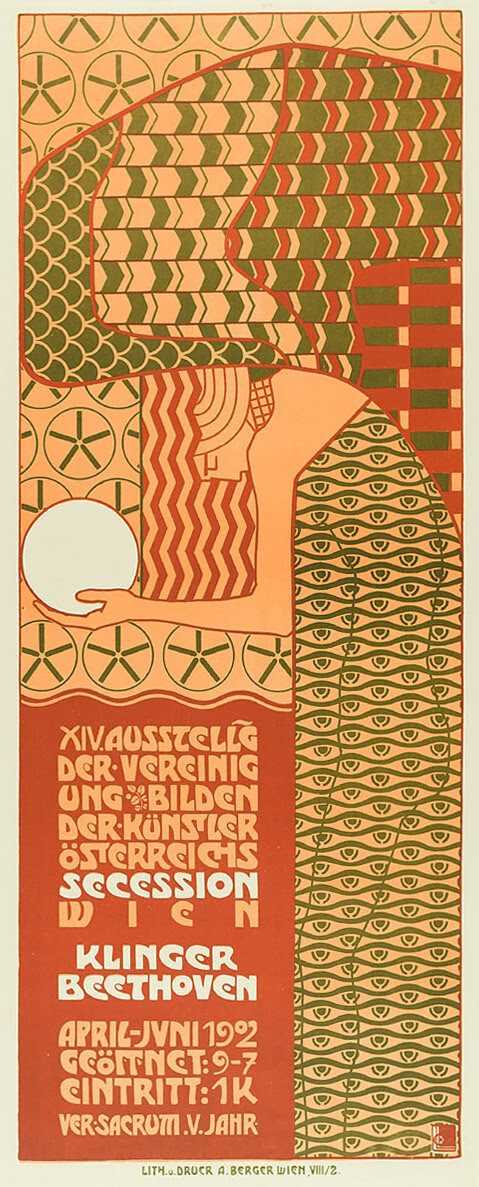
Alfred Roller: Poster of the XIV Secession Exhibition (Klinger-Beethoven), 1902, Museum für Kunst und Gewerbe Hamburg (MK&G)
© Museum für Kunst und Gewerbe Hamburg
On the occasion of the presentation of Max Klinger’s monumental Beethoven statue at the Vienna Secession in 1902, Gustav Klimt conceived the so-called Beethoven Frieze. Painting directly onto three exhibition walls using casein paints, the artist intended his work to lead up to the central sculpture thematically, thus contributing with the frieze to what was to become a Gesamtkunstwerk or universal work of art. Although Ludwig van Beethoven is mentioned in the title, the composer is not depicted.
From 15 April to 27 June 1902, 21 male artists and one female artist presented a universal work of art around Max Klinger’s huge sculpture of the composer Ludwig van Beethoven. As Gustav Klimt’s monumental contribution to the “XIV. Ausstellung der Vereinigung bildender Künstler Österreichs Secession Wien” [“14th Exhibition of the Association of Austria Artists Vienna Secession”], also referred to as “Beethoven Exhibition,” the Beethoven Frieze (1901/02, Belvedere, Vienna, on permanent loan to the Vienna Secession) extends over a length of 34.14 meters and a height of 2.15 meters.
Beethoven, having died in Vienna in 1827, had risen to the status of unattainable genius in the perception of Klimt’s contemporaries. Max Klinger, a sculptor from Leipzig, sought to do justice to this perception when he painstakingly created a statue of the revered composer over a period of 20 years. The statue of Beethoven was finally completed in the spring of 1902, and the Secessionists successfully negotiated that the first presentation of the work should take place at their venue in Vienna.
Exhibition Architecture – A Worthy Framework for Beethoven
To mark the 75th anniversary of Beethoven’s death on 26 March 1902, the Vienna Secession decided to dedicate a theme exhibition to the composer. Gathering around Josef Hoffmann, who was responsible for the exhibition architecture, the participants conceived a worthy presentation, with Klinger’s monument at the center. By exploring the possibilities of wall-mounted solutions and arranging their works around the composer’s statue, the artists jointly created an almost sacred art space, a site for holy “temple art.”
The preparatory works began in the summer of 1901. The participating artists included, among others, Alfred Roller, Josef Maria Auchentaller, Ferdinand Andri, Emil Orlik, and Gustav Klimt. Josef Hoffmann divided the Vienna Secession’s exhibition hall into three rooms, separating the left aisle through a windowed wall. This enabled Gustav Klimt to design a tripartite composition comprising two long side walls (13.92 m each) and a shorter rear wall (6.3 m) at the center.
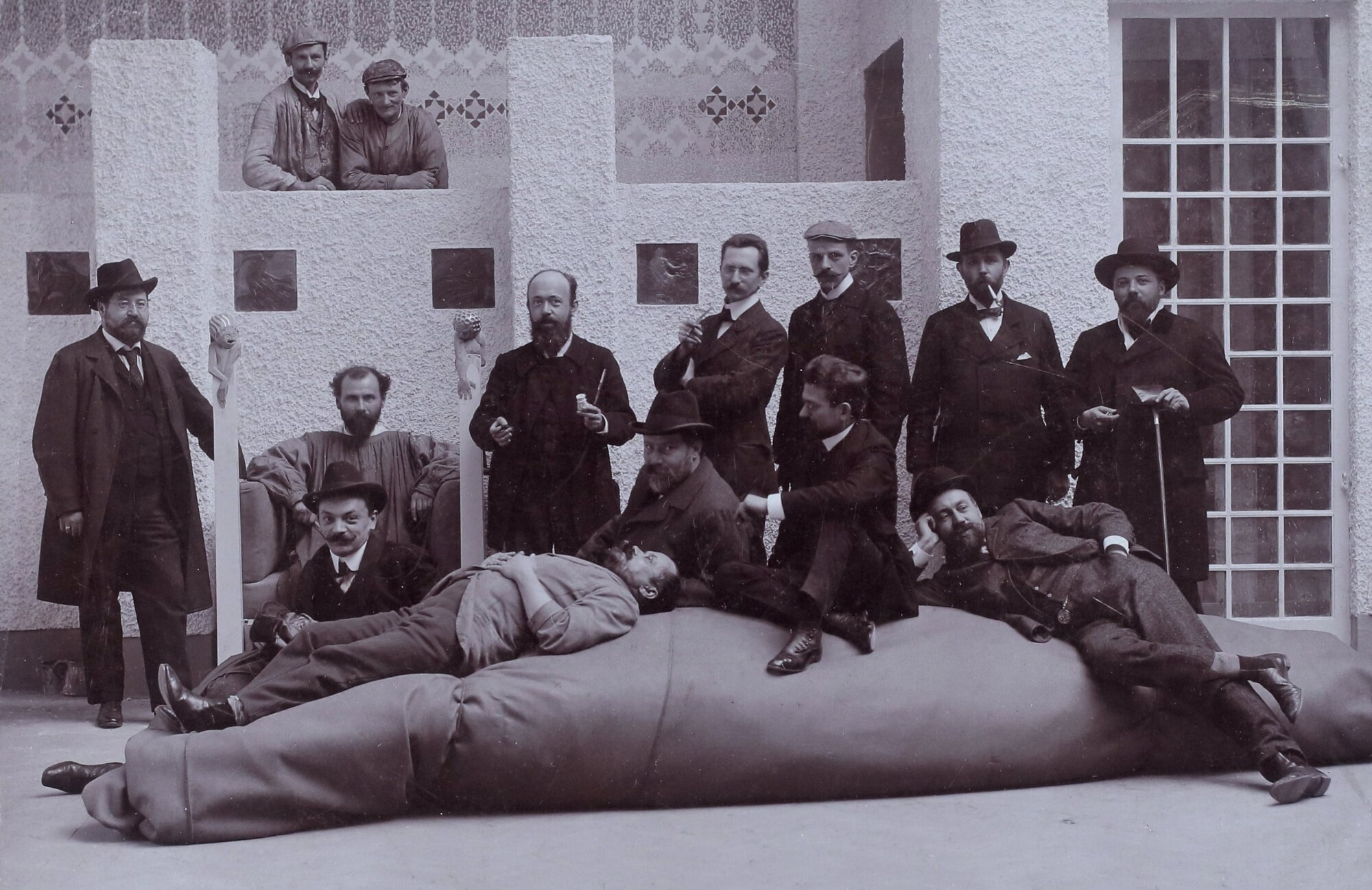
Moriz Nähr: Gustav Klimt with the artists participating in the 14th Exhibition of the Secession, April 1902, Klimt Foundation
© Klimt Foundation, Vienna
At the Secession’s Beethoven exhibition, the painter Klimt showed that he could also create groundbreaking works of art outside his familiar medium. Since the summer of 1901 he had been working on a piece that would fuse painting, sculpture, and arts and crafts to create a monumental overall composition. While he initially prepared the composition through studies, correspondence proves that Klimt spent more time at the Secession in the late summer and fall of 1901 in order to transfer his work directly to the wall on site. Thus he wrote to Maria Zimmermann toward early October:
“I am not working at the Secession building as such yet – today, around noon, I hope to finally make it there – to begin with the actual work on the wall [...]”
By 12 November 1901 he had completed the work:
“My last day of work is tomorrow in the morning – I am glad [...]. If you need money earlier, send me a pneumatic letter card to the Secession -”
A Multimedia Work of Art
The accompanying text in the 1902 exhibition catalog briefly mentions the materials used by Gustav Klimt: “Casein paints, applied stucco, gilding,” is what it says. However, a large-scale restoration campaign in the 1980s managed to identify many more materials.
Klimt first drew the figures in graphite onto the dry plaster ground and then executed the colored areas using water-soluble casein paint. Moreover, he applied cut opalescent glass cabochons, cut and metal-mounted transparent colored glass, mirror fragments, mother-of-pearl buttons, and hollow brass rings. Thanks to the casein paint, which is matt after it has dried, the artist could intensify the glow of gold and silver. Klimt achieved the flatness of the gilded areas with the aid of oil gilding. It is interesting that Klimt used aluminum foil for the knight’s sword. This produced a silver tone without running the risk of oxidation. In a final step, the artist used a pencil to draw over the gilding, or he glazed gilded areas in colors. What is remarkable about the formal solution of the Beethoven Frieze is that there are many areas of “blank” wall shining through, while the narrative is heavily rhythmized.
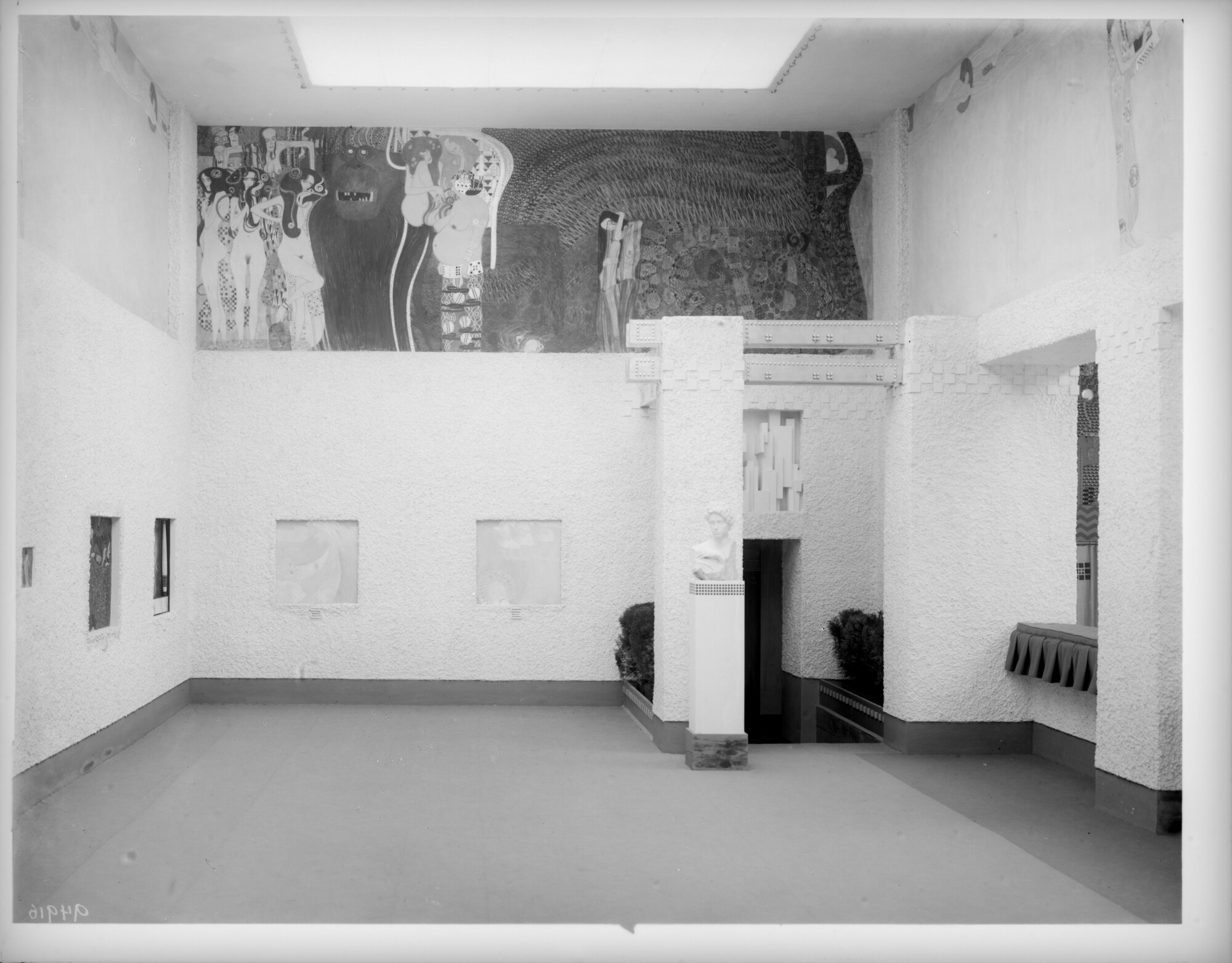
Moriz Nähr: Insight into the XIV Secession Exhibition, April 1902 - June 1902, Österreichische Nationalbibliothek, Bildarchiv und Grafiksammlung
© Picture Archives and Graphics Department, Austrian National Library
This Kiss to the Whole World
A glance into the exhibition catalog also provides information about the figures conceived by Klimt, whose symbolic content would be difficult to decipher without the contribution of an author whose name remains unknown. Thus, the flying or floating genii in long white robes represent the “Yearning for Happiness.” This “Train of Yearning” connects three quarters of the composition. On the left wall, the Knight in Golden Armor stands out, who is supposed to represent “Armored Strength.” From his head spring Ambition and Compassion as female personifications. Ambition holds a laurel wreath in her hands, while Compassion is depicted folding her hands. A poor family is shown kneeling behind the knight. Pleading for help, it stands for “Weak Mankind,” as is pointed out in the catalog. After this introduction, the “Hostile Forces” follow on the narrow wall, with the monster Typhoeus, half gorilla, half octopus, at center, carrying two human skulls in his paw.
Around the Typhoeus, Klimt has grouped the three Gorgons on the left, with “Sickness, Death, and Madness” above them and “Lust, Lechery, and Intemperance” to the monster’s right. The seated woman embracing herself represents “Gnawing Grief.” In the upper right corner, “Yearning for Happiness” reappears and leads up to “Poetry,” which Klimt has depicted in the form of a woman with a kithara.
-
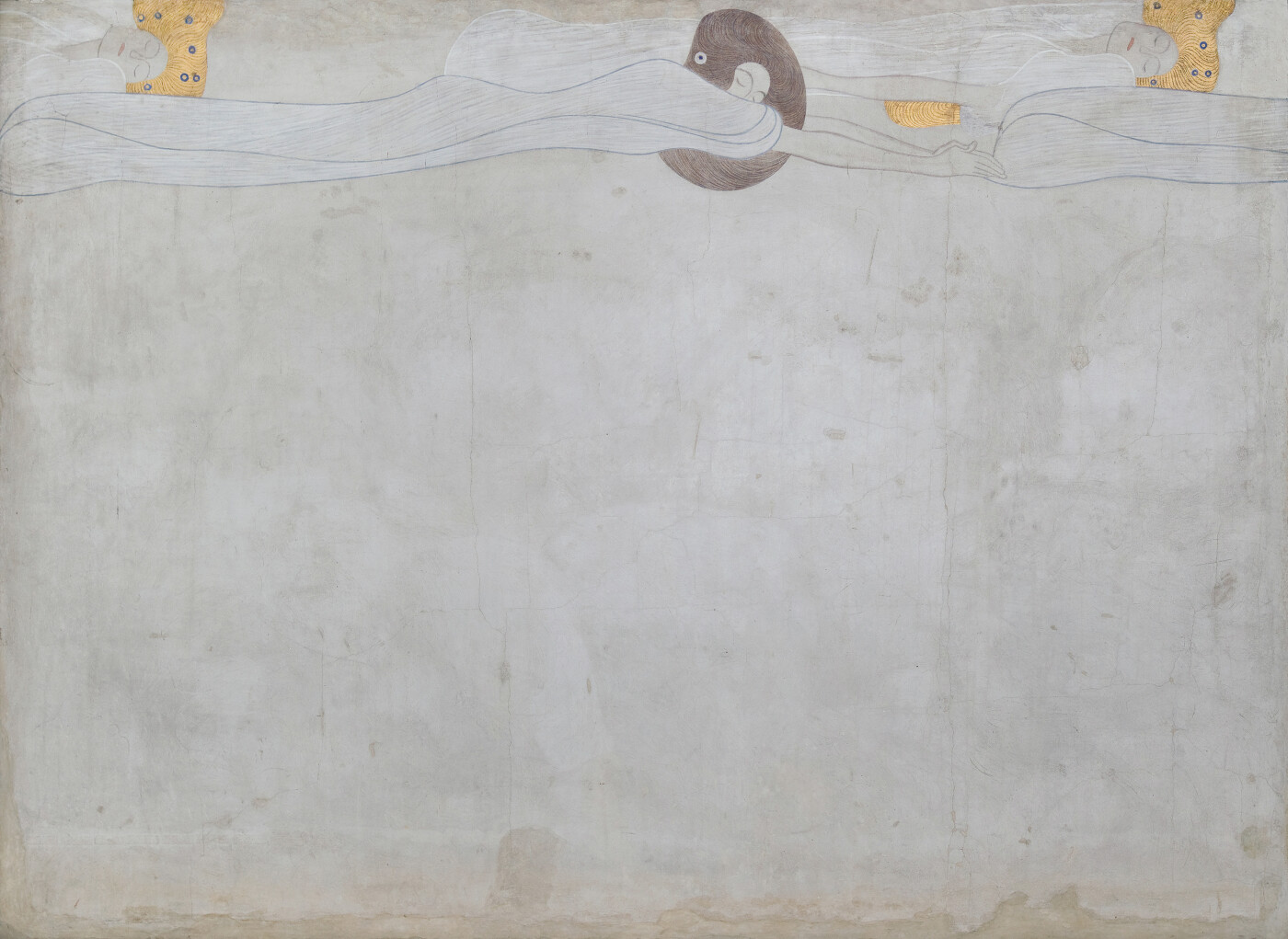 Gustav Klimt: The Beethoven Frieze (The Longing for Happiness), 1901/02, Österreichische Galerie Belvedere
Gustav Klimt: The Beethoven Frieze (The Longing for Happiness), 1901/02, Österreichische Galerie Belvedere
© Belvedere, Vienna -
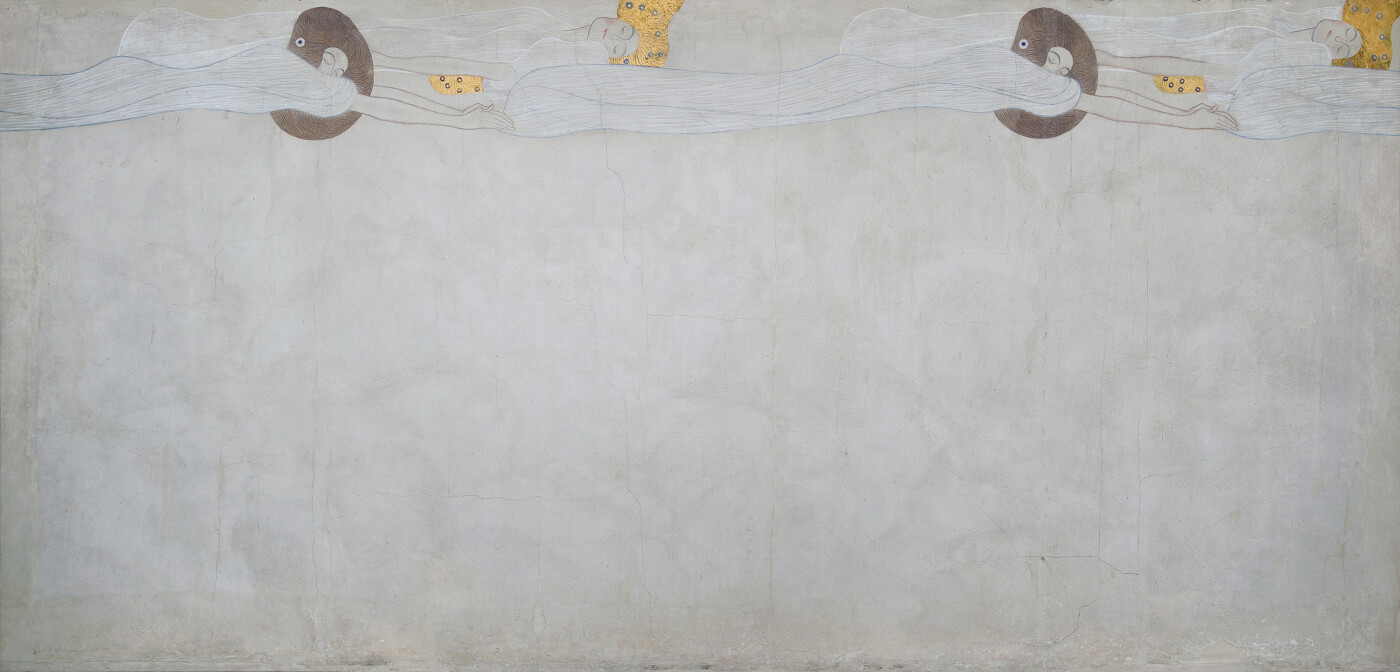 Gustav Klimt: The Beethoven Frieze (The Longing for Happiness), 1901/02, Österreichische Galerie Belvedere
Gustav Klimt: The Beethoven Frieze (The Longing for Happiness), 1901/02, Österreichische Galerie Belvedere
© Belvedere, Vienna -
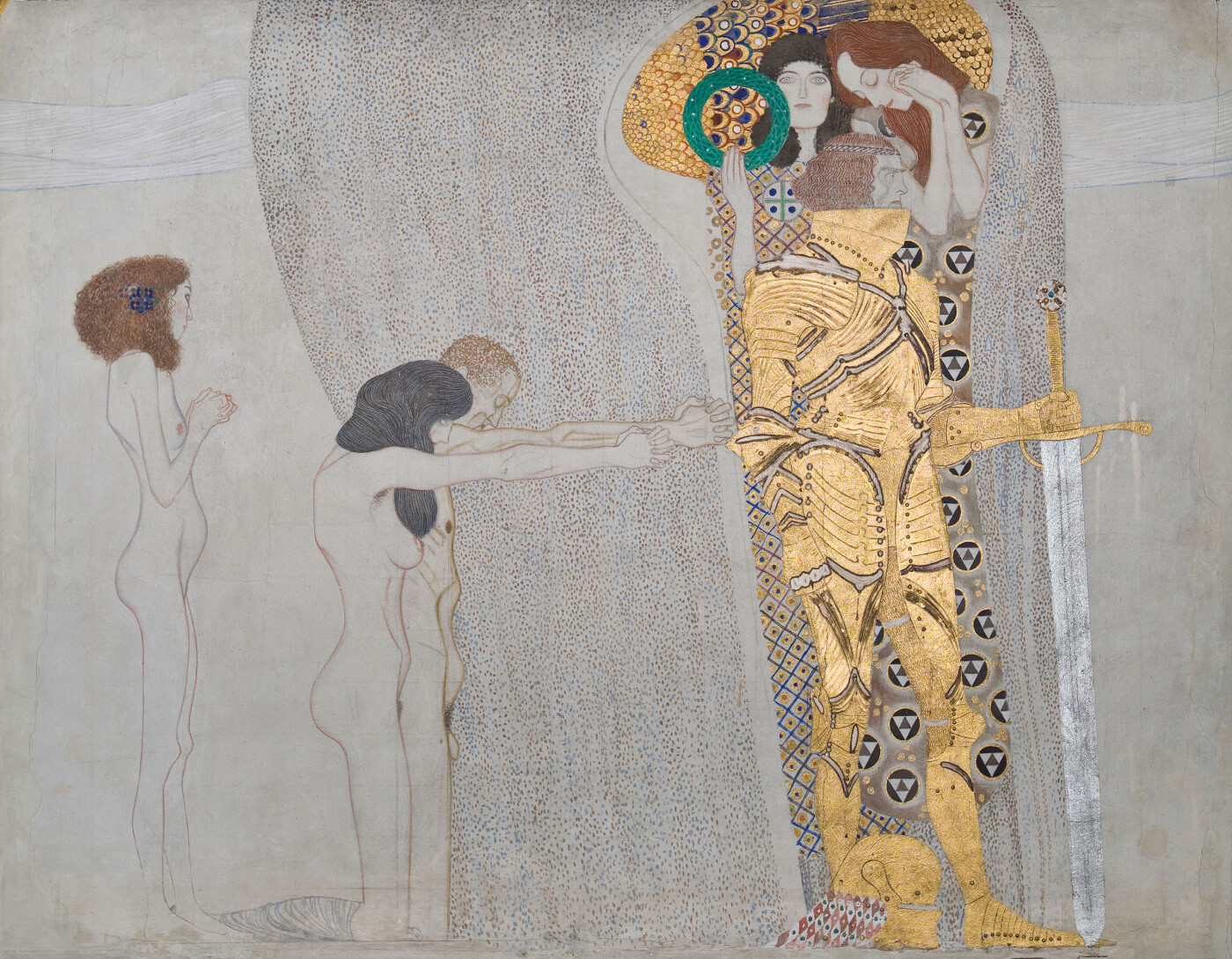 Gustav Klimt: The Beethoven Frieze (The Suffering of Weak Mankind, The Well-Armed Strongman), 1901/02, Österreichische Galerie Belvedere
Gustav Klimt: The Beethoven Frieze (The Suffering of Weak Mankind, The Well-Armed Strongman), 1901/02, Österreichische Galerie Belvedere
© Belvedere, Vienna -
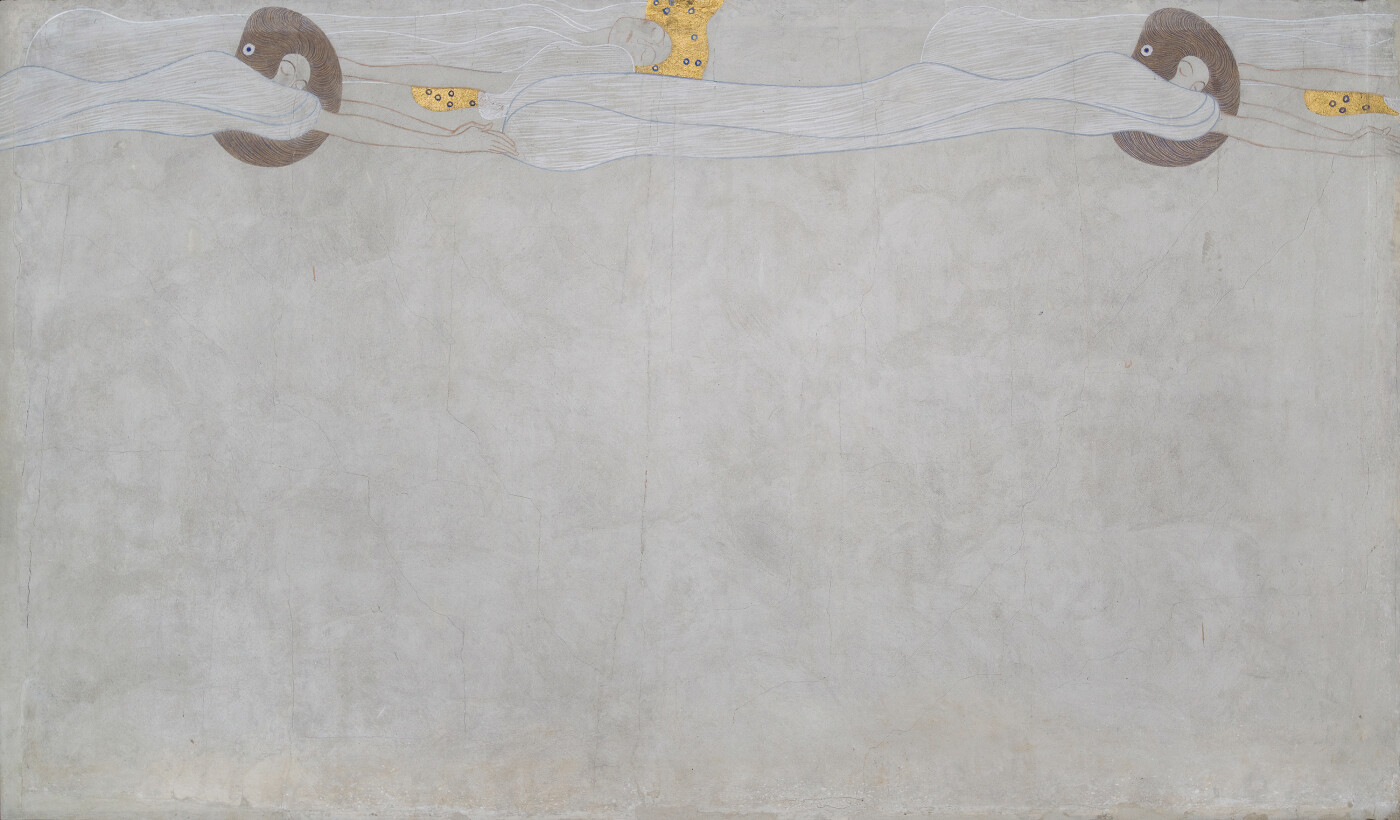 Gustav Klimt: The Beethoven Frieze (The Longing for Happiness), 1901/02, Österreichische Galerie Belvedere
Gustav Klimt: The Beethoven Frieze (The Longing for Happiness), 1901/02, Österreichische Galerie Belvedere
© Belvedere, Vienna -
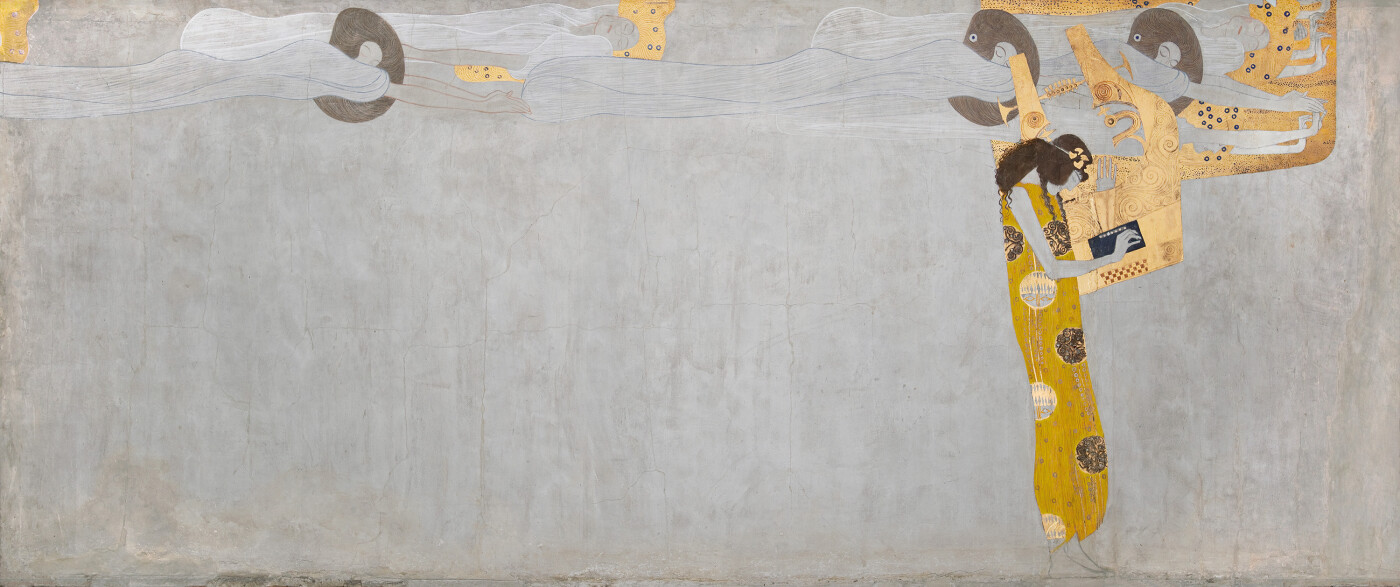 Gustav Klimt: The Beethoven Frieze (The Longing for Happiness is Satisfied by Poetry), 1901/02, Österreichische Galerie Belvedere
Gustav Klimt: The Beethoven Frieze (The Longing for Happiness is Satisfied by Poetry), 1901/02, Österreichische Galerie Belvedere
© Belvedere, Vienna -
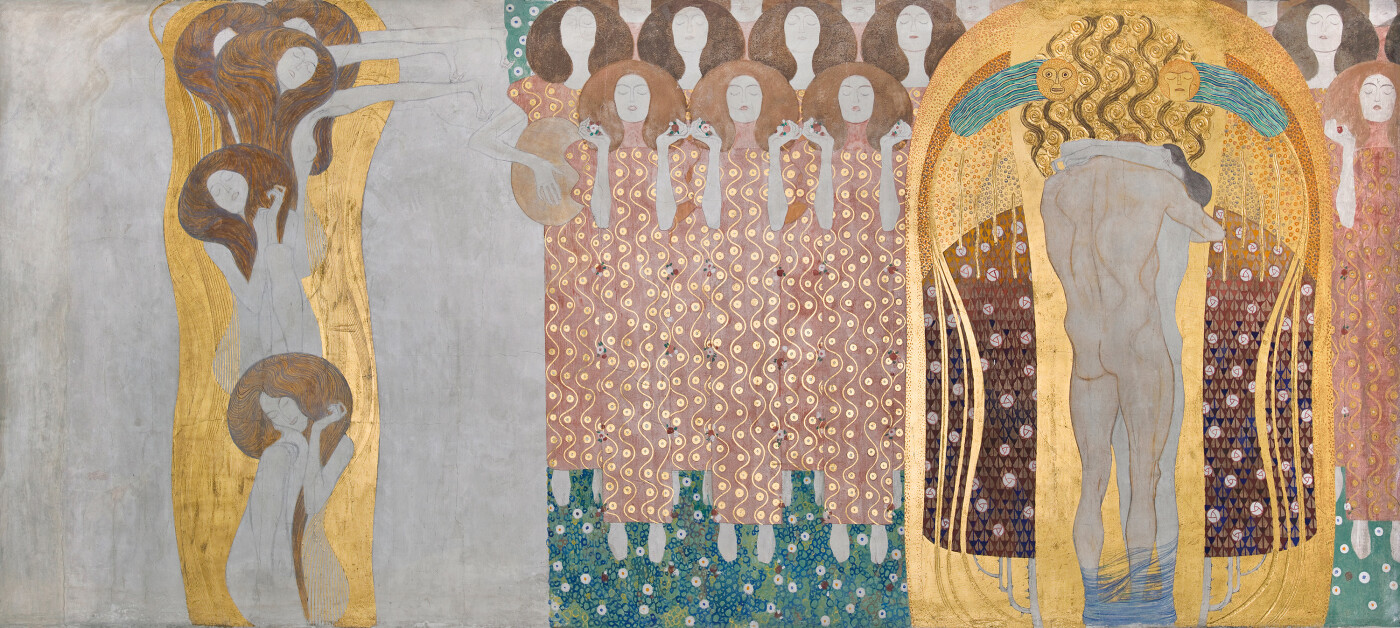 Gustav Klimt: The Beethoven Frieze (The Arts, Paradise Choir and Embrace), 1901/02, Österreichische Galerie Belvedere
Gustav Klimt: The Beethoven Frieze (The Arts, Paradise Choir and Embrace), 1901/02, Österreichische Galerie Belvedere
© Belvedere, Vienna -
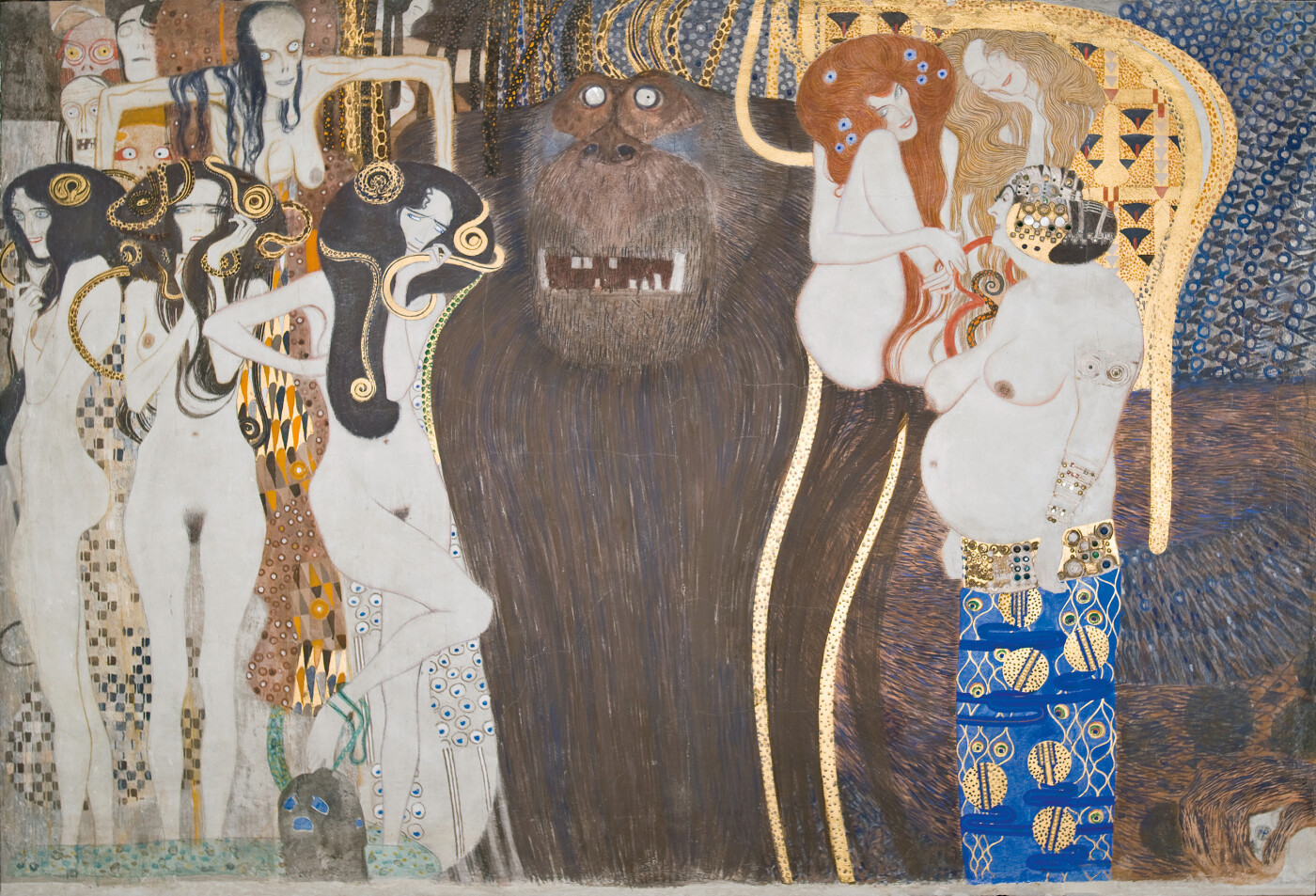 Gustav Klimt: The Beethoven Frieze (The Hostile Forces), 1901/02, Österreichische Galerie Belvedere
Gustav Klimt: The Beethoven Frieze (The Hostile Forces), 1901/02, Österreichische Galerie Belvedere
© Belvedere, Vienna -
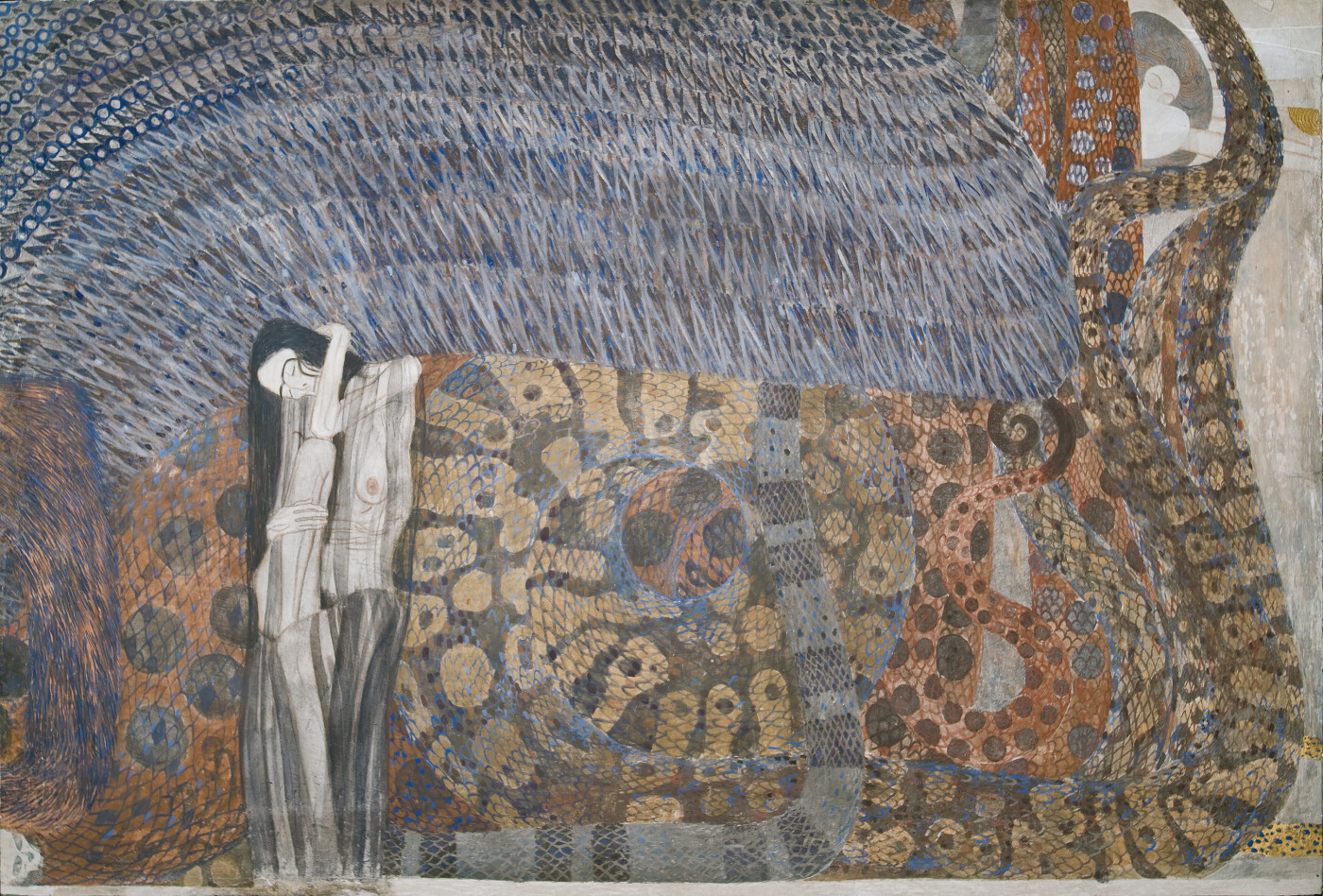 Gustav Klimt: The Beethoven Frieze (The Hostile Forces), 1901/02, Österreichische Galerie Belvedere
Gustav Klimt: The Beethoven Frieze (The Hostile Forces), 1901/02, Österreichische Galerie Belvedere
© Belvedere, Vienna
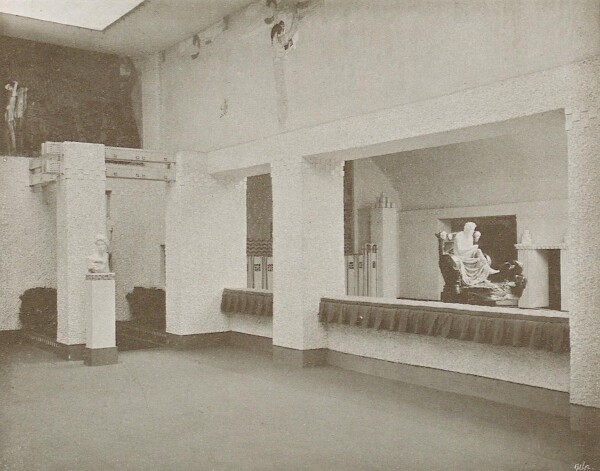
Moriz Nähr (?): Insight into the XIV Secession Exhibition, April 1902 - June 1902
© Heidelberg University Library
Hoffmann and Klimt had envisaged that the audience would then be able to see the statue of Beethoven through the opening, connecting up to antique Poetry. The phrase “The arts lead the way for us into an ideal realm” is represented through rising personifications in the nude of the various genres of art.
The end of the frieze is made up of a “Choir from Paradise” on a flowering meadow, surrounding a couple embracing each other, complete with rose bush and entitled “This Kiss to the Whole World.” The famous line from Schiller’s Ode to Joy (1786) was set to music by Beethoven in his Symphony No. 9 (1822–1824), and it leads up to Max Klinger’s statue of Beethoven. On the one hand, the interpretation of the Beethoven Frieze is based on the traditional symbolism of the figures and, on the other hand, on Richard Wagner’s reading of Beethoven’s Symphony No. 9, which he had put in writing. Perhaps Gustav Mahler, who conducted a wind ensemble of the Vienna Symphony Orchestra at the opening, conveyed knowledge of this interpretation to Gustav Klimt and the Secessionists. According to Wagner’s reading, the four movements of Beethoven’s Symphony No. 9 represent mankind’s struggle for happiness against overwhelming threats, which finds expression in the final chorus and Friedrich Schiller’s Ode to Joy. Since Gustav Klimt dealt intensively with this theme in the years between 1900 and 1907 – above all in the context of his work on the Faculty Paintings – the Beethoven Frieze may be counted among the important works from both the Golden Period and Klimt’s maturity.
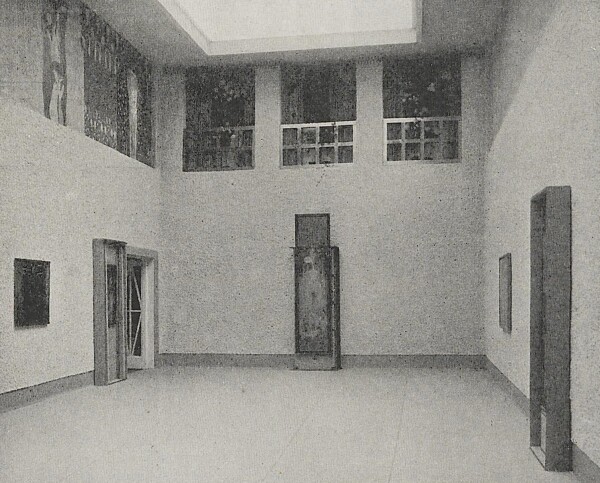
Insight into the XVIII Secession Exhibition, November 1903 - January 1904
© Heidelberg University Library
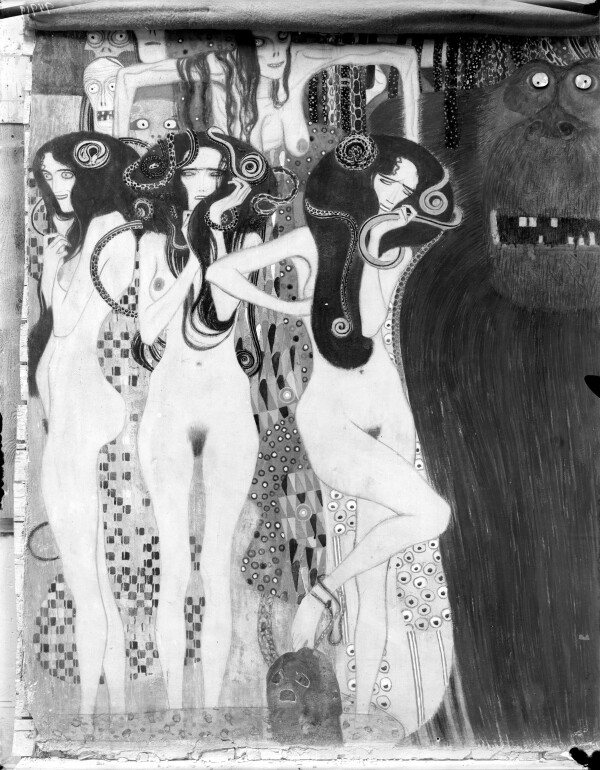
Moriz Nähr: The Beethoven Frieze (The Hostile Forces), presumably 1903, Österreichische Nationalbibliothek, Bildarchiv und Grafiksammlung
© Picture Archives and Graphics Department, Austrian National Library
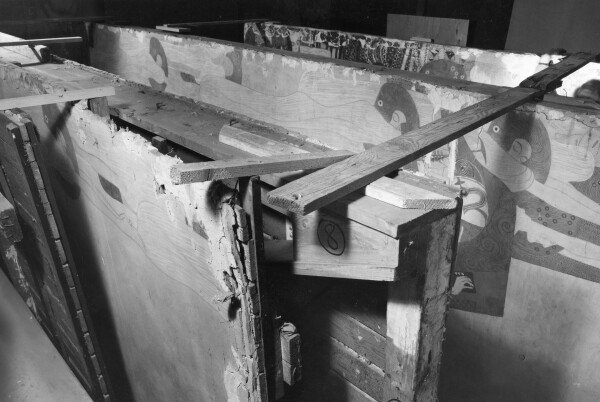
Elfriede Mejchar: The Beethoven frieze, early 1960s - mid-1970s, Federal Monuments Authority Austrian
© BDA, Vienna - Federal Monuments Office
Saved from Destruction and Sale
Gustav Klimt executed the Beethoven Frieze in casein paints on the already dry exhibition wall. Klimt had obviously planned the frieze as an ephemeral work of art that would be demolished after the exhibition had closed.
However, according to an article in the Illustriertes Wiener Extrablatt, the Viennese public had expressed its interest to start collecting signatures to rescue the work from destruction. Both Klinger’s statue and Klimt’s frieze were to be purchased by the City of Vienna and placed in a specially built temple. Although this plan was never realized, it shows the great interest Viennese society had in the two works. Hevesi also expressed his support for the preservation of the Beethoven Frieze:
“In the left aisle, Gustav Klimt has created a delightful frieze painting, so full of his bold, self-important personality that one must resist the temptation to call this painting his masterpiece. If it really is to serve only the temporary Beethoven purpose like all the rest of the exhibition and then be destroyed, Austrian art will suffer a severe loss.”
In the end, the prominent art collector Carl Reininghaus acquired the frieze for the legendary sum of 40,000 crowns (about 281,400 euros). The panels were to be removed from the walls in a laborious process. Klimt himself assured to repair the resulting damage free of charge.
However, the frieze remained in place for the show referred to as “Klimt-Kollektive” [“Gustav Klimt Collective Exhibition”] in 1903. After the end of the exhibition, it was sawn out of the wall and divided into seven panels. Since the building planned by Reininghaus to house the frieze was never realized, the work was stored in various depots for years. In 1915, Reininghaus sold the important work to the Klimt collectors August and Serena Lederer through the agency of Egon Schiele. The couple was expropriated after Austria’s “Anschluss” to the German Reich, and the frieze was transferred to the Institute for the Preservation of Monuments. After World War II, the Beethoven Frieze was returned to its heir, Erich Lederer, in 1950; however, he was not allowed to take the listed work abroad and in return would have had to donate works of art to Viennese museums. After many years of tough negotiations, Erich Lederer sold the Beethoven Frieze to the Republic of Austria in 1972. The precarious state of preservation necessitated a ten-year restoration process. In 1985, the Beethoven Frieze was presented to the public for the first time as part of the exhibition “Traum und Wirklichkeit” [“Dream and Reality”] at the Vienna Künstlerhaus. Afterwards, the Österreichische Galerie Belvedere (now Belvedere, Vienna) as the owner of the work decided to have the Beethoven Frieze installed in the basement of the Vienna Secession, where it can still be seen today.
Literature and sources
- Sophie Lillie: Feindliche Gewalten: Das Ringen um Gustav Klimts Beethovenfries, Vienna 2017.
- Stephan Koja (Hg.): Gustav Klimt: Der Beethoven-Fries und die Kontroverse um die Freiheit der Kunst, Munich 2006.
- Margarethe Szeless: Der Beethovenfries – Provenienz- und Ausstellungsgeschichte, in: Susanne Koppensteiner (Hg.): Gustav Klimt- Beethovenfries, Vienna 2002, S. 19-48.
- Vereinigung bildender Künstler Österreichs Secession (Hg.): XIV. Ausstellung der Vereinigung bildender Künstler Österreichs Secession. Klinger Beethoven, Ausst.-Kat., Secession (Vienna), 15.04.1902–15.06.1902, Vienna 1902.
- Alfred Weidinger: 100 Jahre Palais Stoclet. Neues zur Baugeschichte und künstlerischen Ausstattung, in: Agnes Husslein-Arco, Alfred Weidinger (Hg.): Gustav Klimt – Josef Hoffmann. Pioniere der Moderne, Ausst.-Kat., Lower Belvedere (Vienna) - Upper Belvedere (Vienna), 25.10.2011–04.03.2012, Munich 2011, S. 202-251.
- Peter Vergo: Gustav Klimt’s Beethoven Frieze, in: The Burlington Magazine, 115. Jg., Heft 839 (1973), S. 108-113.
- Agnes Husslein-Arco, Alfred Weidinger (Hg.): Gustav Klimt – Josef Hoffmann. Pioniere der Moderne, Ausst.-Kat., Lower Belvedere (Vienna) - Upper Belvedere (Vienna), 25.10.2011–04.03.2012, Munich 2011.
- Anette Vogel (Hg.): Gustav Klimt Beethovenfries. Zeichnungen, Ausst.-Kat., Balingen Town Hall (Balingen), 10.07.2010–26.09.2010, Munich 2010.
- Charles Holme (Hg.): The Art-Revival in Austria. The Studio. Special Summer Number, London - Paris - New York 1906.
- Rohrpost-Kartenbrief von Gustav Klimt in Wien an Maria Zimmermann in Wien (12.11.1901). S63/27.
- Brief von Gustav Klimt am Attersee an Maria Zimmermann in Villach (vermutlich Anfang September 1901). S63/24.
- Brief von Gustav Klimt an Maria Zimmermann (Ende September 1901 - Anfang Oktober 1901). S63/23.
- Brief von Gustav Klimt am Attersee an Maria Zimmermann (August 1901). S63/20.
- Brief von Gustav Klimt am Attersee an Maria Zimmermann (August 1901). S63/19.
- Revers von Gustav Klimt in Wien, mitunterschrieben von Carl Moll und Hugo Haberfeld (16.12.1907). H.I.N. 15.9214, .
- Brief von Erich Lederer in Györ an Egon Schiele (04.10.1915). S263.
- Brief mit Kuvert von Gustav Klimt in Wien an Maria Zimmermann in Villach (17.10.1902). S63/28.
- Alfred Weidinger (Hg.): Gustav Klimt, Munich - Berlin - London - New York 2007.
- Alexandra Matzner, Gustav Klimts Gold für das Paradies Vergoldungstechnik im Beethovenfries, Wien 2015. artinwords.de/klimt-gold-im-beethovenfries/ (12/20/2019).
- Tobias G. Natter (Hg.): Die Galerie Miethke. Eine Kunsthandlung im Zentrum der Moderne, Ausst.-Kat., Jewish Museum Vienna (Vienna), 19.11.2003–08.02.2004, Vienna 2003.
- Ivo Hammer: 110 Jahre Beethovenfries von Gustav Klimt. Zu Maltechnik, Restaurierung und Präsentation, in: Agnes Husslein-Arco, Alfred Weidinger (Hg.): Gustav Klimt – Josef Hoffmann. Pioniere der Moderne, Ausst.-Kat., Lower Belvedere (Vienna) - Upper Belvedere (Vienna), 25.10.2011–04.03.2012, Munich 2011, S. 140-149.
- Manfred Koller: Zur Technik und Erhaltung des Beethoven-Frieses, in: Stephan Koja (Hg.): Gustav Klimt: Der Beethoven-Fries und die Kontroverse um die Freiheit der Kunst, Munich 2006, S. 155-165.
- Manfred Koller: Klimts Beethovenfries. Zur Technologie und Erhaltung, in: Mitteilungen der Österreichischen Galerie, 22/23. Jg., Nummer 66/67 (1978/79), S. 215-240.
- Marian Bisanz-Prakken: Der Beethovenfries von Gustav Klimt in der XIV. Ausstellung der Wiener Secession (1902), in: Robert Waissenberger (Hg.): Traum und Wirklichkeit. Wien 1870–1930, Ausst.-Kat., Museums of the City of Vienna (Vienna), 28.03.1985–06.10.1985, Vienna 1985, S. 528-543.
- Marian Bisanz-Prakken: Gustav Klimt - Der Beethovenfries. Geschichte, Funktion und Bedeutung, 1977.
Trees and Forests
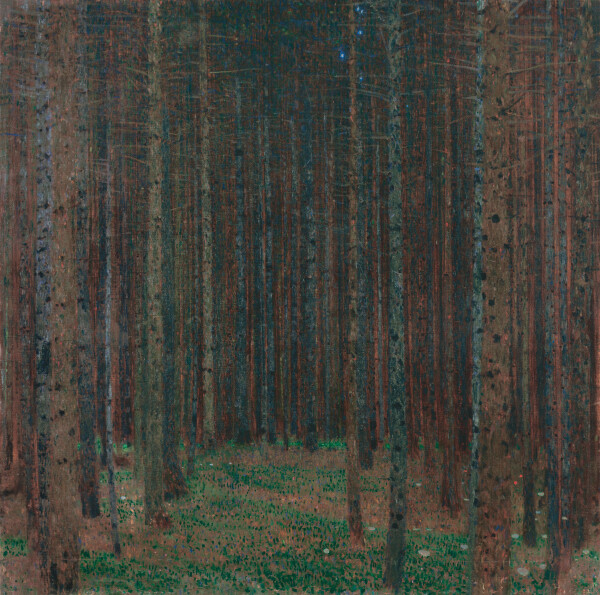
Gustav Klimt: Pine Forest I, 1901, Kunsthaus Zug
© Kunsthaus Zug, Stiftung Sammlung Kamm
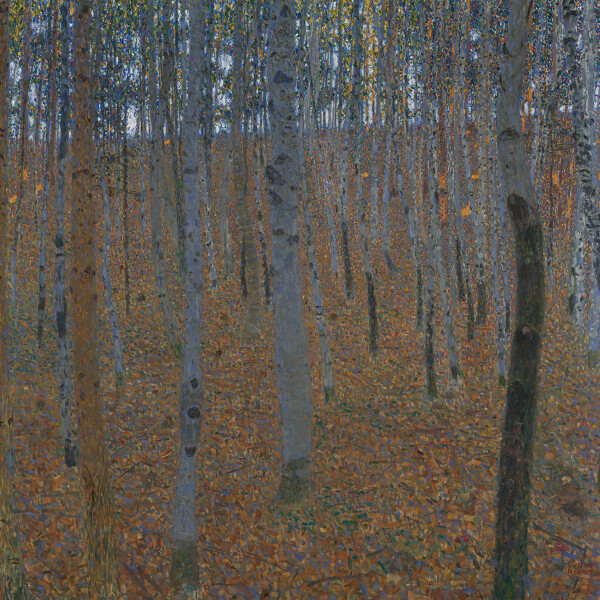
Gustav Klimt: Beech Forest I, 1902, Staatliche Kunstsammlungen Dresden
© bpk | Staatliche Kunstsammlungen Dresden
Having arrived at a personal approach to landscape painting between 1898 and 1900, Klimt made use of the motif of the forest view for stylistic experiments in the years between 1901 and 1903. A phase of Post-Impressionism and Pointillism was followed by the artist’s turn toward flatness.
Forest Views
One of the most essential innovations in Gustav Klimt’s oeuvre was the painter’s discovery of forest views in the summer of 1901. In the years up to 1904 he painted as many as altogether five forest pictures, all of which seem to depict motifs from the surroundings of the Bräuhof in Litzlberg on the Attersee: Pine Forest I (1901, Kunsthaus Zug), Pine Forest II (1901, private collection), Beech Forest I (c. 1902, Staatliche Kunstsammlung, Dresden), Beech Forest II (Beech) (1903, private collection), and Birch Forest (Beech Forest) (1904, private collection). Next to orchards, which were already an established motif in his oeuvre, thick spruce and beech forests followed as the second characteristic subject matter of those years.
In his review of the “XIII. Ausstellung der Vereinigung bildender Künstler Österreichs Secession” [“13th Exhibition of the Association of Austrian Artists Secession”], Ludwig Hevesi found apt words to describe Pine Forest I and Pine Forest II on 13 February 1902:
“A number of vertical trunks, seemingly all the same, like columns in a church, seemingly an orderless throng of long, vertical things. But, indeed, thoroughly composed groups and perspectives, spatial life, air, twilight. [...] Just observe the delicate breakthroughs of sunny air in one of his two forest pictures, which at first sight merely seem to be dark thickets.”
What critics like Richard Muther admired about the forest views was how Klimt placed spots of light and color. Although the motifs did not differ from those of other painters, they would be recognizably “Klimt” at first glance. The Viennese painter had developed a personal signature style, from the choice of the square picture format to a delicate manner of painting composed of subtle strokes and dabs.
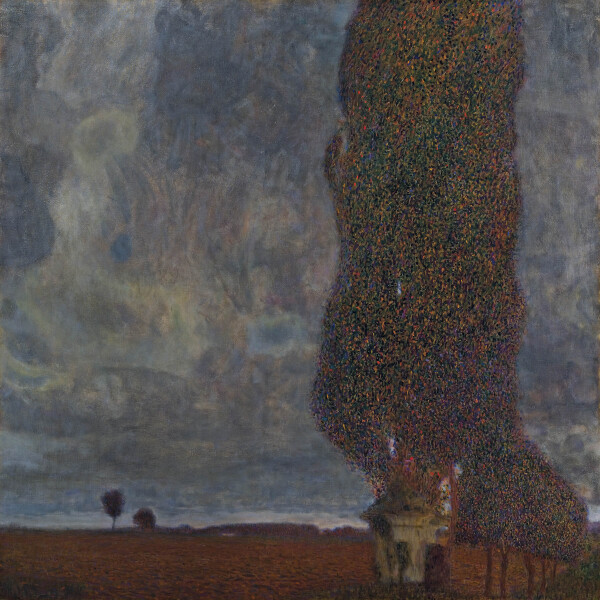
Gustav Klimt: The Large Poplar II (Gathering Storm), 1902/03, Leopold Museum
© Leopold Museum, Vienna
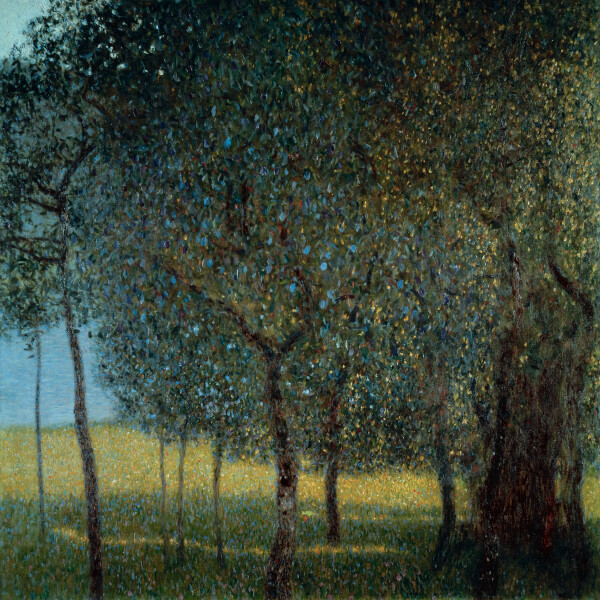
Gustav Klimt: Fruit Trees, 1901, private collection
© Gallery Welz Salzburg
Poplar on the Attersee
In Island in the Attersee (1902, private collection) and The Large Poplar II (Gathering Storm) (1902, Leopold Museum, Vienna), the artist revisited two compositions from 1900. Klimt’s dealing not only with Claude Monet’s Impressionism but also with the possibilities offered by Pointillism led to breathtaking compositions. Frequently, Klimt’s change in style is also explained by his studying the art of Giovanni Segantini and Théo van Rysselberghe, whose works he knew not only from the Vienna Secession’s exhibitions. Both works differ from the dominant forest views and orchards from that same phase by their widening space. The eye is allowed to wander into the depth of the landscape without being held up. In these works, Klimt nevertheless puts the possibilities of an increasingly two-dimensional or flat rendering of nature to the test.
In Island in the Attersee, while revisiting the motif of the painting On the Attersee (1900, Leopold Museum, Vienna), Klimt moves the island of Litzlberg, which is overlapped by the upper margin of the picture, somewhat more into the picture. The castle located on the island is again blocked from view. Instead, Gustav Klimt concentrates on rendering the play of waves in the foreground and the reflection of the island in the middle ground, which in literature is referred to as “vegetabilization.” As was to be seen for the first time in the two works dating from the previous year – Farmhouse in Kammer on the Attersee (Mill) (1901, private collection) and Fruit Trees (1901, private collection) – Klimt increasingly turned to the Impressionist and Pointillist style in his landscapes.
In The Large Poplar II (Rising Thunderstorm), he combined the gossamer and, at first glance, naturalistic depiction of cumulus clouds with a dab-like treatment of the foliage. The autumnal trees – unique in Klimt’s entire oeuvre – shimmer in shades of green, blue, violet, red, and orange. The candle shape of the eponymous poplar and its position within the picture are reminiscent of Vincent van Gogh’s late landscapes featuring lambent cypresses. The low horizon is unusual for a landscape by Klimt, yet it allows him to describe the mood of the gathering storm in the form of dark clouds. Upon closer inspection it is noticeable that colored layers are worked into the gray of the cloud masses, lending the composition its coloristic equilibrium.
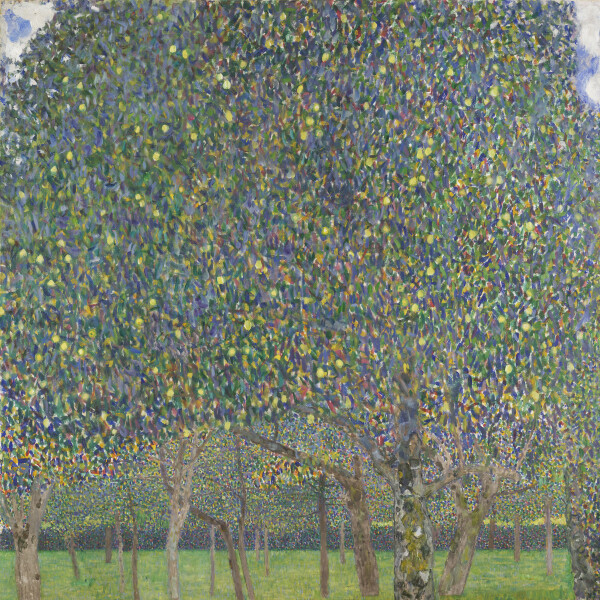
Gustav Klimt: Pear Tree, 1903, Harvard Art Museums/Busch-Reisinger Museum, Cambridge
© President and Fellows of Harvard College
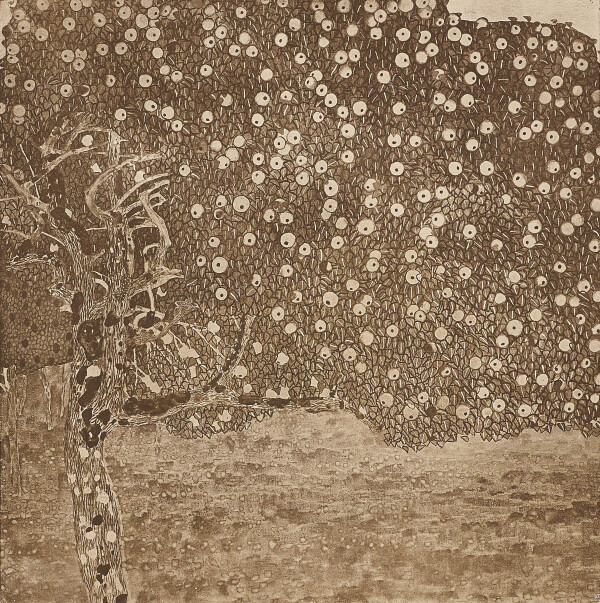
Gustav Klimt: The Golden Apple Tree, 1903, 1945 in Schloss Immendorf verbrannt
© Klimt Foundation, Vienna
Fruit Trees
In 1903 the Viennese painter devoted himself to pear and apple trees, whose rich fruit he used for stylistic experiments: Pear Tree (1903, Harvard Art Museum/Busch-Reisinger Museum, Cambridge) and The Golden Apple Tree (1903), which was destroyed by fire at Immendorf Castle in 1945. In both paintings, the fruit trees are approached in a Pointillist play of dots on the one hand and as gilded stylization on the other. In its composition, Pear Tree follows the painting Fruit Trees from 1901. If in the earlier painting he still lets the lake flash in the background, in Pear Tree (Pear Trees) he organizes the landscape in horizontal stripes. The treetops obscure the view into the sky, while the trunks close off the garden parallel to the picture plane. The painting shows a noticeably thicker application of paint on the left side than in the center or on the right. This is probably due to the fact that Gustav Klimt, who gave the work to Emilie Flöge in 1903, probably worked on it until his death.
One year after the Beethoven Frieze (1901/02, Belvedere, Wien), in which Klimt took the use of flatness, gold leaf, and rhythmic linearity to a first climax, he also applied these stylistic principles to the depiction of a single tree. Although the composition of the Golden Apple Tree has survived only in a black-and-white reproduction, it can be classified stylistically due to the high quality of the photograph. Friedrich König’s illustration The Golden Bird may have served as a model for the formal composition, as it was published in Ver Sacrum in 1902. The design of the exuberant treetop combines inspirations from Viennese stylization art and Byzantine mosaics. The intricately ramifying tree trunk on the left side of the picture repeats painted solutions as seen in Pear Tree (Pear Trees).
It should be pointed out that landscape painting advanced to become a principal subject in Gustav Klimt’s work in the first years after 1900. The painter apparently became more financially dependent on private portrait commissions and marketable landscapes as a result of his extensive involvement with the Faculty Paintings. The landscape paintings offered him the opportunity to explore diverse stylistic possibilities of modernism and develop his art.
Literature and sources
- Ludwig Hevesi: Acht Jahre Sezession (März 1897–Juni 1905). Kritik – Polemik – Chronik, Vienna 1906.
- Stephan Koja (Hg.): Gustav Klimt. Landschaften, Ausst.-Kat., Upper Belvedere (Vienna), 23.10.2002–23.02.2003, Munich 2002.
- Sandra Tretter, Peter Weinhäupl (Hg.): Gustav Klimt. Sommerfrische am Attersee 1900-1916, Vienna 2015.
- Toni Stoos, Christoph Doswald (Hg.): Gustav Klimt, Ausst.-Kat., Kunsthaus Zurich (Zurich), 11.09.1992–13.12.1992, Stuttgart 1992.
- Sandra Tretter, Peter Weinhäupl (Hg.): Chiffre: Sehnsucht – 25. Gustav Klimts Korrespondenz an Maria Ucicka 1899–1916, Vienna 2014.
- Richard Muther: Klimt (1903), in: Aufsätze über bildende Kunst, Band I, Berlin 1914.
Viennese Society Portraits
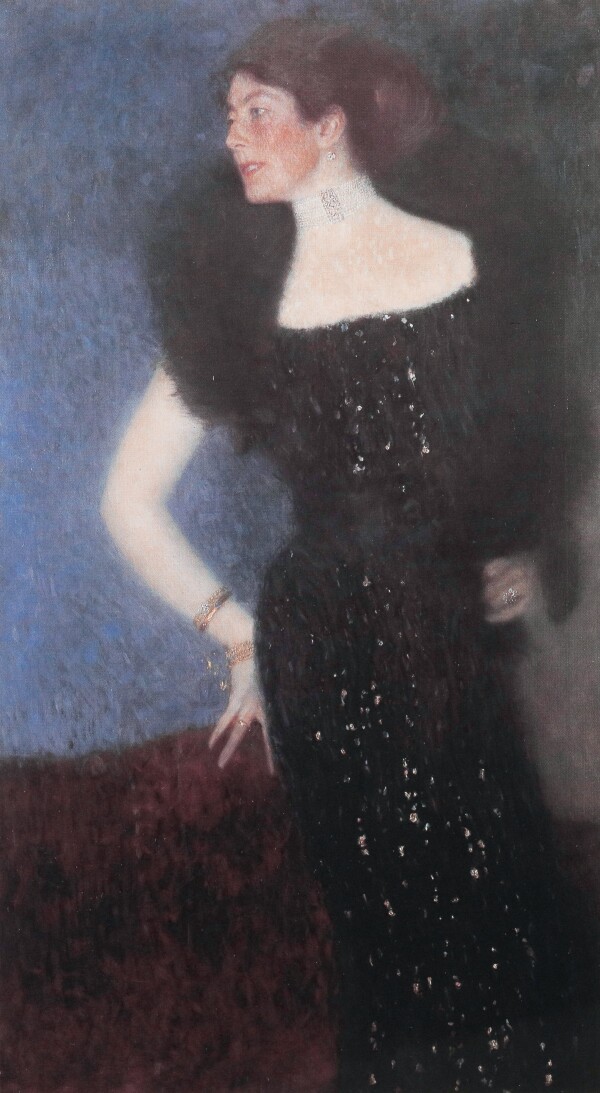
Gustav Klimt: Portrait of Rose von Rosthorn-Friedmann, 1900/01, private collection
© Klimt Foundation, Vienna
From 1900 onwards, Gustav Klimt increasingly established himself as a portraitist of the upper echelons of Viennese society. Above all, his ability to capture the latest fashion trends on canvas in a gossamer painting style quickly became his personal signature. Successively introducing more ornamentation in his portraits, Klimt already anticipated the two-dimensionality of his subsequent works.
The avant-gardist, who had become internationally famous around 1900 due to the scandal surrounding the Faculty Painting of Philosophy (1900–1907, destroyed by fire at Immendorf Castle in 1945), was able to convince a small circle of extremely wealthy, modern-minded Viennese of his art. Gustav Klimt’s works were particularly popular with the ladies of the upper middle classes. Between 1901 and 1903, he created one to two monumental portraits per year, thus arriving at a rhythm he would maintain for the rest of his life. The female portraits dating from this period are characterized by a gossamer painting style and voluminous dresses shimmering in powdery tones.
Rose von Rosthorn-Friedmann
The Portrait of Rose von Rosthorn-Friedmann (1900/01, private collection) was considered lost for a long time and was last exhibited in 1992. The sitter was the daughter of an industrialist whose family originally came from England. In 1886 she married her second husband, the industrial tycoon Louis Friedmann. Together with her husband, she undertook numerous mountain tours and was one of the most important alpinists of her time. The couple frequented Vienna’s artistic circles and cultivated friendships with such personalities as Arthur Schnitzler and Hugo von Hofmannsthal.
Gustav Klimt depicted Rose von Rosthorn-Friedmann as a sophisticated and elegantly dressed woman. He prepared the painting in several figure studies in which he dealt primarily with the position of her arms. In addition, he made a transfer sketch (1900/01, Albertina, Vienna, S 1980: 511), which was already very close to the executed work. Klimt opted for an upright standing position and a strongly twisted upper body. He clad the sitter in a fitted black evening dress that appears to be embroidered with sequins. Over her shoulders she wears a fur bolero, and the glitter of her robe is repeated in her jewelry: a multistranded pearl choker, earrings, bracelets, and rings.
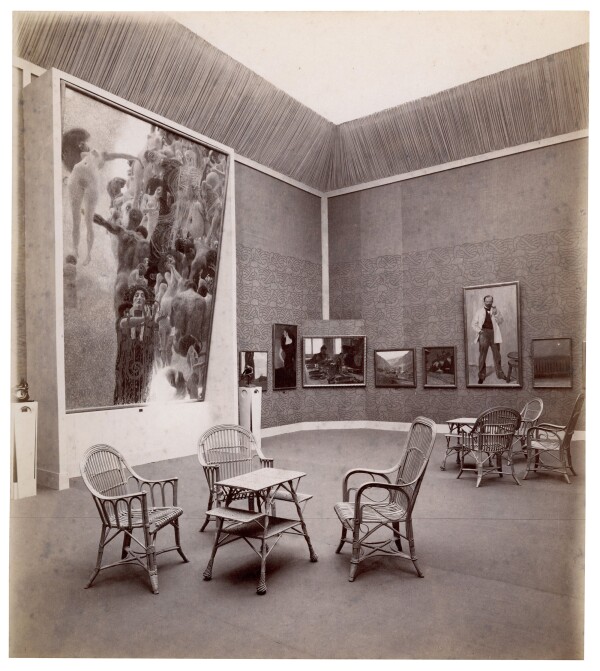
Insight into the VIII. International Art Exhibition in Munich, June 1901 - October 1901, Künstlerhaus-Archiv, Wien
© WStLA - Municipal and Provincial Archives of Vienna
The portrait was first shown in March 1901 at the “X. Ausstellung der Vereinigung bildender Künstler Österreichs Secession” [“10th Exhibition of the Association of Austrian Artists Secession”] alongside such paintings such as Medicine (1900–1907, destroyed by fire at Immendorf Castle in 1945) and The Large Poplar II (1902/03, Leopold Museum, Vienna). Franz Servaes reviewed the exhibition in the Neue Freie Presse and described the work and the sitter’s jewelry:
“It is wonderful how the shimmering violet of the background caresses the naked, propped-up arm and the dark robe covered with glitter. And gold bracelets, pearls, and jewels shine mysteriously.”
A letter Gustav Klimt wrote to Louis Friedmann in July 1901 also provides an interesting insight in this regard:
“[I] took the liberty of writing a letter to your honorable wife [to which I] have unfortunately received no reply to date, and in which I asked her where to send the three bracelets that are still here with me, for I would like to go to the countryside and would not think it wise to keep them here.”
Portrait of Rose von Rosthorn-Friedmann is also related to Water Nymphs (Silverfish) (1902/03, Albertina, Vienna), both formally and thematically. The sitter’s face closely resembles the nymph depicted in the foreground.
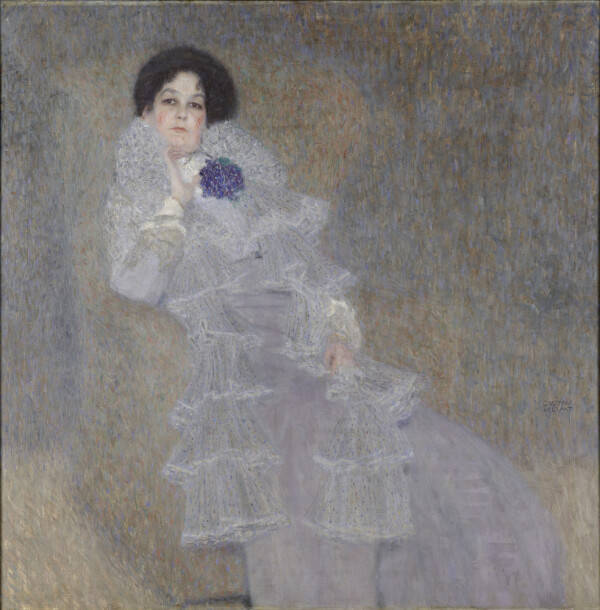
Gustav Klimt: Portrait of Marie Henneberg, 1901/02, Kunstmuseum Moritzburg Halle (Saale) – Kulturstiftung Sachsen-Anhalt
© Kulturstiftung Sachsen-Anhalt – Kunstmuseum Moritzburg Halle (Saale)
Marie Henneberg
Marie Henneberg was the wife of Hugo Henneberg, a chemist and amateur photographer, who at the turn of the century established himself as one of the most important practitioners of Pictorialism, exhibiting at the Vienna Secession. In the spring of 1899, the couple joined a travel party led by the Moll family to Italy, which was also joined by Gustav Klimt. In 1900/01 the Hennebergs had a villa built by Josef Hoffmann in what was referred to as an artists’ colony on Hohe Warte and thus lived in the immediate vicinity of Carl Moll, Kolo Moser, and Friedrich Viktor Spitzer. The house became a meeting place of modernism in Vienna.
An acquaintance of the couple, Gustav Klimt painted the square-format Portrait of Marie Henneberg (1901/02, Staatliche Galerie Moritzburg, Halle an der Saale), which depicts her seated in an armchair. It was first presented in 1902 – in a still unfinished state – at the “XIII. Ausstellung der Vereinigung bildender Künstler Österreichs Secession” [“13th Exhibition of the Association of Austrian Artists Secession”]. This was followed in 1903 by the “Klimt-Kollektive” or “Kollektiv-Ausstellung Gustav Klimt” [“Gustav Klimt Collective Exhibition”], where Ludwig Hevesi described the work as “[...] the lady in white frillwork; the seated one in pale purple, with a bouquet of violets.” That same year, the magazine Das Interieur published several photographs of Villa Henneberg showing the painting in situ in the villa’s spacious entrance hall.

Gustav Klimt: Portrait of Gertrud Loew, 1902, The Lewis Collection, in: Kunstverlag Hugo Heller (Hg.): Das Werk von Gustav Klimt, Vienna - Leipzig 1918.
© Klimt Foundation, Vienna
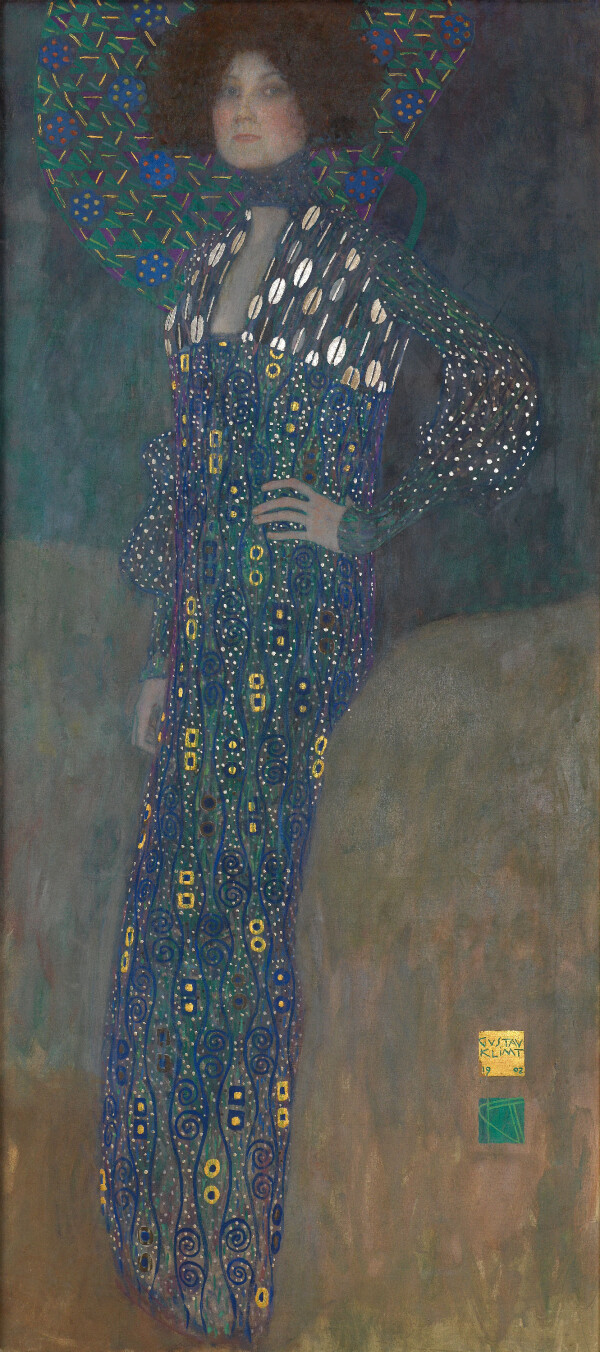
Gustav Klimt: Portrait of Emilie Flöge, 1902/03, Wien Museum
© Wien Museum
The portrait can be assigned to a whole group of brightly dressed ladies – works in which Klimt increasingly explored the latest developments in Post-Impressionism and Pointillism. Both the dominance of tones in lilac and light blue and the growing dissolution of the armchair in favor of a colored composition show how Klimt adopted the innovations of the French and Belgian avant-garde for his own style.
Gertrud Loew
Gertrud Loew was the daughter of the physician Dr. Anton Loew, founder of the renowned Viennese private hospital Sanatorium Loew. He was an advocate of modern art and owned several works by Klimt. Most likely it was he who, around 1902, also commissioned from Gustav Klimt a portrait of his then 19-year-old daughter. It may have been an engagement present, as Gertrud Loew married the industrial magnate Dr. Hans Eisler von Terramare in February 1903. The couple moved into a modern apartment on Schottenring, furnished by Kolo Moser and committed to the idea of the Secessionist Gesamtkunstwerk [universal work of art].
It seems that no preliminary studies have survived for Portrait of Gertrud Loew (1902, The Lewis Collection). The work was first presented in 1903 as part of the “Klimt-Kollektive” at the Secession. The lender was Anton Loew, who asked the Secession in writing to label the “Portrait of a Lady” and other works provided by him as anonymous loans from a “private collection.” Ludwig Hevesi compared the exhibited painting with the Portrait of Rose von Rosthorn-Friedmann:
“Just look at the nervously pointed nature of the lady in black painted a few years ago and, by contrast, the very young white Fräulein of this year, a pure breeze, with the four pale lilac silk ribbon stripes running down the flimsy, crinkled dress. Each stripe meanders differently in the iridescent fall of the fabric; a coincidence in which lies the finest painterly plan.”
With Gertrud Loew, Klimt developed the portrait type he had established with Portrait of Serena Lederer (1899, The Metropolitan Museum of Art, New York) and Portrait of Trude Steiner (1900, whereabouts unknown). By way of comparison, however, the sitter now occupies almost the entire pictorial space of the extremely narrow vertical format, which betrays an influence of Japanese art. Through Gertrud Loew’s frontal view, the tightly cropped composition, and the tonality of the light-colored dress, which continues in the background, Klimt emphasized the two-dimensionality of the work. In the upper left corner, he added his signature and the date “1902” within two green squares reminiscent of signature stamps in Japanese woodcuts.
Emilie Flöge
Due to their family connections, there was a close bond between Klimt and Emilie Flöge over many years. Together with her sisters Pauline and Helene, the widow of Klimt’s elder brother Ernst, she opened the fashion salon “Schwestern Flöge” on 1 July 1904. She was in charge of the management of the salon in artistic and fashion matters. The company’s customers included art-savvy and fashion-conscious ladies of high society such as Sonja Knips, Hermine Gallia, and Eugenia Primavesi, who were also associated with Gustav Klimt as the artist’s patronesses.
The genesis of the painting Portrait of Emilie Flöge (1902/03, Wien Museum, Vienna) cannot be accurately reconstructed due to a lack of drawn studies, among other things. Klimt signed and dated the work in a way similar to that of Portrait of Gertrud Loew, inscribing two square signets with “Gustav Klimt 1902.” However, the two paintings, which were created around the same time, differ greatly: unlike the ethereal, powdery appearance of Gertrud Loew, the portrait of Emilie Flöge is dominated by powerful colors, ornamented surfaces, and the use of gold and silver. Slightly twisted, Flöge stands in an undefined space wearing an ornamentally patterned dress whose two-dimensionality contrasts with her naturalistic facial features. Ludwig Hevesi referred to Flöge as seen in the painting as “the upright one, à la Japan and faience in blue, green, and gold.” It was first exhibited in an unfinished state in November 1903 at the “Klimt-Kollektive” at the Secession. Berta Zuckerkandl went into further detail about the work in the Wiener Allgemeine Zeitung:
“The charming, subtly and delicately modeled face is further elevated by the rare framing. The head is surrounded by an aureole-like green and blue floral wreath that has the coloristic mysticism of Byzantine backgrounds.”
While the exhibition was still on, Klimt corresponded about the unfinished portrait. In a letter of 17 January 1904 he replied to a purchase request from the Imperial-Royal Ministry for Culture and Education:
“[I] had not intended to sell the portrait of Miss Flöge. But as in the present case it would possibly be acquired for the State Gallery, I am prepared to sell the picture for the Modern Gallery with the consent of its owner as soon as it has been completed. The price will be the same I now receive for a portrait commission, 10,000 crowns.”
The sale probably did not materialize due to the high price, and Klimt completed the painting no later than the summer of 1908, when it was purchased by the Niederösterreichisches Landesarchiv [Lower Austrian State Archives].
Gustav Klimt: Portrait of Hermine Gallia, 1903/04, The National Gallery
©
Hermine Gallia
Portrait of Hermine Gallia (1903/04, National Gallery, London) shows the wife of the wealthy businessman Moritz Gallia, who, among other things, served as president of the Wiener Werkstätte. Together, the couple also supported the Vienna Secession, championed the founding of the Moderne Galerie [Modern Gallery] (now Belvedere, Vienna), and passionately collected art.
Klimt’s portrait of Hermine Gallia was a direct continuation of the portrait of Marie Henneberg, which he prepared around 1902/03 with a number of studies. Originally conceived in a seated position, Klimt decided, to depict Hermine Gallia standing. In the upright-format painting, the sitter is set off against the dark background and looks out of the picture in a slightly twisted pose. She wears an elaborately designed evening gown with a cape-like boa – a so-called “ball entrée” – with ruffles, flounces, and a train draped effectively in the foreground. Transparent and light-colored sections iridesce and are accented by a pink sash around the sitter’s waist, as well as glittering, stone-studded jewelry. Not only did Klimt execute the background in a style similar to that employed for the portrait of Emilie Flöge, he also repeated the geometric shapes, although here he integrated them very subtly into the patterned carpet on the floor.
The work was shown for the first time in 1903 at the “XVIII. Ausstellung der Vereinigung bildender Künstler Österreichs Secession Wien” [“18th Exhibition of the Association of Austrian Artists Vienna Secession”]; in the accompanying catalog it was listed as “38. Portrait of a Lady. Private collection. Unfinished.” Both the number and the unfinished state were also documented in the form of a photograph of the work when it was installed at the Secession during the exhibition. After the presentation, Klimt changed only a few details in the hairstyle and face and then added his signature and the date 1904 in the already familiar square signet in the upper right corner of the picture.
Literature and sources
- Alfred Weidinger (Hg.): Gustav Klimt, Munich - Berlin - London - New York 2007.
- Tobias G. Natter (Hg.): Gustav Klimt. Sämtliche Gemälde, Vienna 2012.
- Tobias G. Natter, Gerbert Frodl (Hg.): Klimt und die Frauen, Ausst.-Kat., Upper Belvedere (Vienna), 20.09.2000–07.01.2001, Cologne 2000.
- Ernst Ploil: The Portrait of Gertha Loew, in: Tobias G. Natter (Hg.): Klimt and the Women of Vienna's Golden Age. 1900–1918, Ausst.-Kat., New Gallery New York (New York), 22.09.2016–16.01.2017, London - New York 2016, S. 96-101.
- Franz Servaes: Secession. Eine Porträtgalerie. Gustav Klimt, in: Neue Freie Presse, 19.03.1901, S. 1-3.
- Alice Strobl (Hg.): Gustav Klimt. Die Zeichnungen, Band I, 1878–1903, Salzburg 1980, S. 158-163, S. 216-219, S. 292-299.
- Rohrpost-Kartenbrief von Gustav Klimt in Wien an Louis Friedmann in Wien (07/30/1901). S538.
- Gerd Pichler, Joseph Maria Olbrichs nie gebaute Künstlerkolonie in Wien und Josef Hoffmanns Künstlerkolonie auf der Hohen Warte.. journals.ub.uni-heidelberg.de/index.php/icomoshefte/article/view/46883/40388 (05/18/2020).
- Ludwig Hevesi: Weiteres zur Klimt-Ausstellung. 21. November 1903, in: Acht Jahre Sezession (März 1897–Juni 1905). Kritik – Polemik – Chronik, Vienna 1906, S. 448–452.
- Gerd Pichler: Kolo Mosers »Wohnung für ein junges Paar« - Gerta und Dr. Hans Eisler von Terramare, in: Rudolf Leopold, Gerd Pichler (Hg.): Koloman Moser 1868−1918, Ausst.-Kat., Leopold Museum (Vienna), 25.05.2007–10.09.2007, Munich 2007, S. 174-201.
- Visitenkarte von Anton Loew an die Vereinigung bildender Künstler Österreichs (10/22/1903). 24.4.2_Loew Anton_5861, .
- Brief von Gustav Klimt in Wien an das k. k. Ministerium für Kultus und Unterricht, verfasst von fremder Hand (presumably 01/17/1904). AT-OeStA/AVA Unterricht UM, Fasz.15 Kunstwesen, Ankauf, Akt ZI 4197/1904 Fasz 3060, Klimt, Flöge, fol. 2, .
- Berta Zuckerkandl: Die Klimt-Ausstellung, in: Wiener Allgemeine Zeitung (Abendausgabe), 15.11.1903, S. 6-7.
- Rechnungsbestätigung von Gustav Klimt an den Niederösterreichischen Landesausschuss in Wien (06.07.1908). NÖ Landesarchiv, Nö. Landesregistratur, IV-42 1908, zu Zl. 2/1, fol.8.
- biografiA. Rose Rosthorn. www.biographien.ac.at/oebl_9/270.pdf (05/05/2020).
- Die Kunst. Monatshefte für freie und angewandte Kunst, Band 10 (1903/04), S. 355.
- Ursula Storch (Hg.): Klimt. Die Sammlung des Wien Museums, Ausst.-Kat., Vienna Museum (Vienna), 16.05.2012–07.10.2012, Vienna 2012, S. 206-207.
Faculty Paintings. Medicine and Jurisprudence
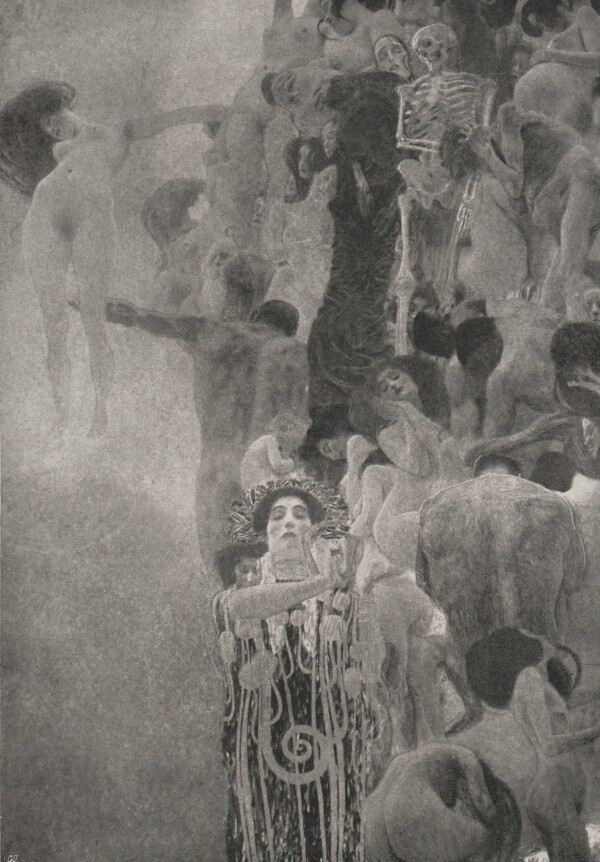
Gustav Klimt: Medicine, 1900-1907, 1945 in Schloss Immendorf verbrannt, in: Vereinigung bildender KünstlerInnen Wiener Secession (Hg.): Ver Sacrum. Mitteilungen der Vereinigung bildender Künstler Österreichs, 4. Jg., Heft 6 (1901).
© Klimt Foundation, Vienna
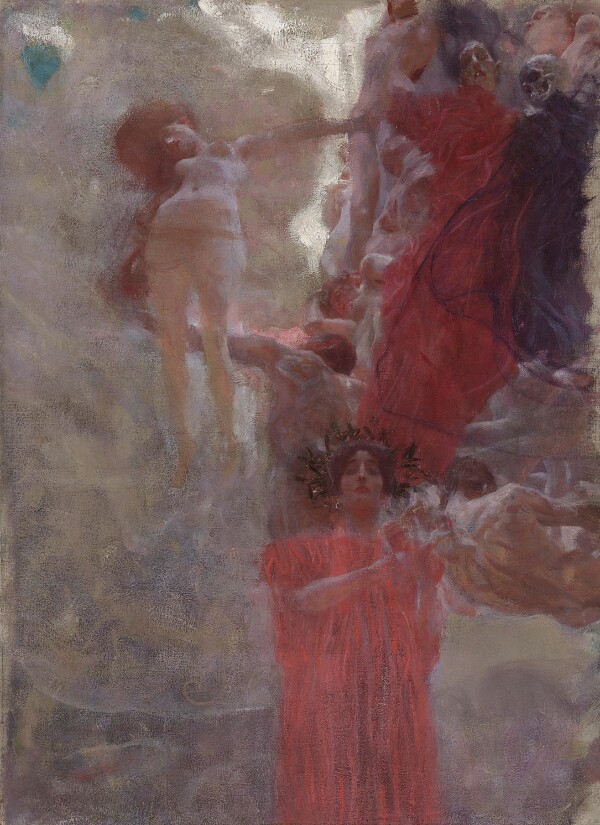
Gustav Klimt: Medicine (Study), 1898 (überarbeitet: 1898), The Israel Museum
© The Israel Museum, Jerusalem
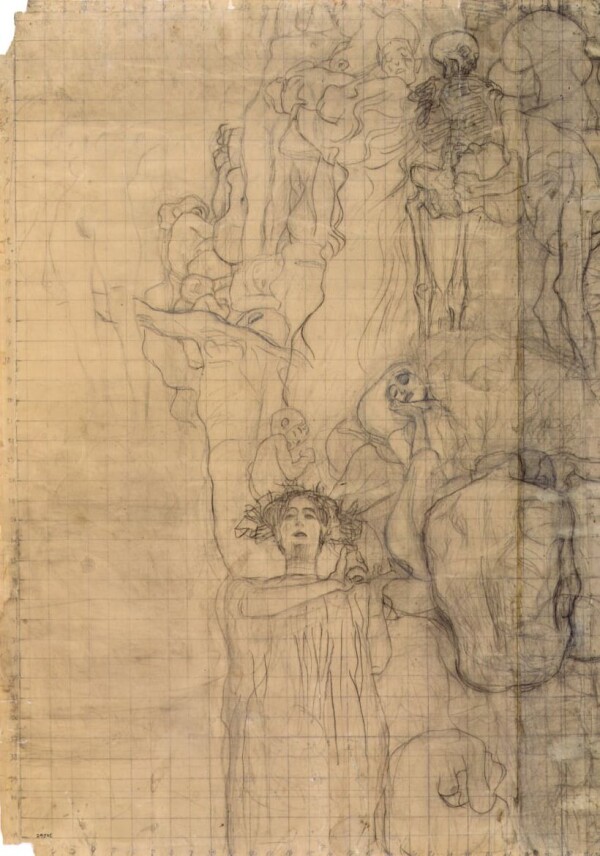
Gustav Klimt: The medicine (transfer sketch), circa 1900, The Albertina Museum
© The ALBERTINA Museum, Vienna
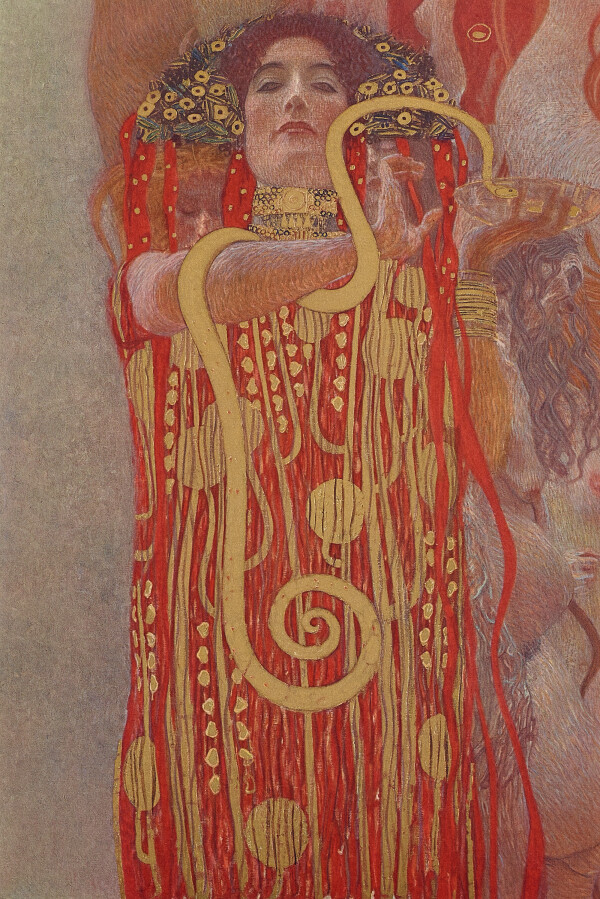
Gustav Klimt: Medicine, 1900-1907, 1945 in Schloss Immendorf verbrannt, in: Max Eisler (Hg.): Gustav Klimt. Eine Nachlese, Vienna 1931.
© Klimt Foundation, Vienna
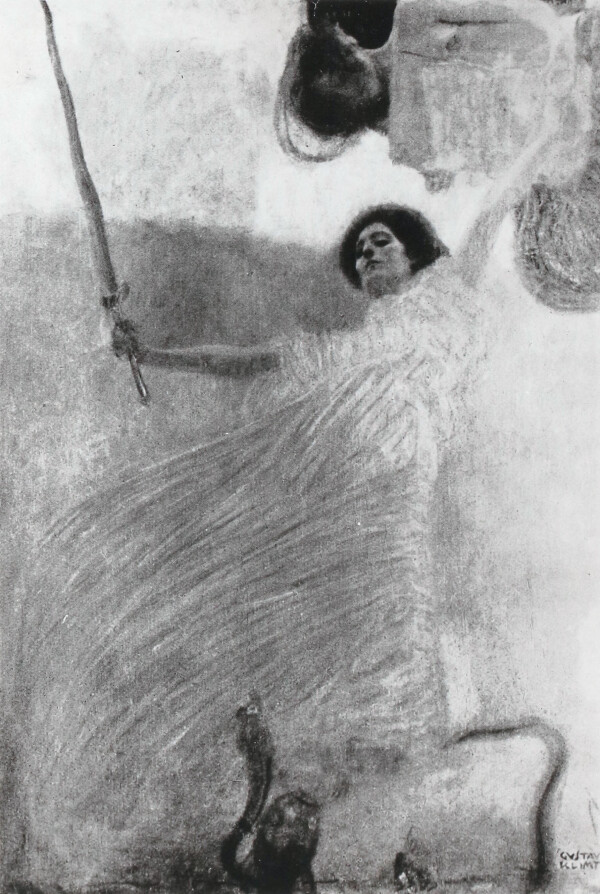
Gustav Klimt: Jurisprudence (Study), 1897/98, 1945 in Schloss Immendorf verbrannt
© Gallery Welz Salzburg
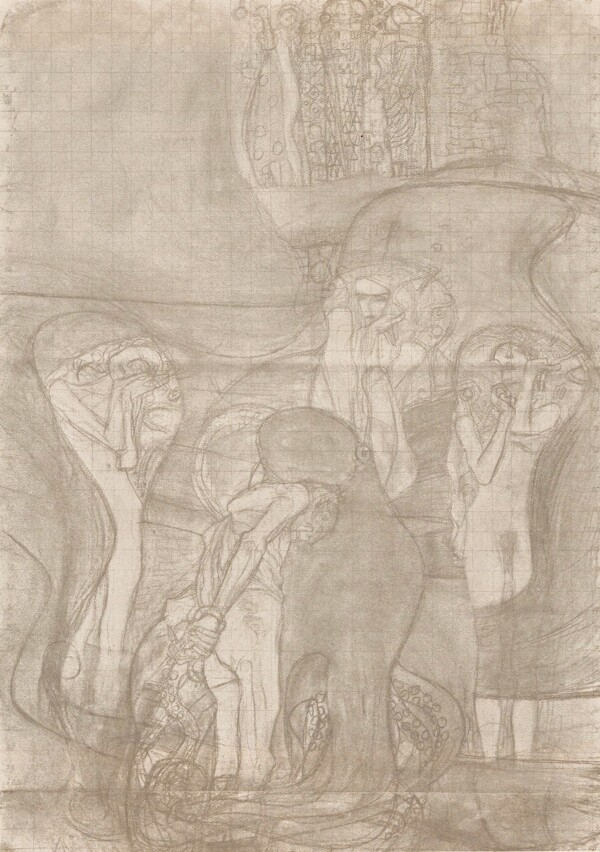
Gustav Klimt: Jurisprudence (transfer sketch), 1902/03, private collection, in: Vereinigung bildender KünstlerInnen Wiener Secession (Hg.): Ver Sacrum. Mitteilungen der Vereinigung bildender Künstler Österreichs, 6. Jg., Sonderband 3 (1903).
© Klimt Foundation, Vienna
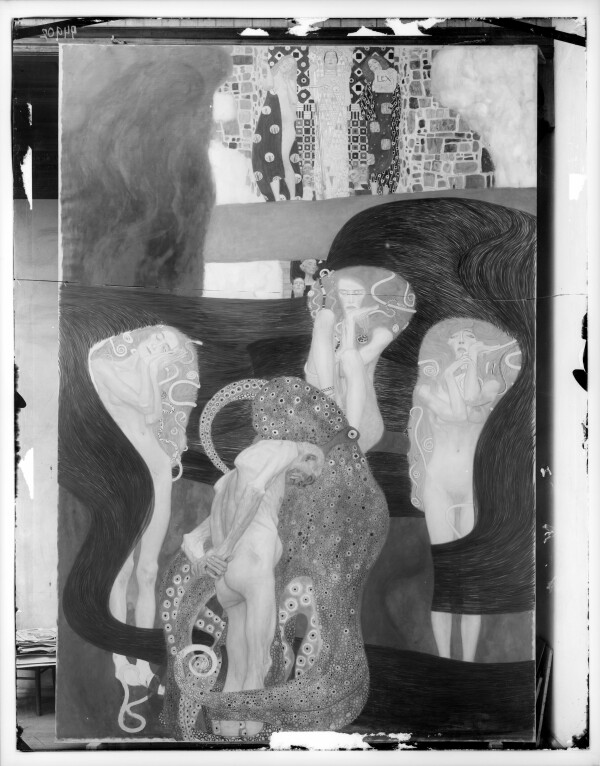
Moriz Nähr: Jurisprudence, spring 1903 - fall 1903, Österreichische Nationalbibliothek, Bildarchiv und Grafiksammlung
© Picture Archives and Graphics Department, Austrian National Library
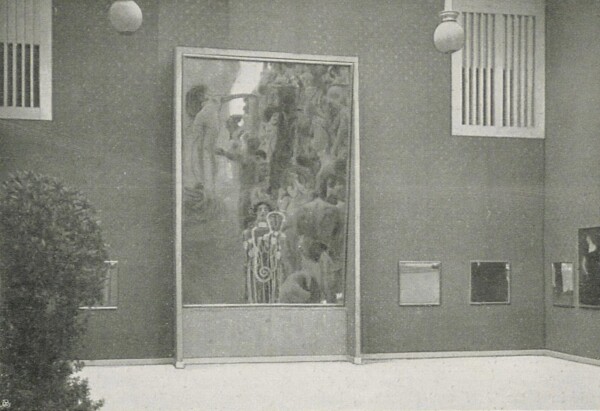
Insight into the Xth Secession Exhibition, March 1901 - May 1901, in: Die Kunst für Alle. Malerei, Plastik, Graphik, Architektur, 16. Jg. (1900/01).
© Heidelberg University Library

Insight into the VIII. International Art Exhibition in Munich, June 1901 - October 1901, Künstlerhaus-Archiv, Wien
© WStLA - Municipal and Provincial Archives of Vienna
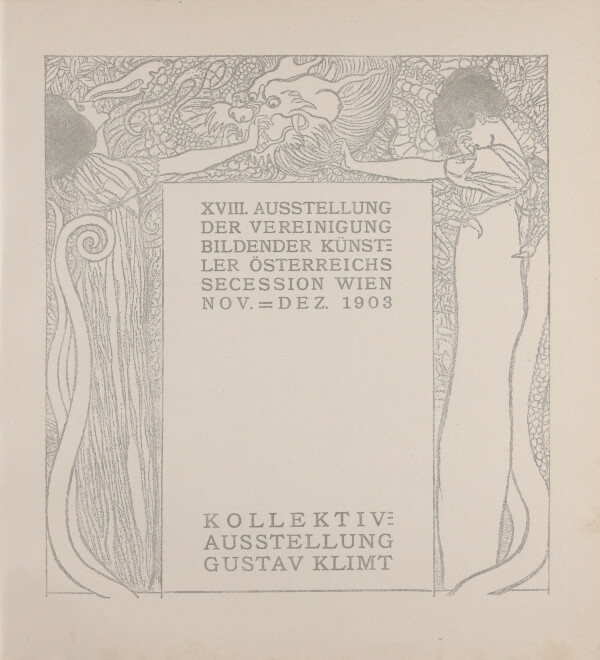
Vereinigung bildender KünstlerInnen Wiener Secession (Hg.): Ver Sacrum. Gustav Klimt. XVIII. Ausstellung Nov.=Dez. 1903 Secession Wien, Ausst.-Kat., Secession (Vienna), 15.11.1903–06.01.1904, Vienna 1903.
© Klimt Foundation, Vienna
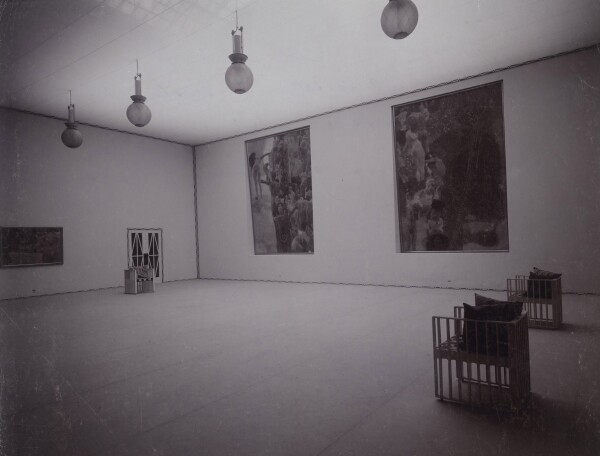
Moriz Nähr: Insight into the XVIII Secession Exhibition, November 1903 - January 1904, Österreichische Nationalbibliothek, Bildarchiv und Grafiksammlung
© Picture Archives and Graphics Department, Austrian National Library
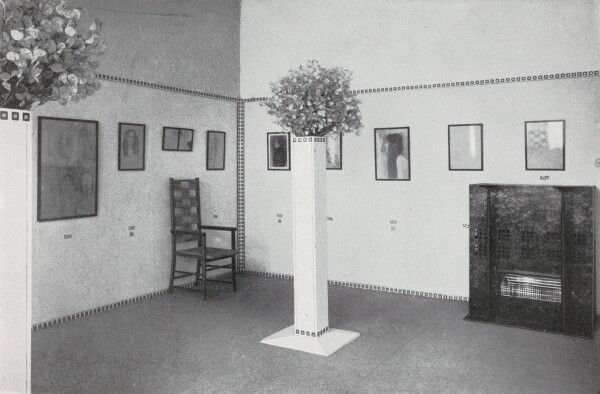
Insight into the XVIII Secession Exhibition, November 1903 - January 1904, in: Die Kunst. Monatshefte für freie und angewandte Kunst, Band 10 (1903/04).
© Klimt Foundation, Vienna
Between 1900 and 1903, Gustav Klimt worked intently on the two Faculty Paintings Medicine and Jurisprudence for the auditorium of Vienna University. When the paintings were first presented in 1901 and 1903, they caused scandals, as the Faculty Painting Philosophy had done in 1900. Following numerous alterations and additions carried out until 1907, the works were destroyed in fire at Immendorf Castle in 1945.
Medicine
Gustav Klimt epitomized Medicine (1900-1907, destroyed in a fire at Immendorf Castle in 1945) with the figure of Hygieia, the goddess of health. Seen slightly from below, she faces viewers in stringent frontality. Assuming this stance, Hygieia turns her back on suffering mankind. The Aesculapian snake is coiling around her right arm to drink from the bowl holding the water of life. Behind and above the figure of Hygieia, Klimt rendered a current of suffering mankind, with disease, pain and death – symbolized by an ailing figure and a skeleton in the upper part of the depiction – appearing within the group of mostly naked human bodies. Klimt rendered these bodies in different poses, ages and from various perspectives. In the upper right corner, we see a heavily pregnant woman with a naked belly; slightly below, a couple of men are fighting one another, while a cowering nude from behind concludes the stream of people. The left area of the painting is dominated by a hovering female nude connected to the group by her arm.
The process of creation of Medicine extended over a period of several years from the awarding of the commission in 1894: Klimt first created the oil draft for Medicine (1898, The Israel Museum, Jerusalem). This draft was heavily criticized by the academic senate as well as the artistic committee of the Imperial-Royal University of Vienna and the Imperial-Royal Ministry of Culture and Education during an “art committee meeting” held in 1898. Klimt wanted to withdraw from the commission already back then. It was only after the intervention of the department’s counselor Weckbecker, who guaranteed that his “artistic freedom” would be “respected,” that Klimt agreed to sign the final contract and promised to take the committee’s change requests into account. The oil sketch was followed by the transfer sketch executed in black chalk (c. 1900, Albertina, Vienna, S 1980: 605).
When comparing the two works’ transfer sketches, it becomes apparent that Gustav Klimt assimilated the compositions of Philosophy (1900, Wien Museum, S 1980: 477) and Medicine by dividing the stream of people among both paintings. The works were meant to be mounted as counterparts onto the ceiling of the university’s auditorium, while Jurisprudence (1903–1907, destroyed in a fire at Immendorf Castle in 1945) was to be placed opposite Franz Matsch’s Theology (1900, Vienna University). Klimt had decided on this arrangement of the Faculty Paintings already around 1898/99, as a fleeting sketch that includes the ornamental area of the ceiling (1898/99, private collection) shows. The overall concept of the stream of people was likely inspired by Auguste Rodin’s The Gates of Hell (1880–1917, Musée d’Orsay, Paris), and individual figures, too, recall Rodin’s sculptural work, which Klimt knew.
Seeing as the process of creation spanned a considerable period of time, the alterations and additions Klimt made to the Faculty Paintings reflect his artistic evolution towards Symbolism. In a letter to Maria Zimmermann, written in September 1900, he reported that he had started working on the painting. In a further letter, he mentioned the attic studio on Florianigasse he had rented specifically for the execution of the Faculty Paintings, referring to it as his “altitude studio”:
“I am toiling and sweating in my ‘altitude studio.’ I won’t go to Paris, but I might be able to steal a little more time, as our exhibition already starts in October and I absolutely won’t be finished by then with my ‘Medicine’ (the first two figures for which I ‘messed up’ yesterday, by the way).”
Klimt also wrote to the Imperial-Royal Minister of Education, Wilhelm von Hartel, informing him about his progress and asking for an extension until “mid-October,” suggesting that the minister look at the painting at the Florianigasse studio.
Gustav Klimt kept working until 1907 on Medicine, which is known to us from reproductions in four different versions. The first version – which does not yet include the baby on the outer left side of the depiction – was printed in 1901 in the 6th number of the magazine Ver Sacrum, as well as in the journal Kunst für Alle in a photograph from the presentation “X. Ausstellung der Vereinigung bildender Künstler Österreichs Secession” [10th Exhibition of the Association of Austrian Artists Secession”], held in 1901, in which the painting was shown to the public for the first time. Klimt made further alterations until 1903, resulting in a second and third version, which were both documented in photographs. The third version of the painting was presented in 1903 in an exhibition by the “Klimt Collective” at the Secession. A reproduction of this version was published in a special edition of Ver Sacrum that accompanied the exhibition. The final version of 1907 was printed in 1918 in the portfolio Das Werk von Gustav Klimt [The Oeuvre of Gustav Klimt] published with Hugo Heller art publishers. A collotype print showing a detail of Hygieia featured in the 1931 portfolio Gustav Klimt. Eine Nachlese published by Max Eisler. The color reproduction gives an impression of the painting’s glowing red color and of the sections rendered in gold. When comparing the different versions of the work, we see that Klimt added the ornamental details in gold, and exchanged the original laurel wreath worn by Hygieia with a floral headdress.
Jurisprudence
The Faculty Painting Jurisprudence (1903‒1907, destroyed in a fire at Immendorf Castle in 1945) reveals an entirely different approach to the subject than the two earlier works Philosophy and Medicine. The painted draft Jurisprudence (1897/98, destroyed in a fire at Immendorf Castle in 1945) and the transfer sketch (1902/03, private collection, S 1980: 942), drawn in 1902, have nothing in common. This illustrates the long period of time that elapsed between the works’ commissioning in 1894 and Klimt settling on the motifs and beginning the execution of the paintings. Klimt’s increasingly planar style and recourse to the “painting mosaic,” he used during what is known as his Golden Period, replaced his atmospheric, neo-Impressionist manner of painting from the fin-de-siècle and paved his way towards Symbolism. The criticism and change requests voiced by his commissioners in their 1898 “art committee meeting,” as well as the polemics against his first Faculty Paintings, had prompted Klimt to create an entirely new painting. The transfer sketch for Jurisprudence largely corresponded with the composition of the final work.
For Jurisprudence, Gustav Klimt overturned the concept he used for Philosophy and Medicine, in which the personifications of the sciences appeared in the lower edge of the depictions. He now placed the delinquent prominently into the center, surrounded by the three goddesses of vengeance from Greek mythology, the Erinyes. Far away, in the upper edge of the picture, appears the small rendering of the sword-bearing personification of justice, flanked by those of law and truth. The connection between the three goddesses of vengeance and the man, hunched with shame, is provided by a group of male heads who can be interpreted as judges. The most surprising element of this pictorial narrative is the octopus coiled around the lawbreaker.
In terms of style, the painting is shaped by Klimt’s exploration of Early Christian mosaics in Ravenna. The walls depicted in Jurisprudence reminded Ludwig Hevesi of the Upper Italian city’s architecture. The planar-linear drawing style links Jurisprudence with The Beethoven Frieze (1901/02), and was based on the style espoused by artists such as Jan Toroop and Aubrey Beardsley. The black veil, which runs like a common thread through the composition, is linked with death in reference works. The three Erinyes may either be interpreted as spawns of hell or as powers of fate from the 9th Circle of Hell from Dante’s Divina Commedia.
Even before its completion, the work was presented at the Secession in 1903, where it was photographed by Moriz Nähr likely during the preparations for the exhibition. The various stages in the execution of the painting were printed as reproductions in the magazines Ver Sacrum (1903), Die Kunst für Alle (1903/04) and in the portfolios on Klimt’s oeuvre published by Miethke (1908) and Hugo Heller (1918). There are also extant photographs showing the work in exhibitions as well as at the Villa Waerndorfer. The transfer sketch for Jurisprudence was acquired by Fritz Waerndorfer, who hung it in his villa alongside other works by Klimt, including Hope I (1903/04, National Gallery of Canada, Ottawa).
Exhibitions, Criticism and Public Rejection
The public presentation of the new ceiling painting for the Imperial-Royal University of Vienna, Medicine, in March 1901 at the “X. Ausstellung der Vereinigung bildender Künstler Österreichs” had been eagerly anticipated. Seeing as the Faculty Painting Philosophy had already sparked outrage in 1900, and the university’s committee had voiced serious concerns about the draft for Medicine in 1898, the reception of the painting was considered crucial for the success or failure of the state commission. It was presented as the main work in a reduced but impressive staging owing to the work’s tilted hanging. Klimt’s interpretation of the medical faculty, in which he juxtaposed Hygieia with the stream of mankind, made up of numerous nude figures at the mercy of death and disease, once again prompted an art scandal which now spilled over into political circles. While “only” 87 professors had opposed the hanging of Philosophy in the large ceremonial hall in a petition back in 1900, more than 20 members of parliament now brought an interpellation before the minister. Klimt was reprimanded once more for his interpretation of the theme, as well as for his supposedly negative approach to a decorative commission. While Klimt addressed the process of coming into being and passing away, he was accused of “forgetting” to depict the epochal achievements of the Viennese School of Medicine. Moreover, the public increasingly raised concerns about how the progressive paintings were actually going to look on the ceiling of the university’s auditorium:
“[…] it is meant to be placed onto the ceiling of the auditorium, together with ‘Philosophy’ and next to a painting by Matsch [...]. These works are likely to clash.”
Furthermore, the 6th issue of Ver Sacrum, which printed Klimt’s nude studies for Medicine, fell victim to censorship. The Imperial-Royal prosecution censored the magazine for breach of public morality on account of the depiction of a naked pregnant woman.
As the latest Faculty Painting Medicine was being exhibited in Vienna, Klimt sent Philosophy to Dresden, to present it to German audiences for the first time from April 1901 at the “Internationale Kunstausstellung Dresden” [“International Art Exhibition Dresden”] held at the Städtischer Ausstellungspalast.
The “VIII. Internationale Kunstausstellung im königlichen Glaspalast zu München” [“8th International Art Exhibition at the Royal Glass Palace in Munich”] was held in June 1901. The Faculty Painting Medicine provided the presentation’s indisputable highlight. A photograph of the exhibition shows the painting’s slightly tilted hanging within a box-like frame, which was reminiscent of the display technique used for the work’s earlier presentation at the “X. Ausstellung der Vereinigung bildender Künstler Österreichs.”
At the “XVIII. Ausstellung der Vereinigung bildender Künstler Österreichs Secession Wien. Kollektiv-Ausstellung Gustav Klimt” [“18th Exhibition of the Association of Austrian Artists Vienna Secession. Gustav Klimt Collective Exhibition”], which took place in November 1903, the three Faculty Paintings were presented together for the first time. They were listed in the exhibition catalogue as numbers 22, 23 and 26, and declared as “unfinished.” Klimt had worked on Jurisprudence until shortly before the exhibition opening, but the work once again drew derisive comments from the critics. On 21 November 1903, the Klimt critic Karl Kraus published the following acerbic comment in his journal Die Fackel:
“Gustav Klimt, who twice already has covered up the paleness of thought with striking colors, wanted to paint ‘Jurisprudence’ and instead symbolized criminal justice in the style of a student prank: A delinquent and a fabulous beast reminiscent of a polyp, rearing up menacingly, stand before the bar of a court of justice. Bibulous academics, who would be sure to incur a fine of ten crowns if they were to call a policeman a ‘polyp,’ may well envy Mr. Klimt for getting away with a painted insult to an official. Perceiving the powerful colors, they may delight in the painterly joke which saw the color harmony of black-red-gold, which is usually frowned upon by Austrian authorities, exploited to such felicitous effect in this ‘Jurisprudence’ commissioned by the Ministry of Education.”
Alongside the two oil drafts for Jurisprudence and Medicine, Klimt further presented studies, sketches and transfer sketches for the Faculty Paintings in his comprehensive collective exhibition. Room no. 9 featured the works on paper listed in the catalogue as “Number 60. Preparatory drawing for Jurisprudence,” “Number 62. Preparatory drawing for Medicine,” and “Number 77. Preparatory drawing for Philosophy.” It appears that the Secession had anticipated that this presentation of all the Faculty Paintings together would elicit strong reactions from the press. In the preface to the exhibition catalogue, Ernst Stöhr came to Klimt’s defense:
“As a creative and philosophizing artist, it is Klimt’s calling to execute monumental commissions, and it sounds like cruel irony that attempts are being made at preventing works – which are deserving of an honored place in the history of Austrian painting – from being hung in the place for which they were created.”
As expected, Klimt’s works provoked ample criticism as well as satirical caricatures and derision. However, Klimt’s proponents, including Ludwig Hevesi, Berta Zuckerkandl and Hermann Bahr, also made themselves heard, and defended both the artist and the freedom of the arts. At the time the collective exhibition was held, Bahr delivered his Rede über Klimt [Lecture on Klimt], and collected negative press reviews which he published in 1903 with commentaries under the heading Gegen Klimt [Against Klimt]. Berta Zuckerkandl devoted an extensive essay to the latest Faculty Painting Jurisprudence in Die Kunst für Alle, in which she gave a detailed description especially of the painting’s coloring, and further stated:
"As with the first two paintings, Klimt avoided any hint of schoolmasterly thought translation. Instead, he converted an abstract concept into something purely human.”
Further contents
-
Klimt's Artworks 1889 – 1894 (Decorator of the Ringstraße)Faculty Paintings. Awarding of the Commission
-
Klimt's Artworks 1895 – 1897 (Symbolism in Klimt’s Oeuvre)Faculty Paintings. First Sketches
-
Klimt's Artworks 1898 – 1900 (Cradle of Modernism)Faculty Paintings. Philosophy
-
Klimt's Artworks 1904 – 1906 (The Klimt Affair Surrounding the Faculty Paintings)Faculty Paintings. The Klimt Affair
Literature and sources
- Alice Strobl (Hg.): Gustav Klimt. Die Zeichnungen, Band I, 1878–1903, Salzburg 1980.
- Astrid Kury: "Heiligenscheine eines elektrischen Jahrhundertendes sehen anders aus...": Okkultismus und die Kunst der Wiener Moderne (Studien zur Moderne), Vienna 2000.
- Marian Bisanz-Prakken: Programmatik und subjektive Aussage im Werk von Gustav Klimt, in: Robert Waissenberger (Hg.): Traum und Wirklichkeit. Wien 1870–1930, Ausst.-Kat., Museums of the City of Vienna (Vienna), 28.03.1985–06.10.1985, Vienna 1985.
- Markus Fellinger, Michaela Seiser, Alfred Weidinger, Eva Winkler: Gustav Klimt im Belvedere. Vergangenheit und Gegenwart, in: Agnes Husslein-Arco, Alfred Weidinger (Hg.): Gustav Klimt 150 Jahre, Ausst.-Kat., Upper Belvedere (Vienna), 13.07.2012–27.01.2013, Vienna 2012, S. 31-281.
- Franz Servaes: Secession. Eine Porträtgalerie. Gustav Klimt, in: Neue Freie Presse, 19.03.1901, S. 1-3.
- Ludwig Hevesi: Acht Jahre Sezession (März 1897–Juni 1905). Kritik – Polemik – Chronik, Vienna 1906, S. 443-448.
- Berta Zuckerkandl: Wien.. Sezession, in: Die Kunst für Alle. Malerei, Plastik, Graphik, Architektur, 19. Jg. (1903/04), S. 162-163.
- Karl Kraus: Klimt, in: Die Fackel, 1. Jg., Heft 36 (1900), S. 16-20.
- Karl Kraus: Klimt’s »Jurisprudenz«, in: Die Fackel, 5. Jg., Heft 147 (1903), S. 10.
- Alice Strobl: Die Fakultätsbilder »Medizin« und »Philosophie«, in: Alfred Weidinger (Hg.): Gustav Klimt, Munich - Berlin - London - New York 2007, S. 41-53.
- Marian Bisanz-Prakken (Hg.): Gustav Klimt. Die Zeichnungen, Ausst.-Kat., Albertina (Vienna), 14.03.2012–10.06.2012; Getty Center (Los Angeles), 03.07.2012–23.09.2012, Munich 2012.
- Brief von Gustav Klimt an Maria Zimmermann (September 1900). S64/11.
- Brief von Gustav Klimt an Maria Zimmermann (September 1900). S63/15.
- Brief von Gustav Klimt in Wien an Wilhelm von Hartel [?] (presumably before October 1900). Autogr. 545/52-1.
- Städtischer Ausstellungspalast (Hg.): Offizieller Katalog der Internationalen Kunstausstellung Dresden 1901, Ausst.-Kat., Municipal Exhibition Palace (Dresden), 20.04.1901–03.11.1901, Dresden 1901.
- Hans Koppel: Bei Gustav Klimt, in: Die Zeit, 15.11.1903, S. 4-5.
- Vereinigung bildender Künstler Österreichs Secession (Hg.): Dritter Jahresbericht der Vereinigung bildender Künstler Österreichs Secession, Vienna 1901, S. 7-8.
Klimt-Kollektive

Gustav Klimt: Poster of the XVIII Secession Exhibition (Klimt Collective), 1903, Wien Museum
© Wien Museum
The XVIII. Ausstellung der Vereinigung bildender Künstler Österreichs Secession Wien [13th Exhibition of the Association of Austrian Artists Vienna Secession] presented a comprehensive monographic exhibition dedicated to its former president Gustav Klimt. Comprising as many as 80 works, the show offered a survey of the artist’s works created to this date. For the first time, the Faculty Paintings Philosophy, Medicine, and Jurisprudence were displayed together in an exhibition.
“This time, the [...] rooms are exclusively reigned by Klimt, whose evolution has left its imprint on the Vienna Secession. The most recent of his sensational paintings, ‘Jurisprudence,’ the third painting for the Great Hall, unfortunately still unfinished, asks the viewer new riddles, while some fifty pictures from diverse periods trace Klimt’s career and aspiration.”
The “XVIII. Ausstellung der Vereinigung bildender Künstler Österreichs Secession Wien. Kollektiv-Ausstellung Gustav Klimt” [“18th Exhibition of the Association of Austrian Artists Vienna Secession. Gustav Klimt Collective Exhibition”] opened at the Secession on 14 November 1903. From newspaper articles we know that the opening had originally been planned for 10 November. The postponement had been caused by the sudden necessity of rehanging the works. Education Minister Wilhelm Ritter von Hartel had approached Klimt and asked him to withdraw one of his new paintings, Hope I (1903/04, National Gallery of Canada, Ottawa), from the exhibition. In 1925, Berta Zuckerkandl remembered that the minister – actually an advocate of the Secession – was afraid that the picture of a pregnant woman in the nude would again cause a scandal, as had the Faculty Painting of Medicine (1900–1907, destroyed by fire at Immendorf Castle in 1945), and entail legal consequences for Klimt for violating moral law. Klimt complied with Hartel’s request, so that Hope I would only be presented six years later, in 1909, in the context of the “Internationale Kunstschau Wien.” When the “Gustav Klimt Collective Exhibition” opened, both Hartel and Klimt himself were not present.
The show, which was to offer an overview of the artist’s complete oeuvre, comprised 46 paintings, more than 35 drawings, and the Beethoven Frieze (1901/02, Belvedere, Vienna), which had been finished the previous year. After the “Beethoven Exhibition,” the frieze had remained in its place on the walls specifically for the “Gustav Klimt Collective Exhibition.”
The organization of the show had been taken over by a committee headed by Kolo Moser, Felician Freiherr von Myrbach, and Carl Moll. In a total of nine rooms designed by Kolo Moser and Josef Hoffmann, works on loan from private collections hung next to paintings that were for sale, some of which were still unfinished, so that the show provided an almost complete overview of this exceptional artist’s output.
Numerous portraits from the early period, such as Portrait of Sonja Knips (1897/98, Belvedere, Vienna) and Portrait of Anna Klimt (1897/98, whereabouts unknown) were complemented by such recent allegorical representations of women as Pale Face (1903, Neue Galerie New York, Estée Lauder Collection) and Daphne (1902/03, private collection). Well-known allegories like Goldfish (1901/02, Solothurn Art Museum, Dübi-Müller-Stiftung), which had been intended as a response to the critics of the Faculty Paintings, or Pallas Athene (1898, Wien Museum, Vienna) accompanied Klimt’s latest mystical composition From the Realm of Death (Stream of the Dead) (1903, whereabouts unknown, lost since the end of WW II in 1945). In addition, numerous new landscapes were on view, including The Golden Apple Tree (1903, destroyed by fire at Immendorf Castle in 1945), Birch Forest (Beech Forest) (1903, Paul G. Allen Family Collection), and Pear Tree (1903, Harvard Art Museums/Busch-Reisinger Museum, Cambridge, Massachusetts). Some of the artist’s most recent creations were delayed. For example, the allegory The Golden Knight (Life Is a Battle) (1903, Aichi Prefectural Museum of Art, Nagoya) was installed two weeks late, on 28 November.
Glimpses of the 18th Secession Exhibition
-
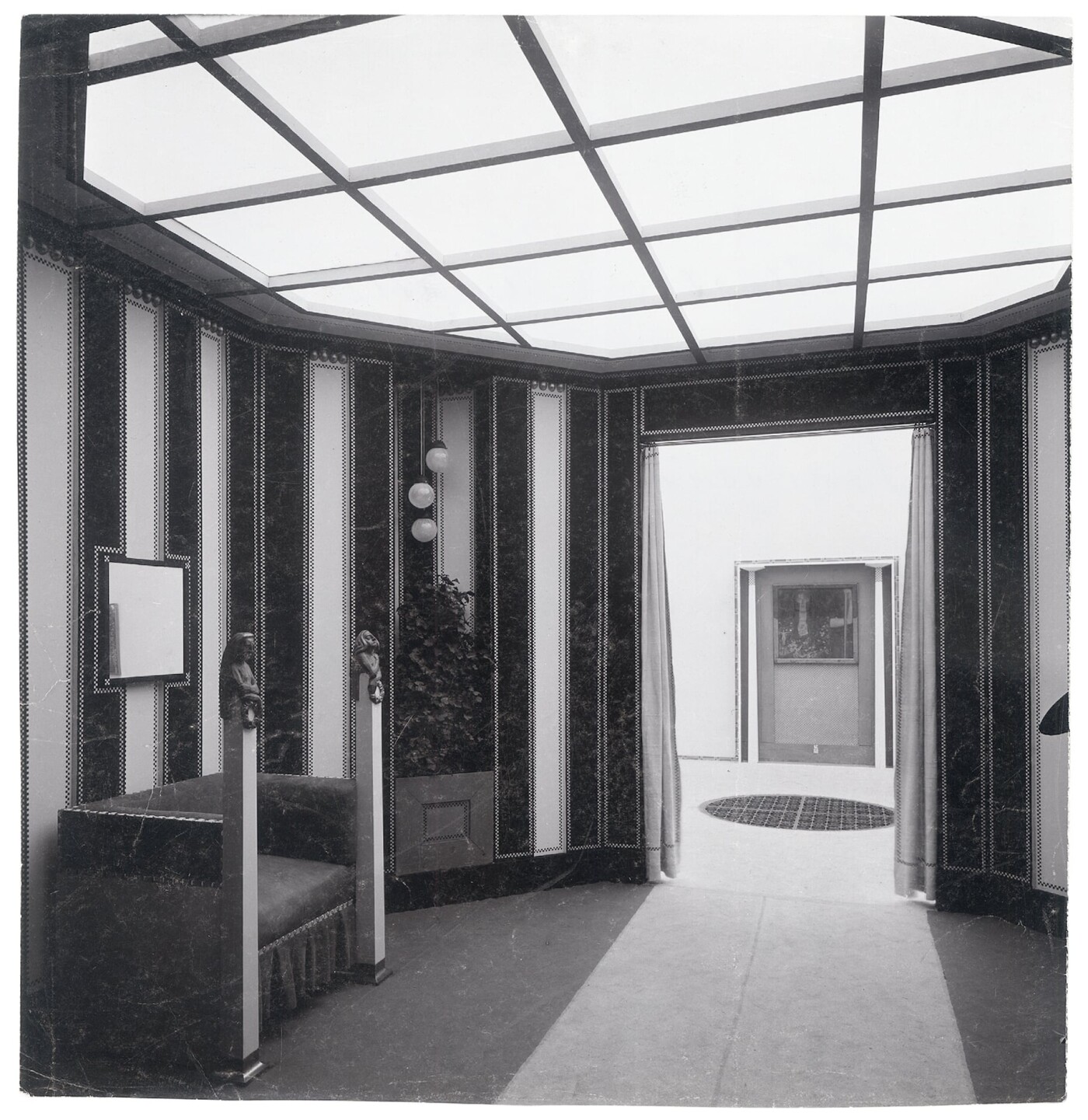 Moriz Nähr: Insight into the XVIII Secession Exhibition, November 1903 - January 1904, Österreichische Nationalbibliothek, Bildarchiv und Grafiksammlung
Moriz Nähr: Insight into the XVIII Secession Exhibition, November 1903 - January 1904, Österreichische Nationalbibliothek, Bildarchiv und Grafiksammlung
© Picture Archives and Graphics Department, Austrian National Library -
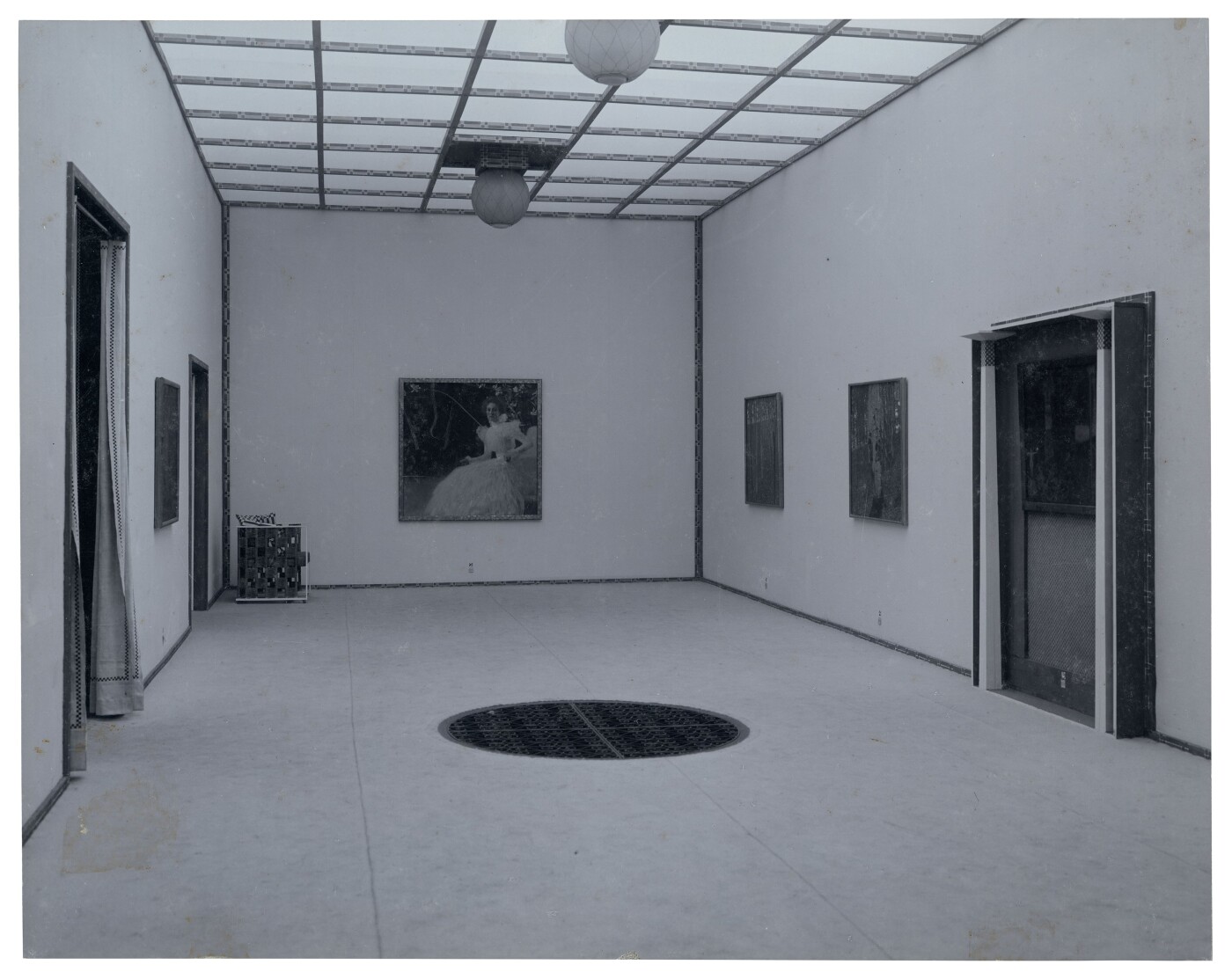 Insight into the XVIII Secession Exhibition, November 1903 - January 1904, Künstlerhaus-Archiv, Wien
Insight into the XVIII Secession Exhibition, November 1903 - January 1904, Künstlerhaus-Archiv, Wien
© WStLA - Municipal and Provincial Archives of Vienna -
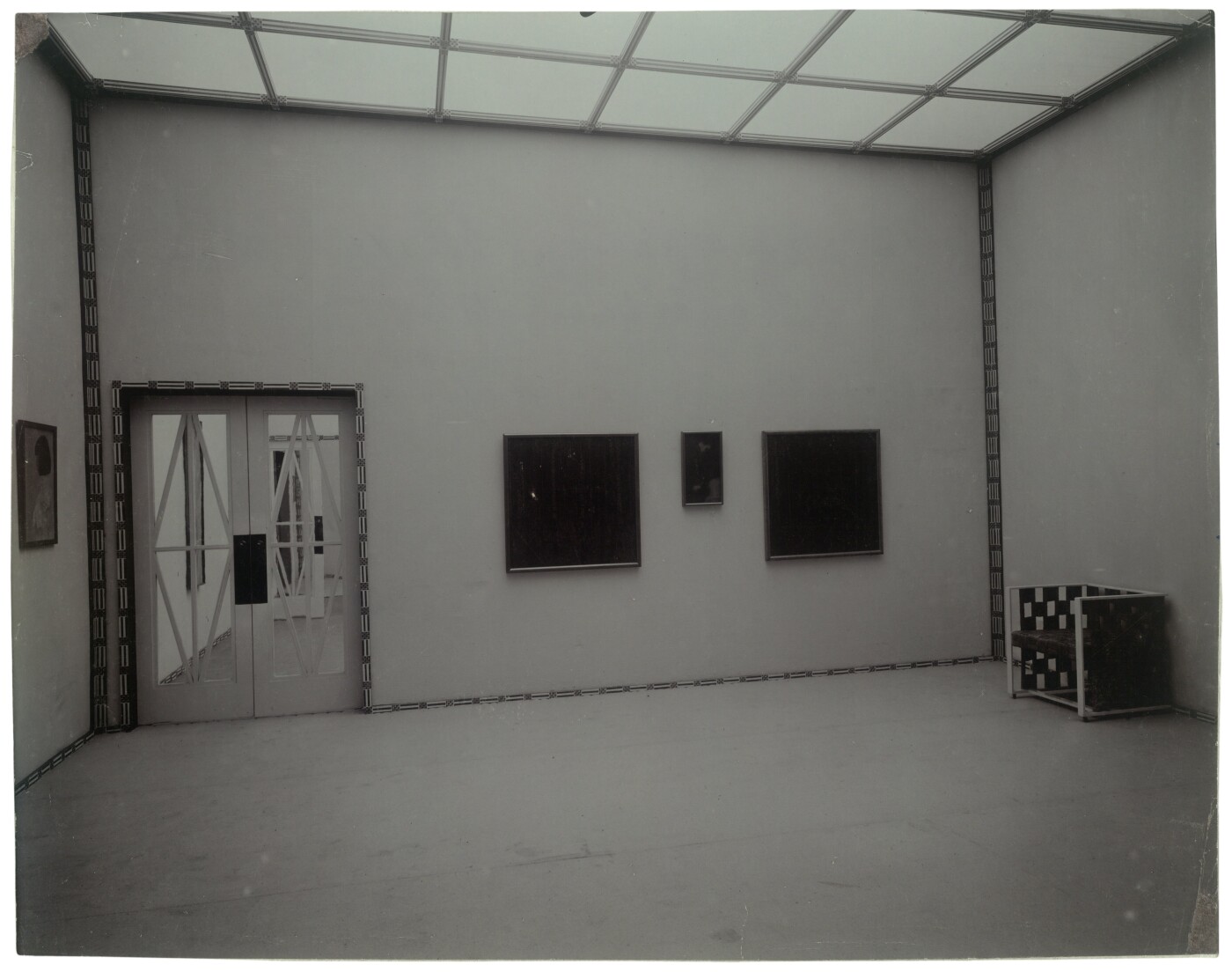 Insight into the XVIII Secession Exhibition, November 1903 - January 1904, Österreichische Nationalbibliothek, Bildarchiv und Grafiksammlung
Insight into the XVIII Secession Exhibition, November 1903 - January 1904, Österreichische Nationalbibliothek, Bildarchiv und Grafiksammlung
© Picture Archives and Graphics Department, Austrian National Library -
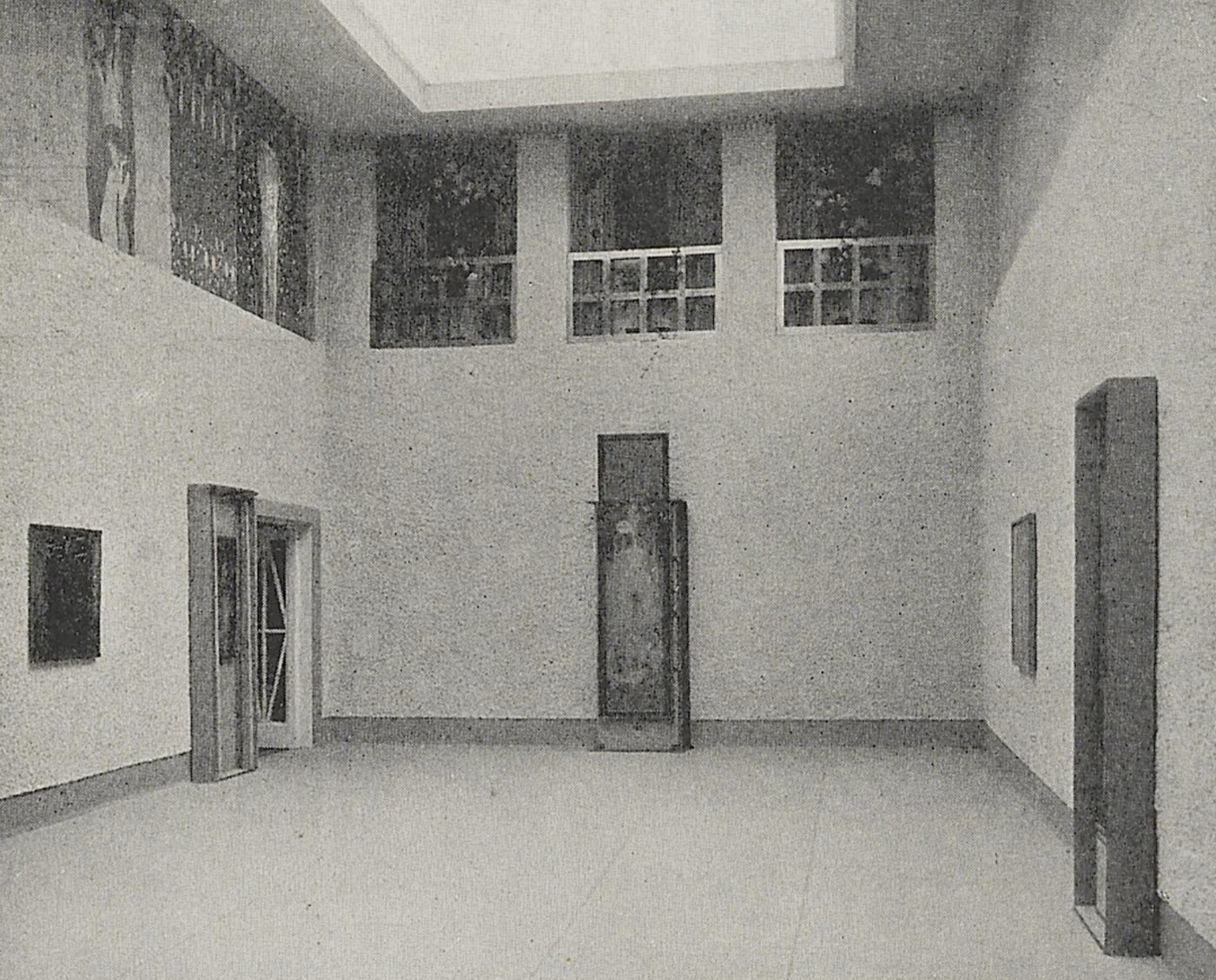 Insight into the XVIII Secession Exhibition, November 1903 - January 1904
Insight into the XVIII Secession Exhibition, November 1903 - January 1904
© Heidelberg University Library

Vereinigung bildender KünstlerInnen Wiener Secession (Hg.): Ver Sacrum. Gustav Klimt. XVIII. Ausstellung Nov.=Dez. 1903 Secession Wien, Ausst.-Kat., Secession (Vienna), 15.11.1903–06.01.1904, Vienna 1903.
© Klimt Foundation, Vienna

Moriz Nähr: Jurisprudence, spring 1903 - fall 1903, Österreichische Nationalbibliothek, Bildarchiv und Grafiksammlung
© Picture Archives and Graphics Department, Austrian National Library
“The time of the worst, fiercest struggle”
It had already become clear in the run-up that the “Gustav Klimt Collective Exhibition” meant an enormous amount of work for Klimt – far greater than for any other exhibition before. The painter had to complete all of his new works (a total of eleven) before the opening. In a letter to Maria Zimmermann, Klimt wrote about his fight with the preparations for the exhibition:
“[...] for October and early November the worst has to be expected – this will be the time of the worst, fiercest struggle – the time of greatest hardship – I will need all my strength – probably far more than I actually have [...].”
Numerous late arrivals, paintings in an unfinished state, and subsequent revisions of exhibited works bear witness to Klimt’s struggle with the final completion of his creations.
The extraordinary status of this first “Gustav Klimt Collective Exhibition” is also reflected by the exhibition catalog. Instead of an ordinary catalog, the Secession decided to dedicate a special issue of its official periodical Ver Sacrum to the show, which was richly illustrated with some 30 black and white reproductions of drawings and paintings. In addition, the show was extensively documented photographically. Numerous photographs of the exhibition rooms give an excellent impression of the hanging and make it possible to identify almost all of the paintings presented.
Jurisprudence and the Scandal about the Faculty Paintings
The critics unanimously agreed that Jurisprudence (1903–1907, destroyed by fire at Immendorf Castle in 1945) was the highlight of the exhibition. The still unfinished work was presented to the public for the first time in 1903. Klimt had worked on it until the very end, so that the canvas could only be stretched and hung in a narrow golden frame on the day before the opening. Thus, the “Gustav Klimt Collective Exhibition” was the first exhibition to feature the three ceiling paintings together. Kolo Moser’s minimalist design of the main room, which can be seen as a forerunner of the modern exhibition space of the white cube, provided the ideal background for the bright colors of the progressive paintings.
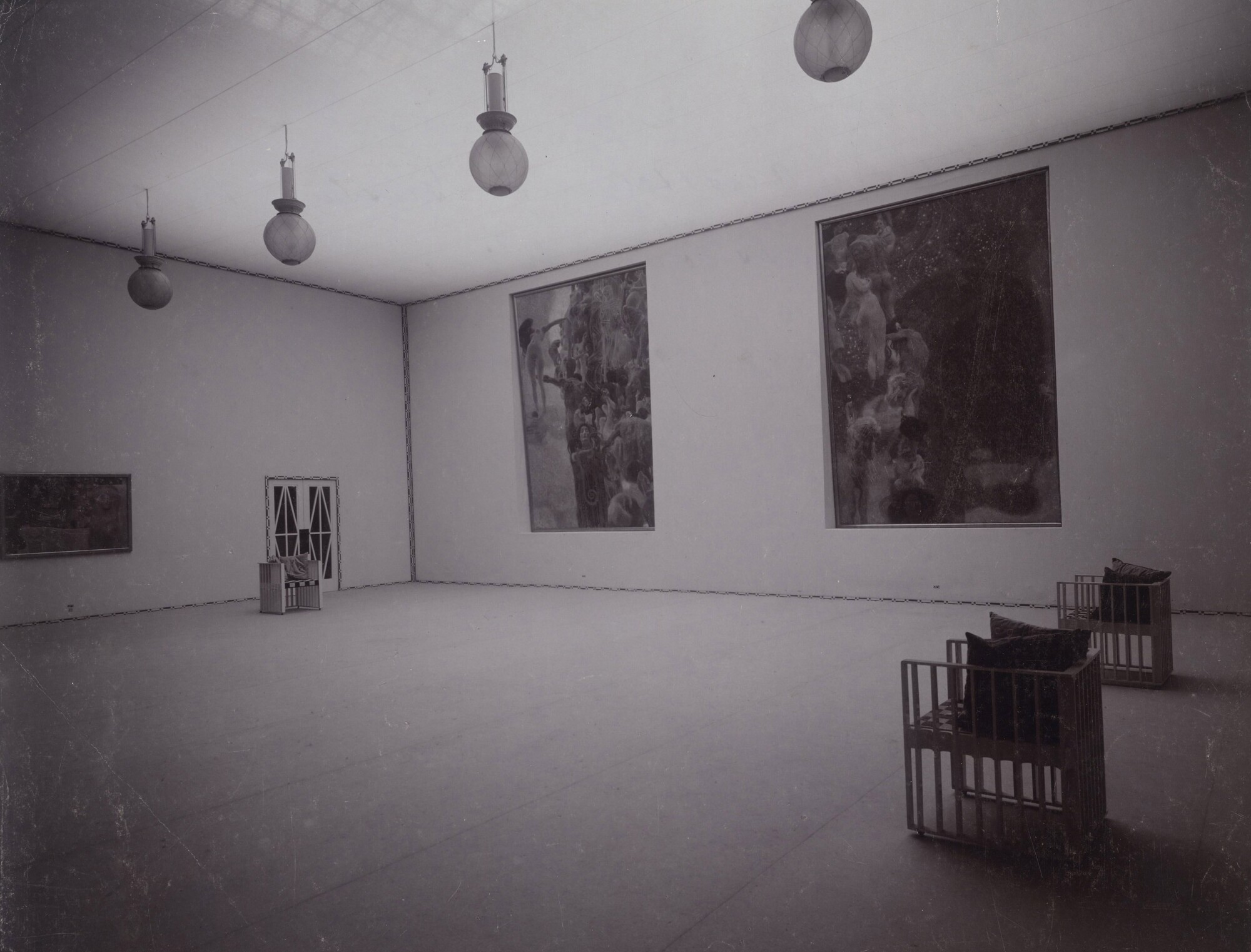
Moriz Nähr: Insight into the XVIII Secession Exhibition, November 1903 - January 1904, Österreichische Nationalbibliothek, Bildarchiv und Grafiksammlung
© Picture Archives and Graphics Department, Austrian National Library
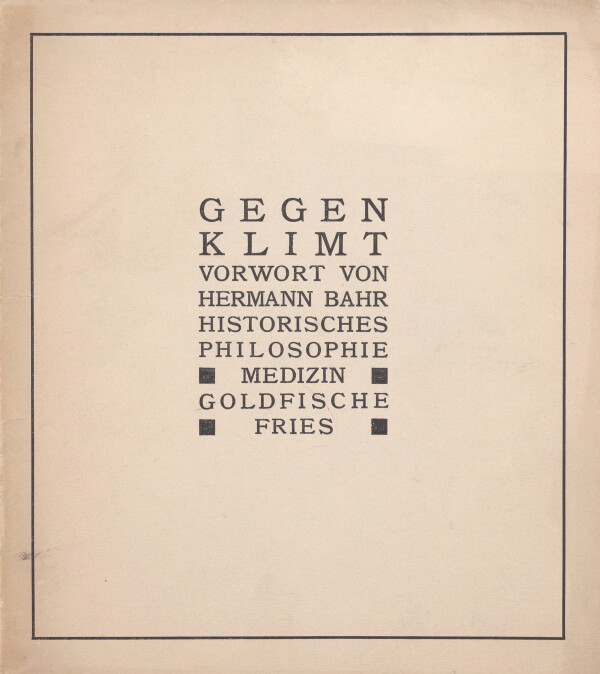
Hermann Bahr: Gegen Klimt, Vienna 1903.
© Klimt Foundation, Vienna
In previous years, there had already been fierce conflicts surrounding Klimt’s contribution to this government commission. While the “Gustav Klimt Collective Exhibition” was on, Hermann Bahr therefore published a brochure entitled Gegen Klimt [“Against Klimt”] (1903), in which he had collected and commented upon all previous critical press statements against the Faculty Paintings. The most recent developments in the scandal suggested that the paintings might not even be placed in their intended location, the University’s Great Hall. It seems that the Secession had anticipated the fierce reaction of the press to the presentation of the Faculty Paintings in their entirety, as Ernst Stöhr wrote in the preface of the exhibition catalog in Klimt’s defense:
“Klimt, an inspired and philosophizing artist, is thus destined to tackle such monumental tasks, and it sounds like a gruesome irony [...] that attempts are underway to push away works deserving a place of honor in the history of Austrian painting from the place for which they have been created.”
As expected, Klimt’s works provoked fierce criticism in the daily newspapers. Besides numerous satirical caricatures, Klimt’s paintings were also derided verbally:
“We are told to be happy about these pictures [note: the three Faculty Paintings]. So then – be happy!”
Works Sold
Nevertheless, the exhibition proved a financial success for Gustav Klimt. As early as four days after the opening, the Neue Wiener Journal wrote that 20 works had been sold at the Secession, most of them works on paper. The Golden Knight (Life Is a Battle) was purchased by Karl Wittgenstein as soon as the painting had arrived at the exhibition. Another six paintings – the landscapes Beech Forest II (Beech) (1903, unknown whereabouts) and Island in the Attersee (1902, private collection), Cows in the Stable (1899, Lentos Kunstmuseum, Linz), Pallas Athene, and the allegories Water Nymphs (Silverfish) (1902/03, Albertina, Vienna) and Realm of Death (Stream of the Dead) – were acquired by private collectors.
Literature and sources
- Hermann Bahr: Secession, Vienna 1900, S. 120, S. 123.
- N. N.: General-Versammlung der Secession, in: Neue Freie Presse, 03.05.1903, S. 10.
- Brief mit Kuvert von Gustav Klimt in Wien an Maria Zimmermann in Villach (28.10.1901). S63/32.
- Felix Salten: Gustav Klimt – Gelegentliche Anmerkungen. mit Buchschmuck von Berthold Löffler, Leipzig 1903.
- --s.: Die Klimt-Ausstellung der Secession, in: Neue Freie Presse, 14.11.1903, S. 7-8.
- Vereinigung bildender KünstlerInnen Wiener Secession (Hg.): Ver Sacrum. Gustav Klimt. XVIII. Ausstellung Nov.=Dez. 1903 Secession Wien, Ausst.-Kat., Secession (Vienna), 15.11.1903–06.01.1904, Vienna 1903.
- Anonymus: In der Secession, in: Neues Wiener Tagblatt, 29.11.1903, S. 12.
- N. N.: Wien im Zeichen der Kunst. Samstag 14. November, in: Neuigkeits-Welt-Blatt, 15.11.1903, S. 4.
- Josef Richard Liebenwein: Kunst. Hagenbund, in: Wiener Salonblatt, 14.11.1903, S. 18.
- Berta Zuckerkandl: Wer besitzt einen Klimt, in: Neues Wiener Journal, 22.08.1925, S. 6.
- N. N.: Erzherzog Karl Stefan, in: Neues Wiener Journal, 18.11.1903, S. 9.
- B. G.: Die Klimt=Ausstellung, in: Neues Wiener Journal, 15.11.1903, S. 10.
- Neues Wiener Tagblatt, 15.11.1903, S. 10.
- N. N.: Firnistag in der Sezession, in: Die Zeit, 14.11.1903, S. 3.
Exhibition Activity
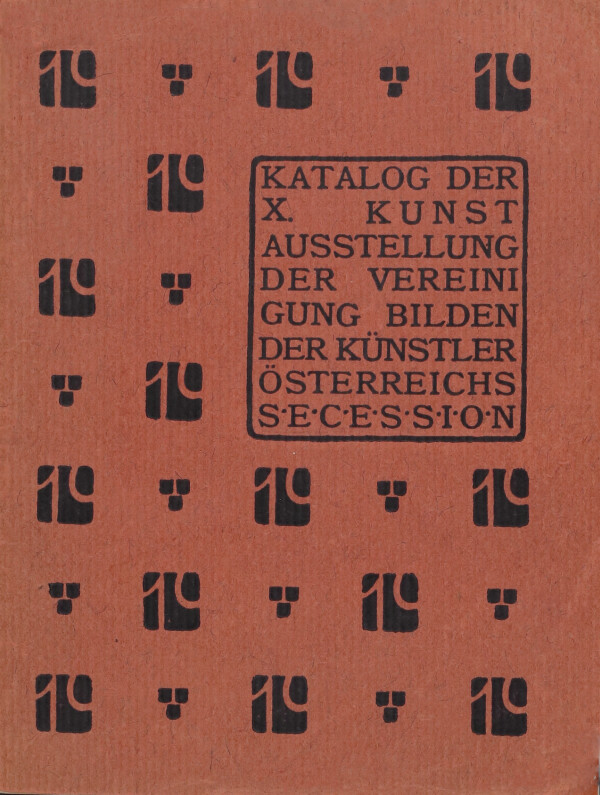
Vereinigung bildender Künstler Österreichs Secession (Hg.): Katalog der X. Kunstausstellung der Vereinigung bildender Künstler Österreichs Secession, Ausst.-Kat., Secession (Vienna), 15.03.1901–12.05.1901, 1. Auflage, Vienna 1901.
© Klimt Foundation, Vienna
Between 1901 and 1903, Klimt took part in more than twenty exhibitions. The Faculty Painting of Medicine, which was presented in 1901, caused a scandal but at the same time brought about a lively interest in Klimt as an artist both at home and abroad. The highlight during these three years full of exhibitions was certainly the “Kollektiv-Ausstellung Gustav Klimt” [“Gustav Klimt Collective Exhibition”] in Vienna in 1903.
10th Exhibition of the Vienna Secession
For Klimt, the prelude to the exhibition year of 1901 was the “X. Ausstellung der Vereinigung bildender Künstler Österreichs Secession” [10th Exhibition of the Union of Austrian Artists Secession”], which opened in March. He presented altogether nine paintings that had never been on view before. All works by Klimt were installed in the Secession’s main room (Room III), which had been designed by Kolo Moser.
In addition to the landscapes The Marshy Pond (1900, private collection), Farmhouse with Birch Trees (1900, private collection), On the Attersee (1900, Leopold Museum, Vienna), and The Large Poplar I (1900, Neue Galerie New York, Estée Lauder Collection), as well as the animal picture The Black Bull (1900, private collection), all of which had been painted in the summer of 1900 during Klimt’s vacation on the Attersee, the artist presented two of his famous female portraits. Although both pictures were merely referred to as “Ladies’ Portraits” in the catalog, the paintings can be identified thanks to two exhibition photographs. In the “Portrait Gallery,” a room specially installed for the exhibition featuring a semicircular apse, various full-length portraits of vertical format were hung in separate niches, including Portrait of Serena Lederer (1899, The Metropolitan Museum of Art, New York). The other female portrait documented by one of the photographs had been installed on the opposite side of the room and can definitely be identified as Portrait of Rose von Rosthorn-Friedmann (1900/01, private collection).
Works in the 10th Exhibition of the Vienna Secession
-
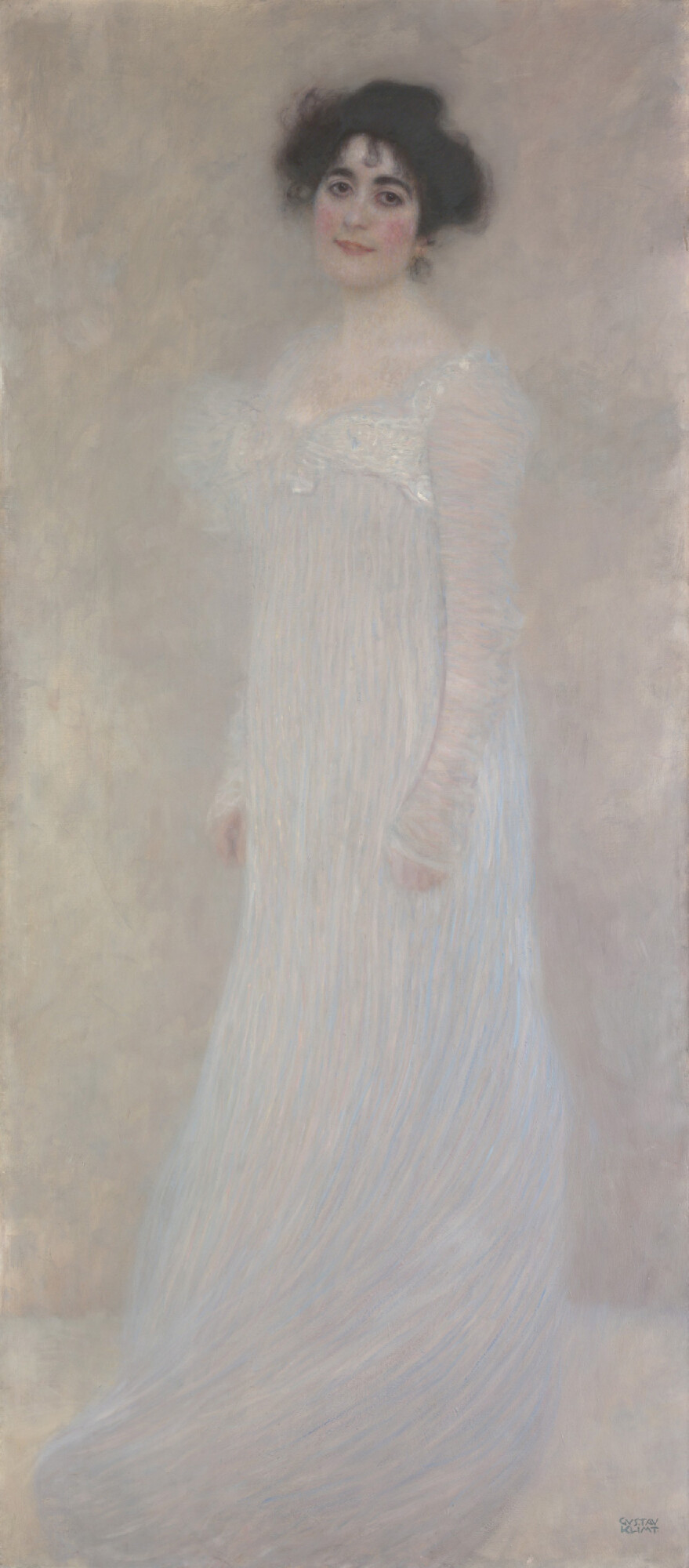 Gustav Klimt: Portrait of Serena Lederer, 1899, The Metropolitan Museum of Art
Gustav Klimt: Portrait of Serena Lederer, 1899, The Metropolitan Museum of Art
© The Metropolitan Museum of Art, New York -
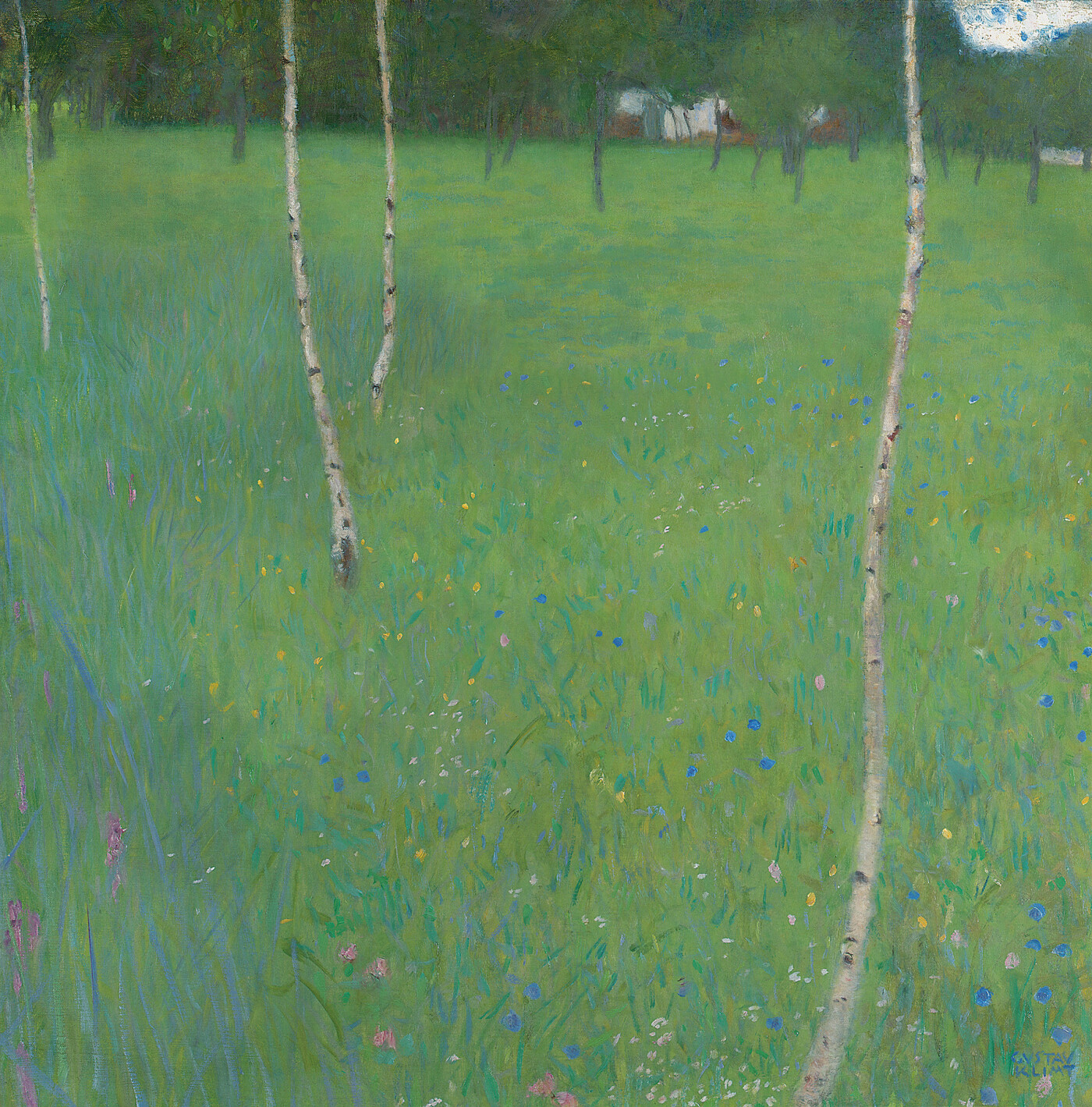 Gustav Klimt: Farmhouse with Birch Trees, 1900, private collection
Gustav Klimt: Farmhouse with Birch Trees, 1900, private collection
© Sotheby's -
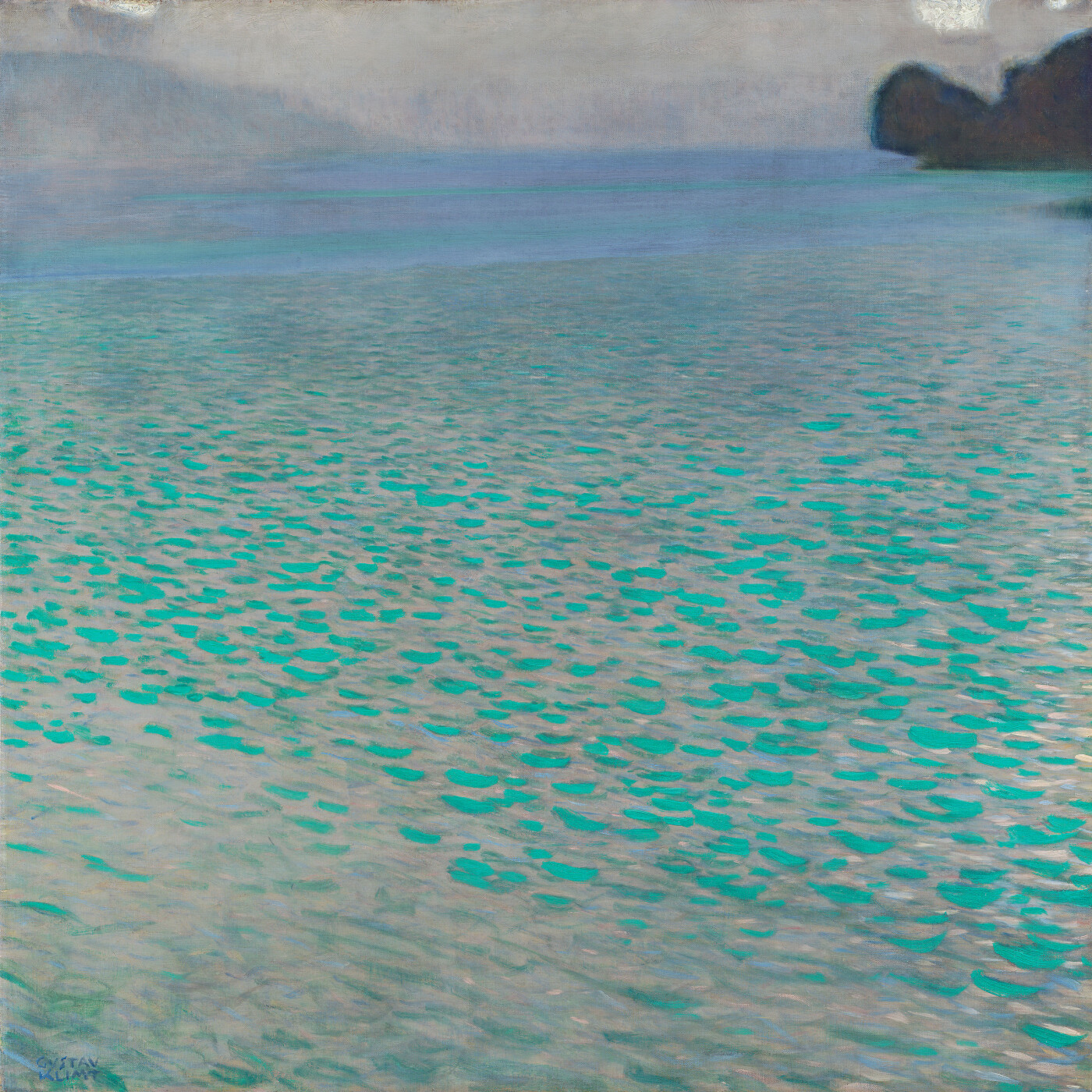 Gustav Klimt: On the Attersee, 1900, Leopold Museum
Gustav Klimt: On the Attersee, 1900, Leopold Museum
© Leopold Museum, Vienna -
Gustav Klimt: The Marshy Pond, 1900, private collection
© Bridgeman Images -
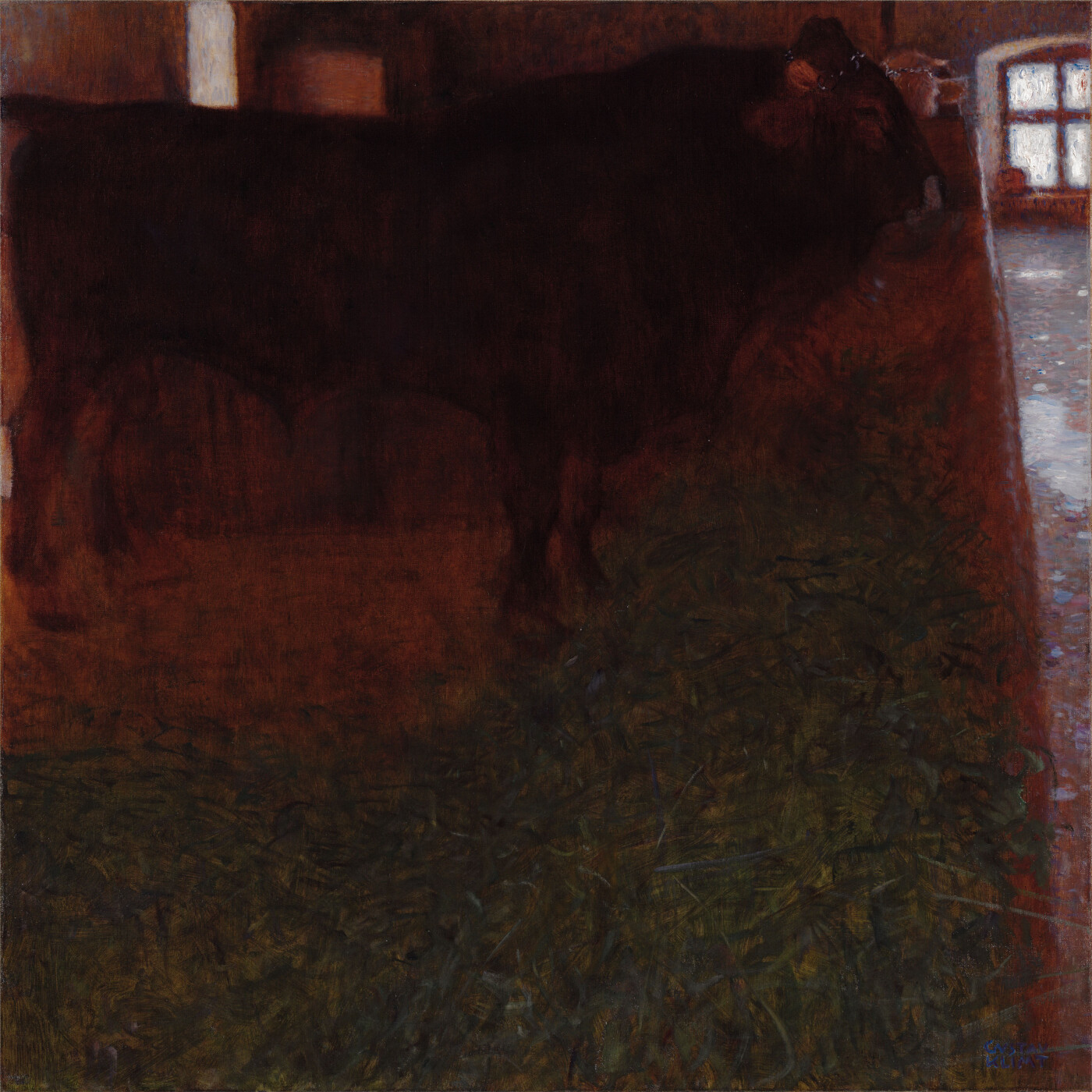 Gustav Klimt: The Black Bull, 1900, private collection
Gustav Klimt: The Black Bull, 1900, private collection
© Leopold Museum, Vienna -
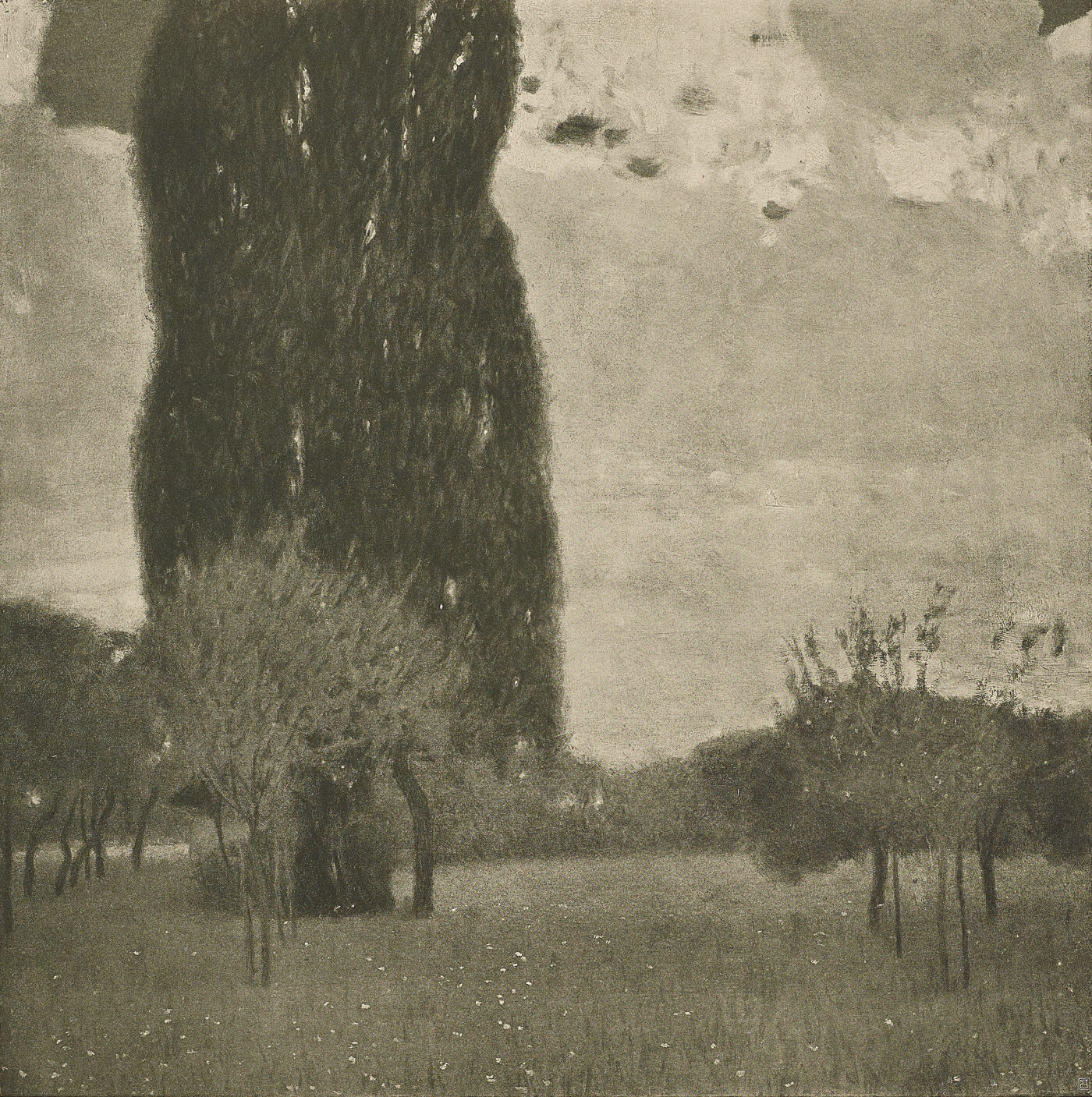 Gustav Klimt: The Large Poplar I, 1900, Neue Galerie New York
Gustav Klimt: The Large Poplar I, 1900, Neue Galerie New York
© Klimt Foundation, Vienna -
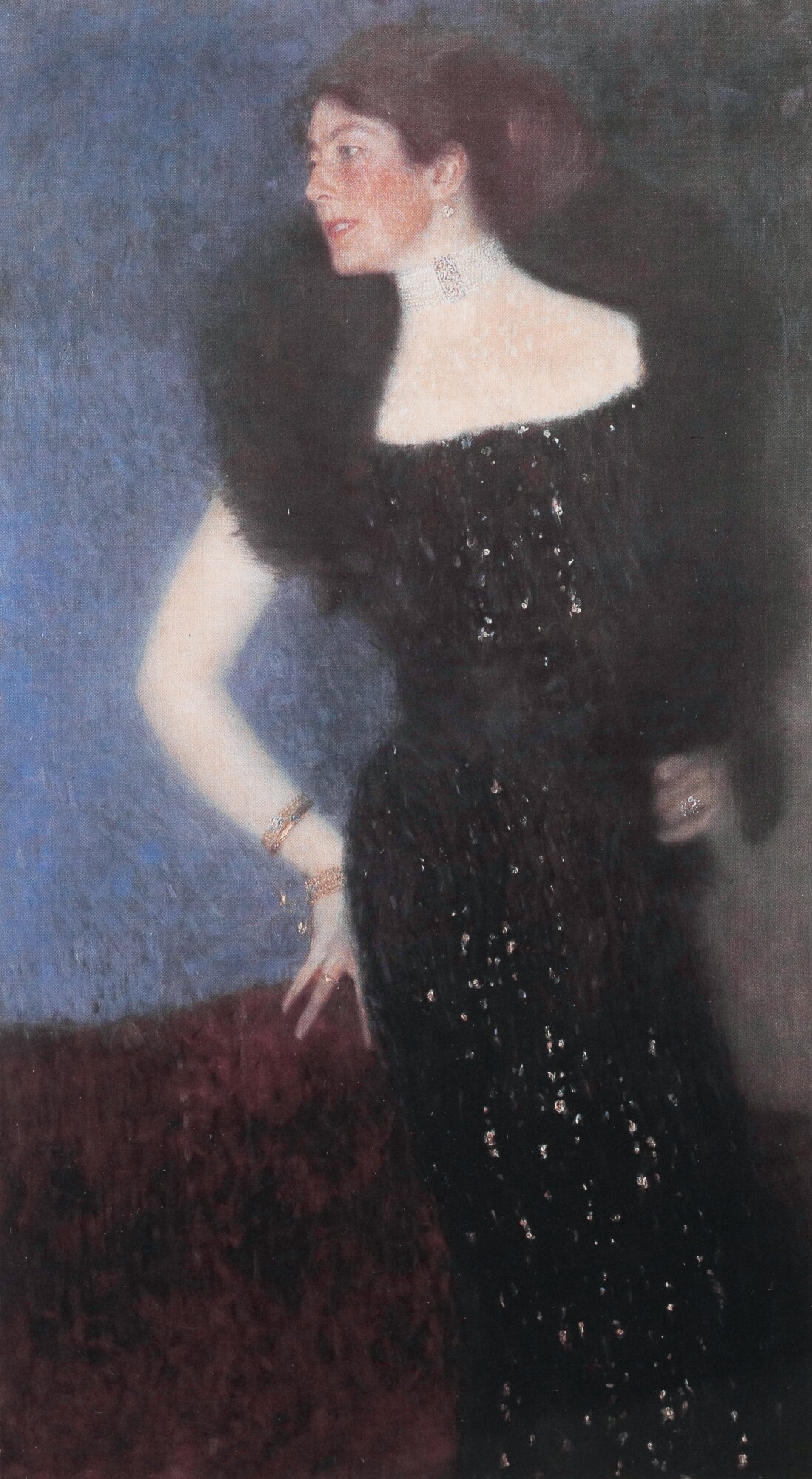 Gustav Klimt: Portrait of Rose von Rosthorn-Friedmann, 1900/01, private collection
Gustav Klimt: Portrait of Rose von Rosthorn-Friedmann, 1900/01, private collection
© Klimt Foundation, Vienna -
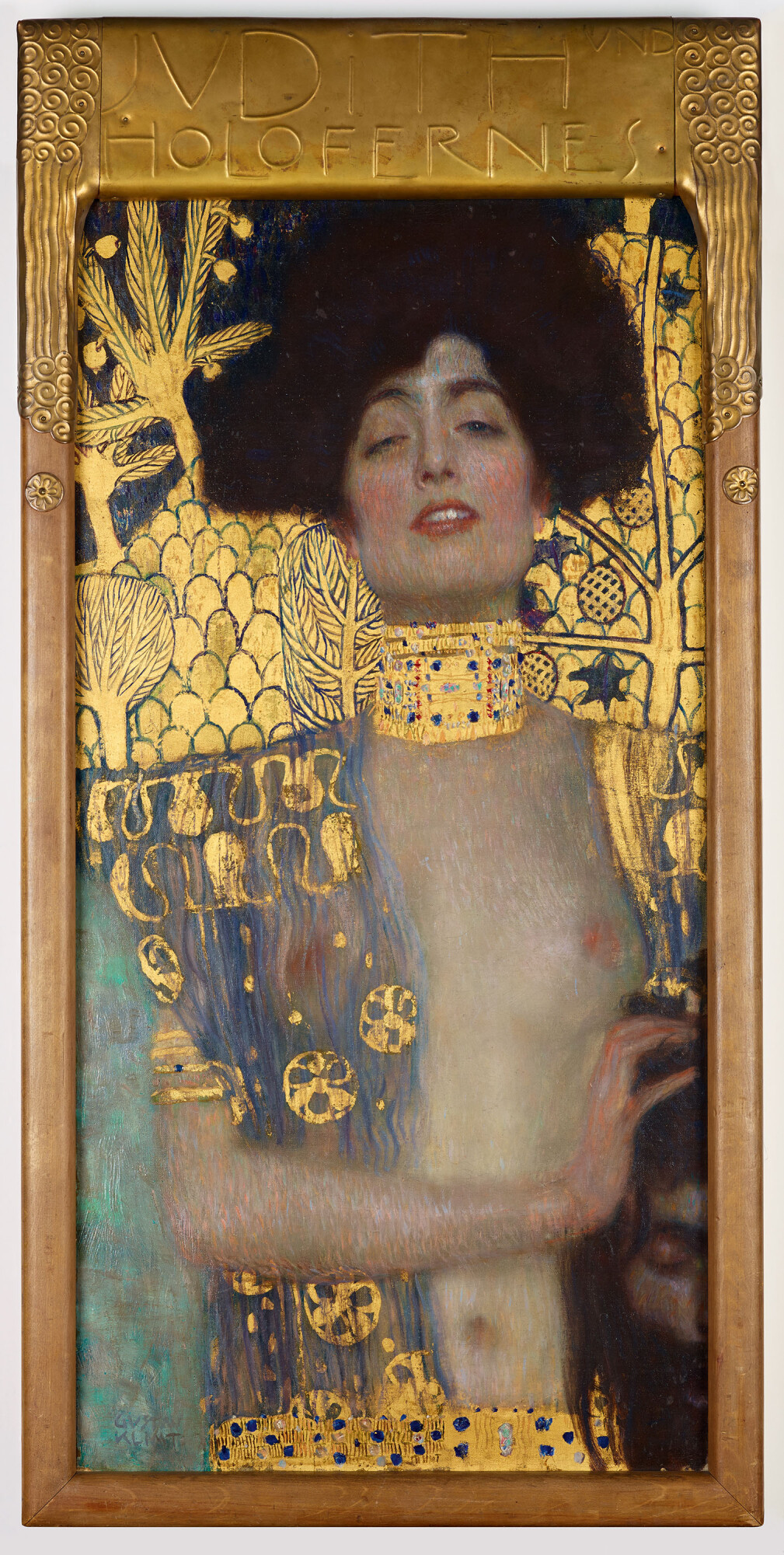 Gustav Klimt: Judith I, 1901, Österreichische Galerie Belvedere
Gustav Klimt: Judith I, 1901, Österreichische Galerie Belvedere
© Belvedere, Vienna -
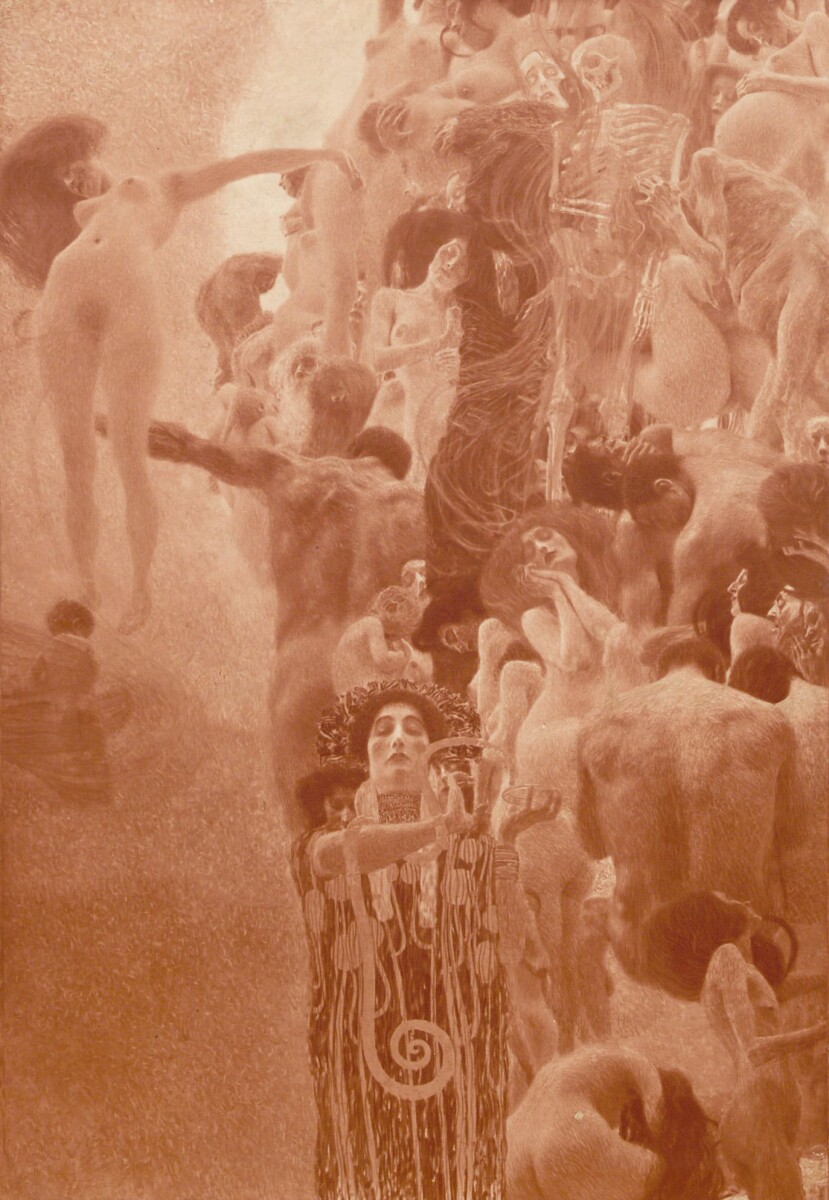 Gustav Klimt: Medicine, 1900-1907, 1945 in Schloss Immendorf verbrannt
Gustav Klimt: Medicine, 1900-1907, 1945 in Schloss Immendorf verbrannt
© The ALBERTINA Museum, Vienna

Insight into the Xth Secession Exhibition, March 1901 - May 1901, in: Die Kunst für Alle. Malerei, Plastik, Graphik, Architektur, 16. Jg. (1900/01).
© Heidelberg University Library
There can be no doubt, however, that the biggest sensation was the Faculty Painting of Medicine (1900–1907, destroyed by fire at Immendorf Castle in 1945), which was presented publicly for the first time. Medicine hung in the center of Room III, directly opposite the “Portrait Gallery” mentioned above, showcased in its own wall niche. Whereas Philosophy (1900–1907, destroyed by fire at Immendorf Castle in 1945) had caused such a scandal in 1900, the response of both the critics and the public turned out less vehement now:
“Today, all Vienna is talking about Gustav Klimt’s new ceiling painting for the University’s Great Hall. The turbulences caused by his ‘Philosophy’ the previous year seem about to erupt again these days.”
Lengthy and detailed descriptions of the painting in various newspaper articles demonstrated that the Viennese were interested in discussing its controversial motifs, even if they could not see them in situ, in the exhibition. Also, more and more people seemed to be wondering what these progressive paintings would actually look like on the ceiling of the University’s Great Hall:
“[B]ut it is to be inserted in the ceiling of the Great Hall, together with ‘Philosophy’ and next to a picture by Matsch [...]. Things may thus get jammed.”
Although the catalog only listed eight works under the name of Klimt, there is evidence to suggest that Judith I (1901, Belvedere, Vienna), which had probably just been finished, was also on view in the Secession’s 10th Exhibition, for Ludwig Hevesi wrote:
“Amidst the turbulences upsetting Klimt’s name, the imperturbable artist has completed and exhibited a new picture. A Judith. Yes, this is something we can put up with.”
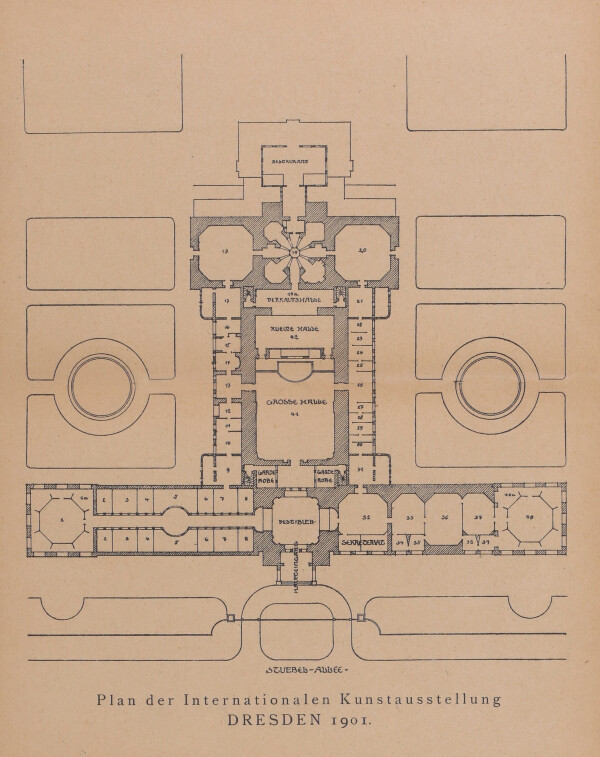
Städtischer Ausstellungspalast (Hg.): Offizieller Katalog der Internationalen Kunstausstellung Dresden 1901, Ausst.-Kat., Municipal Exhibition Palace (Dresden), 20.04.1901–03.11.1901, Dresden 1901.
© Klimt Foundation, Vienna
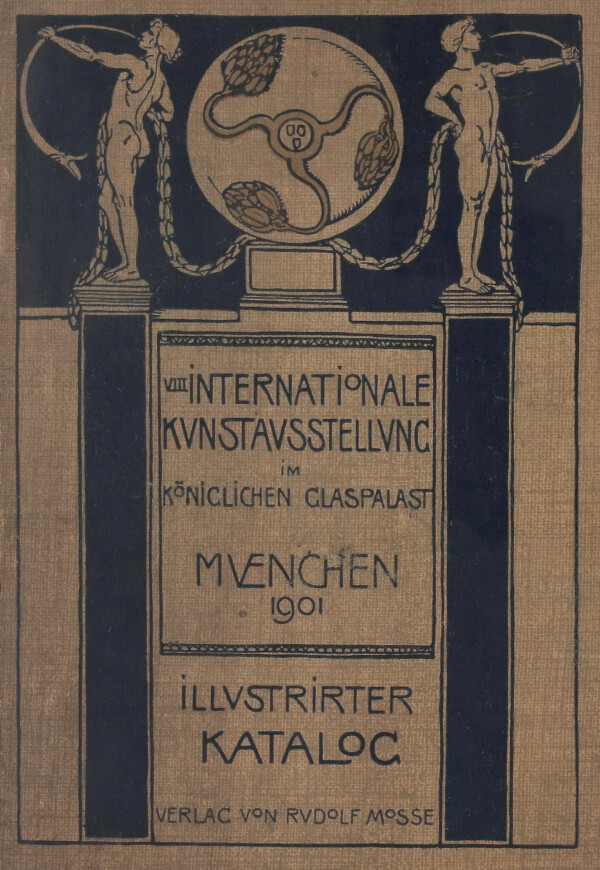
Münchener Künstlergenossenschaft (Hg.): VIII. Internationale Kunstausstellung im königlichen Glaspalast zu München 1901. Illustrirter Katalog, Ausst.-Kat., Glass Palace in Munich (Munich), 01.06.1901–31.10.1901, Munich 1901.
© Klimt Foundation, Vienna

Kolo Moser: Poster of the XIII Secession Exhibition, 1902, Museum für Kunst und Gewerbe Hamburg (MK&G)
© Museum für Kunst und Gewerbe Hamburg
This seems to be confirmed by a newspaper article saying that a “Judith” by Gustav Klimt had been sold. The buyer was the physician and art collector Anton Loew. Fritz Waerndorfer bought Farmhouse with Birch Trees. The paintings The Marshy Pond and The Large Poplar I were sold to anonymous private collectors.
International Dresden Art Exhibition
The “Internationale Kunstausstellung Dresden” [“International Dresden Art Exhibition”] took place at the Municipal Exhibition Palace from April to October 1901. Klimt was represented there with six paintings, all of which were on view in Room 18, a large octagonal room at the far end of the building.
As all of the artist’s new works were on display in Vienna, at the “10th Exhibition of the Union of Austrian Artists Secession,” which more or less took place at the same time, Klimt mostly had to resort to paintings held by private collections. Both Orchard in the Evening (1899, private collection) and A Morning by the Pond (1899, Leopold Museum, Vienna), as well as the two overdoors Music (1897/98, destroyed by fire at Immendorf Castle in 1945) and Schubert at the Piano (1899, destroyed by fire at Immendorf Castle in 1945), which had originally been intended for the music salon of Nicolaus Dumba, who had died in 1900, were on loan from private collectors. As the most recent Faculty Painting of Medicine was currently on view in Vienna, Klimt sent Philosophy to Dresden. This was for the first time that one of the Faculty Paintings was on display in Germany.
8th International Art Exhibition in Munich
In June 1901, the »VIII. Internationale Kunstausstellung« [“8th International Art Exhibition”] took place at the Glass Palace in Munich. Gustav Klimt exhibited six paintings. Room 42 had been made available to the Vienna Secession, which did not present itself as an individual group of artists but was part of the entire Austrian section.
As the “10th Exhibition of the Union of Austrian Artists Secession” in Vienna had closed the previous month, it was possible for Klimt to also present the major part of his new works abroad. Therefore, Judith I, The Large Poplar I, The Black Bull, Portrait of Rose von Rosthorn-Friedmann, and Medicine, which had already been widely admired and criticized in Vienna, could now also be introduced to a German audience. Furthermore, Klimt presented a design for his overdoor Music (Study) (1895, Bayerische Staatsgemäldesammlungen, Neue Pinakothek, Munich), as the final work was currently in Dresden.
Yet the undisputed highlight was once more the new Faculty Painting of Medicine. An exhibition view shows the painting hanging in the room dedicated to the Vienna Secession, where it was installed directly opposite the entrance. Unlike other works in the room, it hung in its own flat box painted in neutral colors. Thanks to the chromatic separation of the picture from the walls otherwise covered with patterned wallpaper, the monumental work stood out all the more. Use had thus been made here of a presentation strategy that had also been chosen for the “10th Exhibition of the Vienna Secession.”
In the course of the show, one of Klimt’s works was bought for Germany. Originally, the Bavarian government had been interested in the painting Judith I, but as it had been sold at the Secession’s exhibition in Vienna, Music (Study) was acquired instead for the Neue Pinakothek in Munich.
13th Exhibition of the Vienna Secession
Klimt showed as many as eight paintings at the Vienna Secession’s 1902 spring exhibition. Like in the previous year, most of them were landscapes painted during his summer vacation on the Attersee. Kolo Moser had been in charge of both the exhibition and complete graphic design. Two photographic glimpses into Room I, where Klimt’s works were installed, show a plain room covered with monochrome wallpaper, the only embellishment of which was a border of squares. Against this neutral background, Klimt presented the two forest pictures Pine Forest I (1901, Kunsthaus Zug, Stiftung Sammlung Kamm) and Pine Forest II (1901, private collection), as well as Fruit Trees (1901, private collection) and Farmhouse in Kammer on the Attersee (Mill) (1901, private collection). Pine Forest I and Farmhouse in Kammer on the Attersee came into private hands in the course of the exhibition.
A special hanging was found for the three paintings Lake Shore with Birch Trees (1901, private collection), Birch Tree on the Attersee (Calm Water) (1901, unknown whereabouts), and Portrait of Marie Henneberg (1901/02, Kulturstiftung Sachsen-Anhalt – Kunstmuseum Moritzburg Halle (Saale)). One of the two exhibition photographs mentioned above shows that the still unfinished portrait of Mrs. Henneberg (the armchair was adumbrated but not yet finished) was flanked on the left- and right-hand side by the two landscapes in the style of a triptych. As with Pine Forest I and Pine Forest II, catalog numbers 32 and 34, “Calm Water” and “Lake Shore” were different views of the same subject: a small pond with birch trees in the Attersee region. The two paintings had been lost for a long time. Whereas Lake Shore with Birch Trees was recently rediscovered, its pendant, which after Klimt’s death was owned by his niece, Helene Donner, remains untraceable.
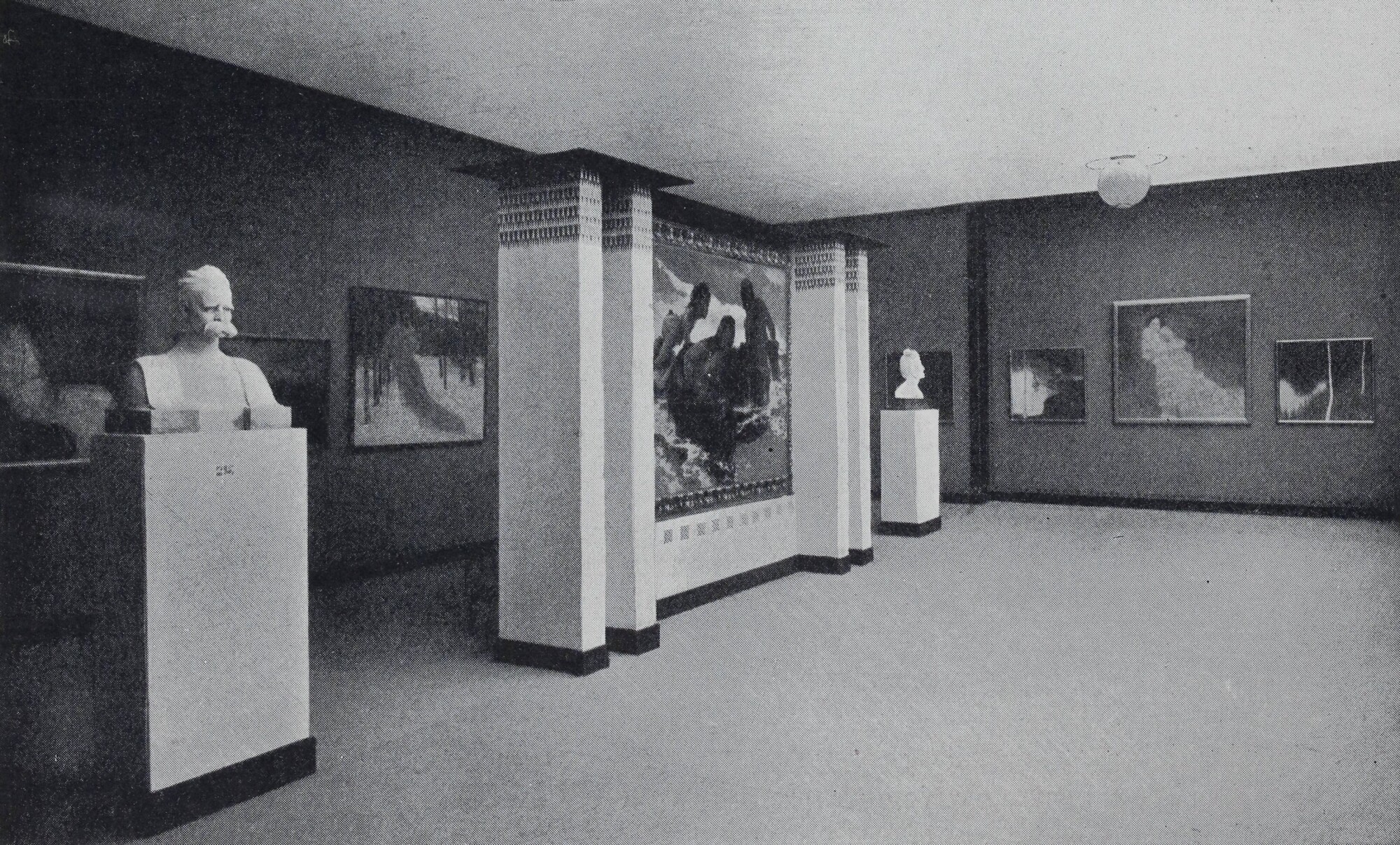
Insight into the XIII Secession Exhibition, February 1902 - March 1902
© Klimt Foundation, Vienna
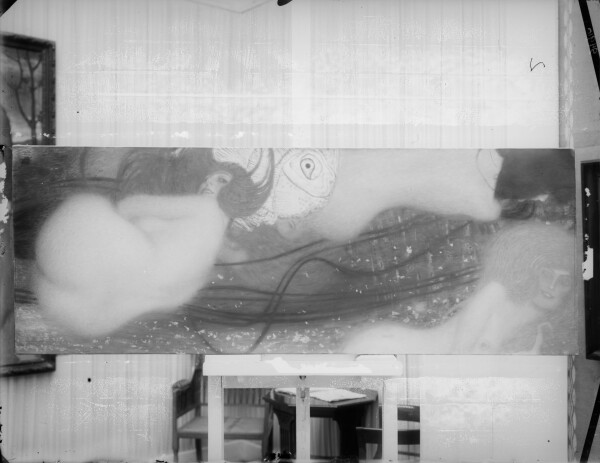
Moriz Nähr: Goldfish, 1902, Österreichische Nationalbibliothek, Bildarchiv und Grafiksammlung
© Picture Archives and Graphics Department, Austrian National Library
The highlight of the Secession’s 13th Exhibition was the painting Goldfish (1901/02, Kunstmuseum Solothurn, Dübi-Müller Stiftung). According to newspaper articles, the work had not been completed by the time the exhibition opened, and an empty stretcher covered with textile fabric functioned as its placeholder. When the painting was finally delivered on 13 February – after a delay of almost two weeks – it provoked sharp criticism and was referred to as the “product of the most perverted taste.” It was mainly the figure of the naked mermaid, turning her derrière on the viewer, that caused indignation:
“At first you think to perceive a balloon, but when taking a closer look you will realize that it’s the enormous part of a female character – I cannot say which part it is, but it is not the face. As this noble part is also covered with rash, the suspicion arises that one is confronted with a study for Mr. Klimt’s famous ‘Medicine.’”
Some reviewers understood the painting as Klimt’s impolite response to the hostile criticism voiced the previous year when his Faculty Painting of Medicine had been presented for the first time. Ludwig Hevesi remembered that Klimt took Goldfish back to his studio several times while the exhibition was still on in order to continue working on it. This appears to be confirmed by one of Moriz Nähr’s photographs showing the work in the exhibition rooms. Said picture, which was probably taken when the hanging of the painting was planned in mid-February, indeed shows Goldfish in a state not yet final.

Moriz Nähr (?): Insight into the XIV Secession Exhibition, April 1902 - June 1902
© Heidelberg University Library
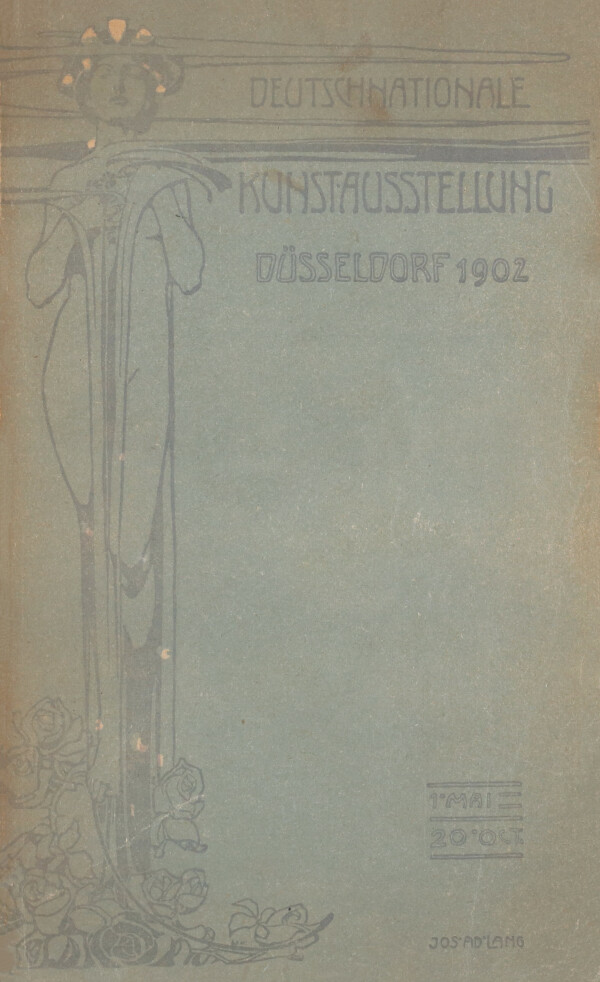
N. N.: Katalog der Deutsch-Nationalen Kunstausstellung. Düsseldorf 1902, Ausst.-Kat., Municipal Art Palace (Düsseldorf), 01.05.1902–20.10.1902, Düsseldorf 1902.
© Klimt Foundation, Vienna
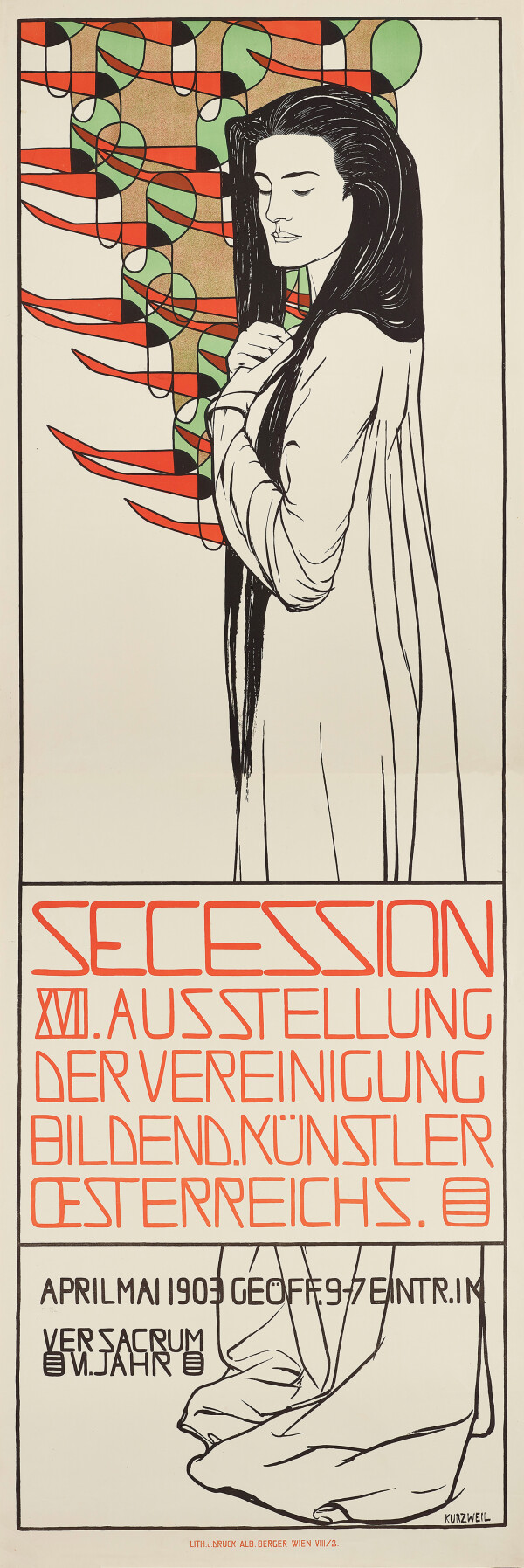
Maximilian Kurzweil: Poster of the XVII Secession Exhibition, 1903, Klimt Foundation, Vienna
© Klimt Foundation, Vienna
Klinger-Beethoven Exhibition at the Vienna Secession
In April 1902, the Union of Austrian Artists presented a special theme exhibition. The year before, its members had decided to refrain from featuring individual works by a number of artists, as was usually the case. Instead, it was the goal of the show to present each room according to a holistic concept. The overall artistic direction of this “spatial art” was entrusted to Josef Hoffmann. A specially conceived festival architecture that could be adapted as needed was installed in the Secession building. Ludwig Hevesi appropriately referred to it as “temple architecture.” The focus of the exhibition was on the Beethoven monument by sculptor Max Klinger. The other artists ware asked to conceive their works so as to complement this monumental statue and thus pay tribute to the artist. As an exhibition of this type was an absolute novelty on the Viennese art scene, the catalog contained detailed explanations of the overall artistic concept. Klimt’s contribution to this show was the monumental Beethoven Frieze (1901/02, Belvedere, Vienna). A multimedia work of art, it was meant to symbolize composer Ludwig van Beethoven’s Symphony No. 9.
German National Art Exhibition in Düsseldorf
In May 1902, the “Deutsch-nationale Kunstausstellung” [“German National Art Exhibition”] took place at the specially built Municipal Art Palace in Düsseldorf. Four rooms were assigned to the Vienna Secession. While the largest one accommodated the paintings, works of applied art were presented in the remaining rooms. Klimt sent six paintings to the exhibition, including two new landscapes, Lake Shore with Birch Trees and Farmhouse in Kammer on the Attersee, as well as the allegory Goldfish, which had met with rejection and protests in Vienna at the beginning of the year.
In Germany, Klimt’s work was not received any more enthusiastically. According to Bertha Zuckerkandl, a writer and close friend of the artist, the organizers of the exhibition urged the Austrian Ministry of Culture and Education to take down Goldfish, as they were afraid that the German crown prince would be taken aback at the sight of this vulgar picture. When Crown Prince William attended the opening on 1 May, however, Goldfish was still in situ.
17th Exhibition of the Vienna Secession
The “XVII. Ausstellung der Vereinigung bildender Künstler Österreichs Secession” [“17th Exhibition of the Union of Austrian Artists Secession”] opened on 26 March 1903. As he had done in previous years, Klimt seized the opportunity to introduce his latest works to Viennese society. Different from past years, however, the number of works he presented, amounting to three, was relatively modest. Planning for the big “Kollektiv-Ausstellung Gustav Klimt” [“Gustav Klimt Collective Exhibition”], scheduled for the end of the year, had probably begun by then, and the artist saved the major part of his new works for this one-man show. The exhibition at the Secession thus only presented the two landscapes Beech Forest I (1902, Staatliche Kunstsammlung Dresden) and catalog number 130, “A Summer’s Day,” as well as the allegorical painting Will-o’-the-Wisp (1903, private collection).
The exhibition aimed to present the works in such a way that one would be able to visualize their decorative effect in private interiors. For this purpose, the Secession’s exhibition facilities were divided into numerous small units, each of which introduced only one or a few artists. For lack of space, the usual gallery principle was retained for two common areas. All of Klimt’s works were installed in such a common area, Main Room 9, which was designed by Leopold Bauer. On the very first day of the exhibition, 22 paintings were sold, including Klimt’s Will-o’-the-Wisp.
The painting “A Summer’s Day” also found a buyer. Up to now, it has not been possible to identify this work with any known Klimt painting. Thanks to Ludwig Hevesi’s description, however, we know that it showed “scenery from the Attersee region.
“a large, colorfully flowering meadow, what seems to be a detailed view of nature, but is actually full of pleasant coincidence and sparkling caprice [...].”
A newspaper article reporting on the sale of the picture also referred to it as a meadow. In an autograph note to Maria Zimmermann from his summer vacation of the previous year, Klimt wrote that he painted “a landscape from the window of my room in gloomy weather.” Both the description of the bleak sky and flowering meadow and the elevated vantage point comply with a painting research has always referred to as Orchard (1907, Carnegie Museum of Art, Pittsburgh). So it seems that Orchard and A Summer’s Day, which was first exhibited in 1902, are very likely one and the same painting, which consequently does not date from 1907 (this date has always been called into question and revised by scholars), but was actually painted in 1902 during Klimt’s summer vacation on the Attersee.
Due to tourism and its resulting high attendance, the exhibition was prolonged over the Whitsun week.
Medicine Damaged in Prague
At the “64. Jahresausstellung des Kunstvereins für Böhmen” [“64th Annual Exhibition of the Bohemian Art Club”] in Prague in 1903, the German-Bohemian Artists’ League, of which Klimt was a member due to his father’s origins, exhibited as a cooperative for the first time, although it presented primarily German-speaking artists. Next to Klimt, Richard Teschner and Emil Orlik were represented with their works. Gustav Klimt sent his latest ceiling painting, Medicine, for the University of Vienna’s Great Hall. A newspaper article suggests that the painting was damaged while it was shown in the exhibition. In an interview with the Neue Freie Presse of 12 April 1905, Gustav Klimt said that one of his paintings for the Great Hall had been damaged in the “Prague exhibition.” As the “Annual Exhibition of the Bohemian Art Club” of 1903 was the only exhibition held in Prague before 1905 for which records mention the presentation of a painting by Klimt, the painting in question must have been Medicine.
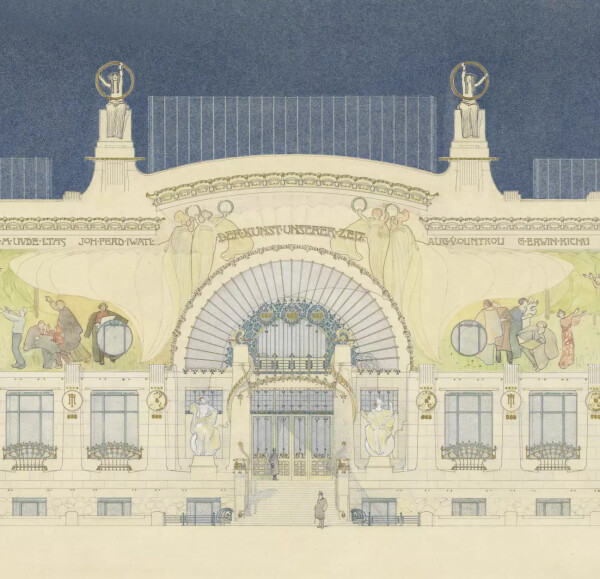
Otto Wagner: Design for the Modern Gallery, 1900
© Wien Museum
Gustav Klimt and the Modern Gallery
Aside from the major exhibitions at home and abroad, the Modern Gallery at the Lower Belvedere (now Österreichische Galerie Belvedere) opened its doors in 1903. In the years before, various artists, especially Carl Moll and Gustav Klimt, had spoken up for the foundation of a collection that would primarily devote itself to contemporary art. For this purpose, the Imperial-Royal Ministry of Culture and Education, supported by the Union of Austrian Artists, had acquired works by national and international artists of the younger generation from various exhibitions. From the exhibitions at the Secession, the following works by Gustav Klimt had been purchased: After the Rain (Garden with Chickens in St. Agatha) (1898, Belvedere, Vienna) in 1900, the painting On the Attersee in 1901, and Portrait of Josef Lewinsky as Carlos in Clavigo (1895, Belvedere, Wien) the subsequent year.
Originally, the Modern Gallery was to receive a building of its own in the process of the erection of a new Municipal Museum (now Wien Museum). However, construction work was delayed, as the architectural proposal by Otto Wagner had been rejected. Therefore, just parts of the holdings of the Modern Gallery were made accessible to the public without further ado on 7 May 1903 in the Lower Belvedere’s staterooms. The presentation of the exhibition was a makeshift solution, as it could neither be installed in the envisaged rooms, nor was it possible to show the complete holdings (for lack of space). Critics, however, complained above all about the distracting impact of the Baroque staterooms on the modern works of art.
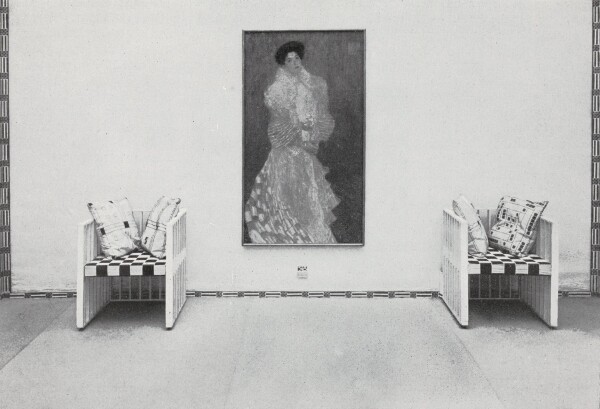
Insight into the XVIII Secession Exhibition, November 1903 - January 1904
© Klimt Foundation, Vienna
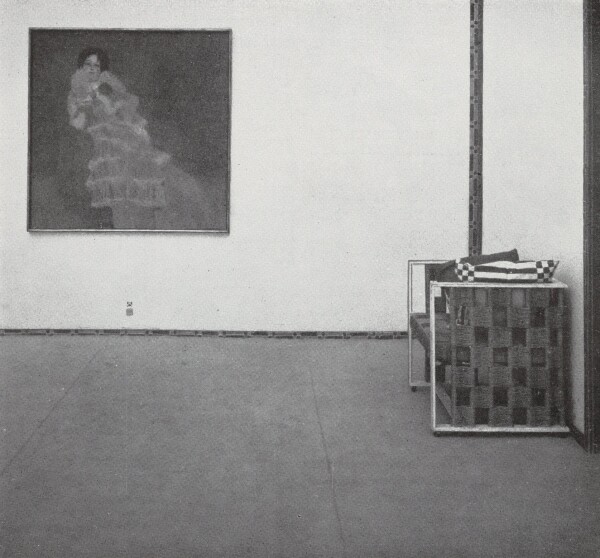
Insight into the XVIII Secession Exhibition, November 1903 - January 1904
© Klimt Foundation, Vienna
On the one hand, it was the goal of the exhibition to introduce the project to the Viennese public; on the other hand, it was hoped to raise additional funds through its presentation. The works were grouped according to regions and chronology, with Klimt as a modern Austrian artist appearing in one of the first rooms left of the entrance.
18th Exhibition of the Vienna Secession (Gustav Klimt Collective Exhibition)
In mid-November 1903, the “Kollektiv-Ausstellung Gustav Klimt” [“Gustav Klimt Collective Exhibition”], which had been planned well in advance, opened at the Secession. The show, which was intended to provide an overview of the artist’s output, comprised 46 paintings, more than 35 drawings, and the Beethoven Frieze, which had been realized the previous year. In altogether nine rooms designed by Kolo Moser and Josef Hoffmann, works from private collections hung side by side with works offered for sale, some of which were still unfinished. Together, they represented a more or less complete survey of the exceptional artist’s production to date. The highlight was the first public presentation of the third Faculty Painting, Jurisprudence (1903–1907, destroyed by fire at Immendorf Castle in 1945). The “Gustav Klimt Collective Exhibition” was thus the first show to bring together all of the three ceiling paintings, albeit unfinished. Instead of producing an ordinary catalog, the association decided to dedicate a special issue of its periodical Ver Sacrum to its former president. The public also displayed a keen interest in the exhibition. By the end of the second day, Klimt had successfully sold seven of his works.
Literature and sources
- Vereinigung bildender Künstler Österreichs Secession (Hg.): Katalog der X. Kunstausstellung der Vereinigung bildender Künstler Österreichs Secession, Ausst.-Kat., Secession (Vienna), 15.03.1901–12.05.1901, 1. Auflage, Vienna 1901.
- Ludwig Hevesi: Acht Jahre Sezession (März 1897–Juni 1905). Kritik – Polemik – Chronik, Vienna 1906.
- Visitenkarte von Anton Loew an die Vereinigung bildender Künstler Österreichs (10/22/1903). 24.4.2_Loew Anton_5861, .
- Städtischer Ausstellungspalast (Hg.): Offizieller Katalog der Internationalen Kunstausstellung Dresden 1901, Ausst.-Kat., Municipal Exhibition Palace (Dresden), 20.04.1901–03.11.1901, Dresden 1901.
- Brief von Gustav Klimt am Attersee an Maria Zimmermann (Ende August 1901). S63/21.
- Brief von Gustav Klimt am Attersee an Maria Zimmermann (August 1901). S63/20.
- Hermann Bahr: Gegen Klimt, Vienna 1903.
- Vereinigung bildender Künstler Österreichs Secession (Hg.): XIV. Ausstellung der Vereinigung bildender Künstler Österreichs Secession. Klinger Beethoven, Ausst.-Kat., Secession (Vienna), 15.04.1902–15.06.1902, Vienna 1902.
- N. N.: Katalog der Deutsch-Nationalen Kunstausstellung. Düsseldorf 1902, Ausst.-Kat., Municipal Art Palace (Düsseldorf), 01.05.1902–20.10.1902, Düsseldorf 1902.
- Berta Zuckerkandl (Hg.): Zeitkunst. Wien 1901–1907, Vienna 1908, S. 164.
- Brief mit Kuvert von Gustav Klimt am Attersee an Maria Zimmermann in Villach (17.08.1902). S64/18.
- k. k. Ministerium für Cultus und Unterricht (Hg.): Katalog der Modernen Galerie in Wien, Ausst.-Kat., Modern gallery (Vienna), 07.05.1903, Vienna 1903.
- Vereinigung bildender KünstlerInnen Wiener Secession (Hg.): Ver Sacrum. Gustav Klimt. XVIII. Ausstellung Nov.=Dez. 1903 Secession Wien, Ausst.-Kat., Secession (Vienna), 15.11.1903–06.01.1904, Vienna 1903.
- Pester Lloyd, 20.03.1901, S. 2.
- Neues Wiener Tagblatt, 16.03.1901, S. 1.
- Wiener Zeitung, 18.03.1901, S. 5.
- Neues Wiener Tagblatt, 30.08.1901, S. 6.
- Neues Wiener Tagblatt (Tagesausgabe), 01.02.1902, S. 8.
- Deutsches Volksblatt, 05.02.1902, S. 11.
- Illustrirtes Wiener Extrablatt, 14.02.1902, S. 7.
- Allgemeine Sport-Zeitung, 16.02.1902, S. 165.
- Illustrirtes Wiener Extrablatt, 02.04.1902, S. 9.
- Neues Wiener Tagblatt, 08.03.1902, S. 10.
- Neues Wiener Tagblatt, 03.04.1903, S. 8.
- Illustrirtes Wiener Extrablatt, 23.05.1903, S. 6.
- Illustrirtes Wiener Extrablatt, 05.05.1903.
- Wien Geschichte Wiki. Moderne Galerie. www.geschichtewiki.wien.gv.at/Moderne_Galerie (04/27/2020).
- Neues Wiener Journal, 15.11.1903, S. 10.
- Neue Freie Presse (Morgenausgabe), 12.04.1905, S. 8.
- Ostdeutsche Rundschau (Morgenausgabe), 12.04.1903, S. 7.
- Wiener Zeitung, 28.03.1903, S. 5.
- Peter Vergo: Fritz Waerndorfer as Collector, in: Alte und moderne Kunst. Österreichische Zeitschrift für Kunst, Kunsthandwerk und Wohnkultur, 26. Jg., Heft 177 (1981), S. 33-38.
- Vereinigung bildender Künstler Österreichs Secession (Hg.): Dritter Jahresbericht der Vereinigung bildender Künstler Österreichs Secession, Vienna 1901, S. 9.
Drawings
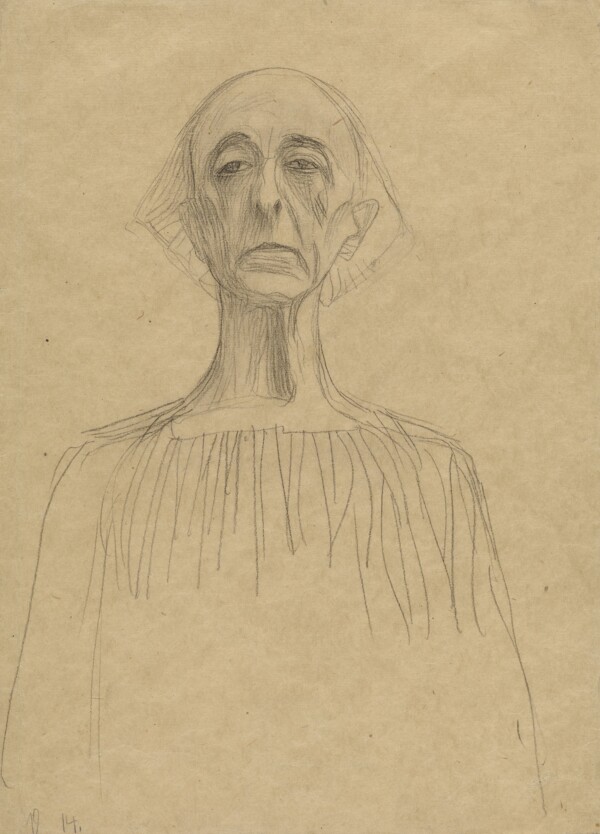
Gustav Klimt: Bust portrait of a man from the front, 1901-1903, Wien Museum
© Wien Museum

Gustav Klimt: The medicine (transfer sketch), circa 1900, The Albertina Museum
© The ALBERTINA Museum, Vienna
Shortly after 1900, Klimt expanded his previously preferred medium of charcoal to include a pointed pencil and polychromy in the form of colored pencils. Beautifully curved outlines and parallel hatching became increasingly relevant. Using nude models, he studied postures and emotions in coherent series.
Sketches for the Faculty Paintings
Sketches for the Faculty Paintings of Philosophy, Medicine, and Jurisprudence (all three of which were destroyed by fire at Immendorf Castle in 1945) make up the bulk of the drawings created between 1900 and 1903. The artist made countless series of studies for these commissioned paintings, most of which had nudes as their subject. Ludwig Hevesi reported that Klimt had experimented with the most diverse postures, different ages, and the internalized expressions of the individuals depicted in “entire batches of nude drawings.” Hevesi also described Klimt’s working method by referring to these studies:
“How many white sheets with chalk studies from nature he has drawn once again for this painting [i.e., the Faculty Painting of Jurisprudence]! I saw him meandering amidst them in the summer in the larger one of his studios; they lay scattered on the floor, for many a figure even more than one sketch, so as to be chosen from and weighed against one another from a bird’s eye view.”
In this context, the transfer sketches for Medicine (c. 1900, Albertina, Vienna, S 1980: 605) and Jurisprudence (1900, private collection, S 1980: 942) certainly hold a special position. The squared true-to-scale cartoons show traces in black chalk and pencil. Klimt worked out the most important outlines with thin pencil strokes, while he prepared the two-dimensional colored composition with rubbed charcoal strokes. Not only do the transfer sketches exhibit the result of an extensive genesis and motif finding process that had been preceded by thousands of sketches, but they also give an impression of how the presumably first version of the paintings, which had been heavily reworked until 1907, might have looked like. That the meaning of the transfer sketches went far beyond their practical function for Klimt is attested to by the fact that the transfer sketch for Jurisprudence was presented as an object in its own right at the “Kollektiv-Ausstellung Gustav Klimt” [“Gustav Klimt Collective Exhibition”] in 1903.
Further proof of the important role even work sketches played in Klimt’s oeuvre is the fierce hostility and criticism with which not only the finished Faculty Paintings, but also the studies made in preparation were met. The sketches for Medicine, which also depict the human body in a state of old age and illness and present female bodies in the nude in endless variants and from all perspectives imaginable, fell victim to censorship when it came to their publication in Ver Sacrum. The 6th issue of the 4th year was confiscated due to the violation of public morality. Like with the subsequent scandal surrounding the painting Hope I (1903/04, National Gallery of Canada, Ottawa), the reason was the depiction of a naked pregnant woman.
Ver Sacrum. Mitteilungen der Vereinigung bildender Künstler Österreichs, 4th year, 6th issue (1901)
-
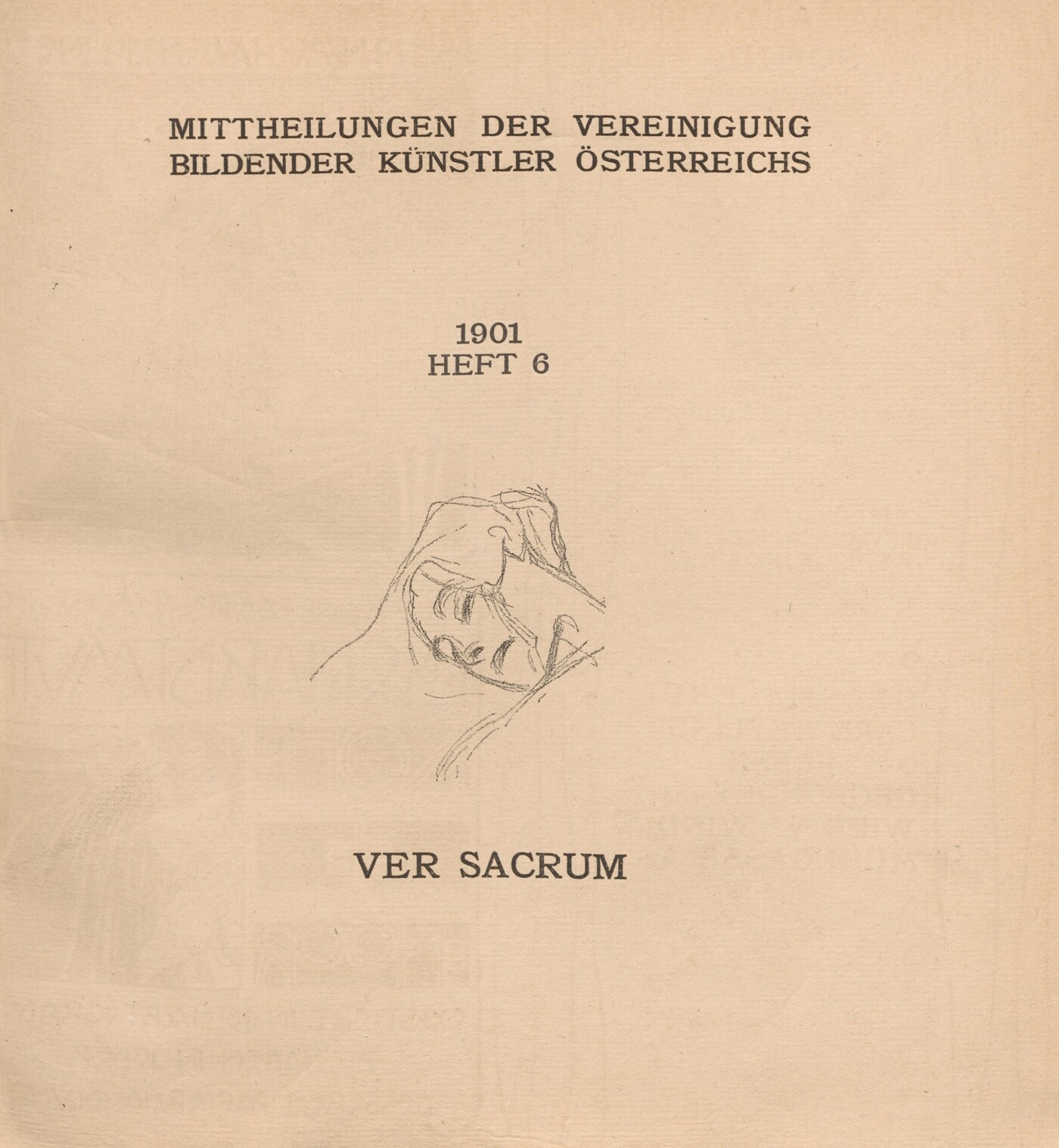 Vereinigung bildender KünstlerInnen Wiener Secession (Hg.): Ver Sacrum. Mitteilungen der Vereinigung bildender Künstler Österreichs, 4. Jg., Heft 6 (1901).
Vereinigung bildender KünstlerInnen Wiener Secession (Hg.): Ver Sacrum. Mitteilungen der Vereinigung bildender Künstler Österreichs, 4. Jg., Heft 6 (1901).
© Klimt Foundation, Vienna -
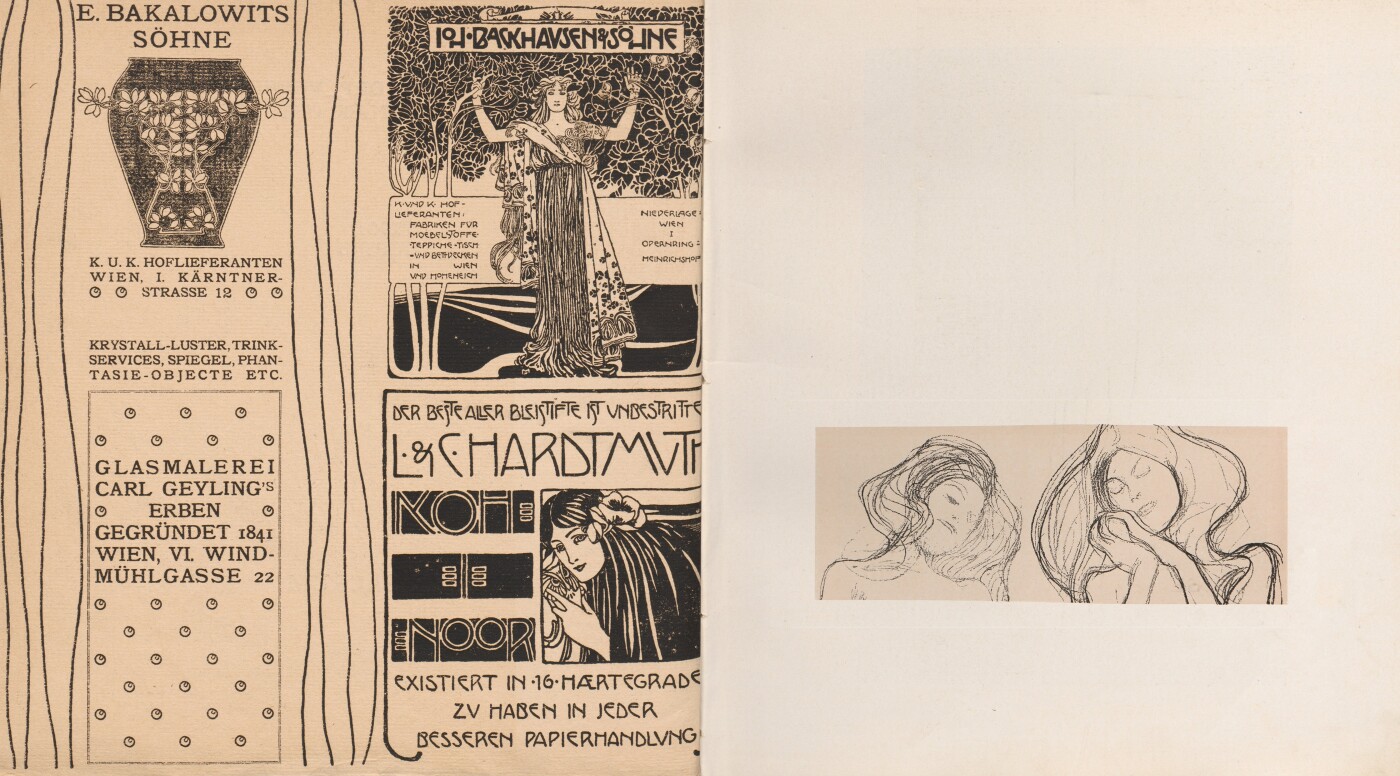 Vereinigung bildender KünstlerInnen Wiener Secession (Hg.): Ver Sacrum. Mitteilungen der Vereinigung bildender Künstler Österreichs, 4. Jg., Heft 6 (1901).
Vereinigung bildender KünstlerInnen Wiener Secession (Hg.): Ver Sacrum. Mitteilungen der Vereinigung bildender Künstler Österreichs, 4. Jg., Heft 6 (1901).
© Klimt Foundation, Vienna -
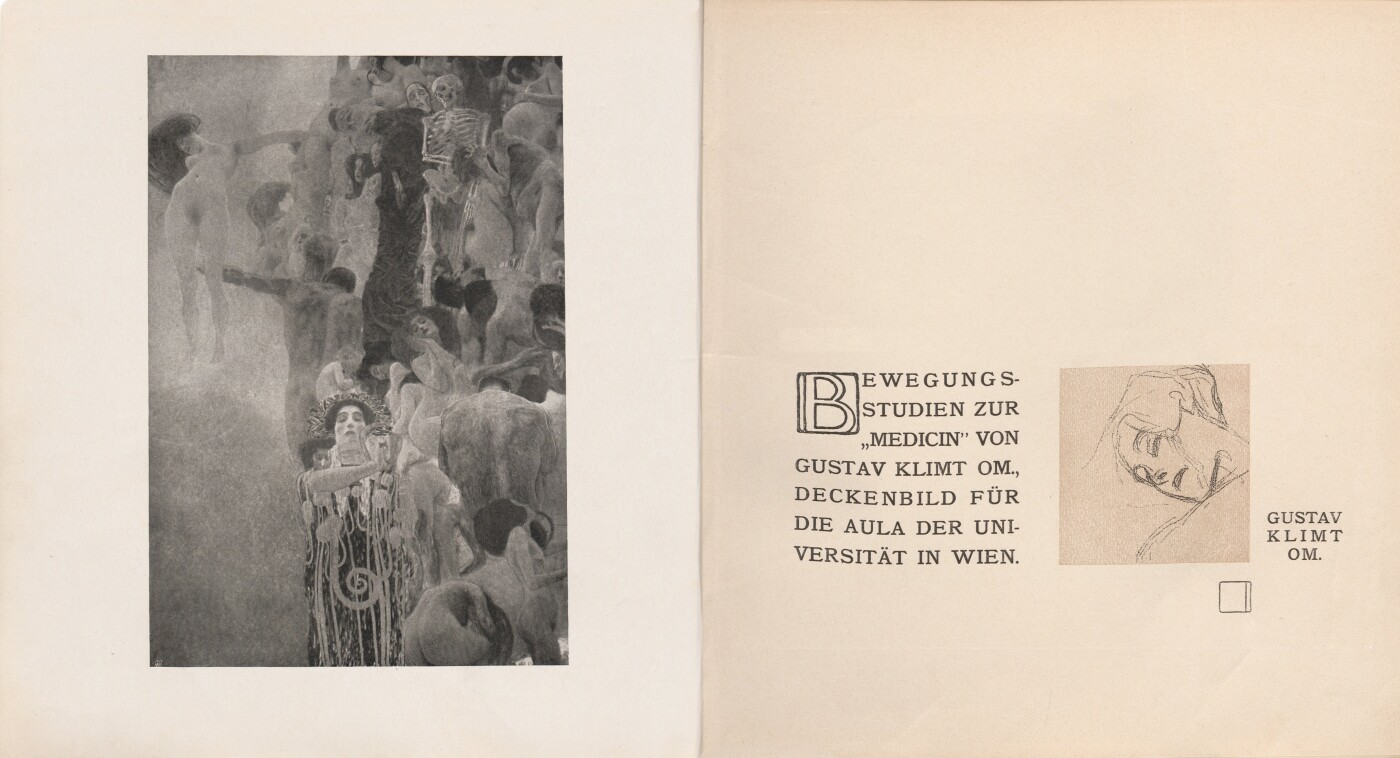 Vereinigung bildender KünstlerInnen Wiener Secession (Hg.): Ver Sacrum. Mitteilungen der Vereinigung bildender Künstler Österreichs, 4. Jg., Heft 6 (1901).
Vereinigung bildender KünstlerInnen Wiener Secession (Hg.): Ver Sacrum. Mitteilungen der Vereinigung bildender Künstler Österreichs, 4. Jg., Heft 6 (1901).
© Klimt Foundation, Vienna -
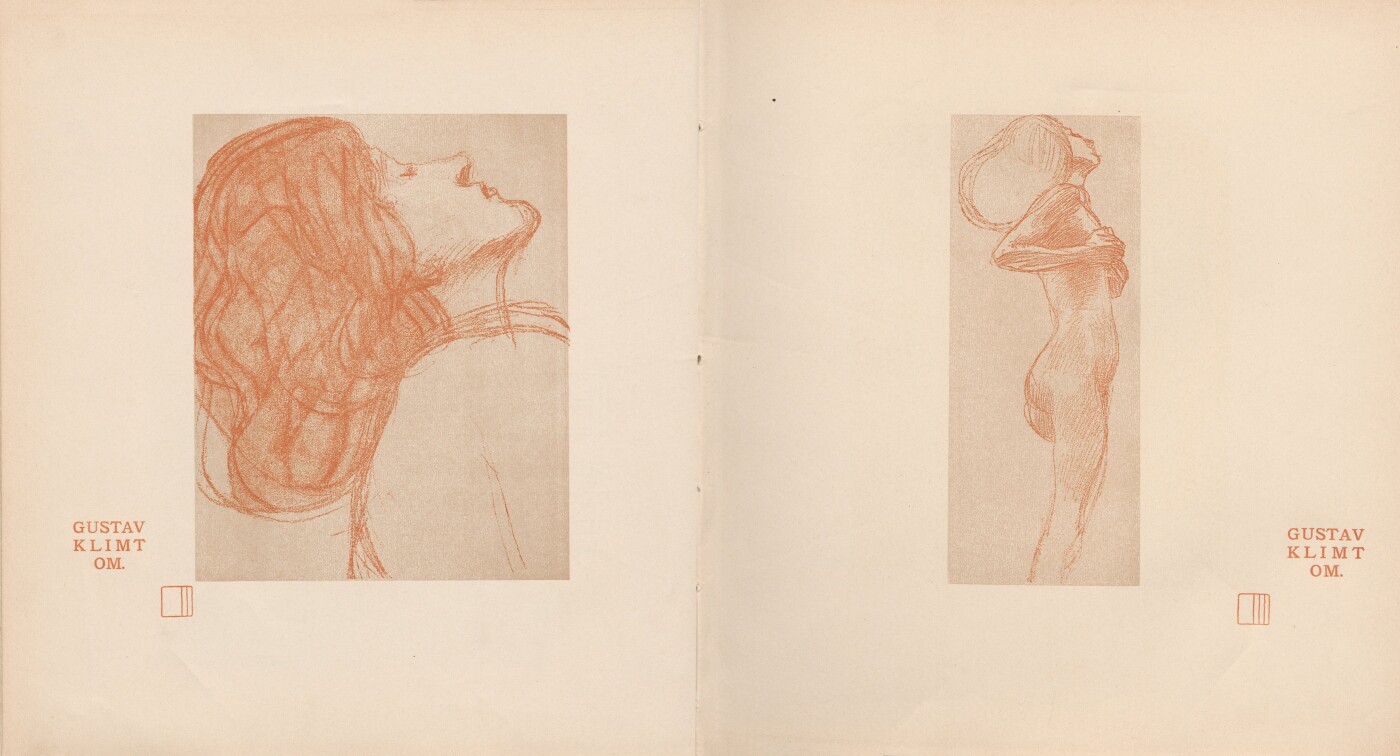 Vereinigung bildender KünstlerInnen Wiener Secession (Hg.): Ver Sacrum. Mitteilungen der Vereinigung bildender Künstler Österreichs, 4. Jg., Heft 6 (1901).
Vereinigung bildender KünstlerInnen Wiener Secession (Hg.): Ver Sacrum. Mitteilungen der Vereinigung bildender Künstler Österreichs, 4. Jg., Heft 6 (1901).
© Klimt Foundation, Vienna -
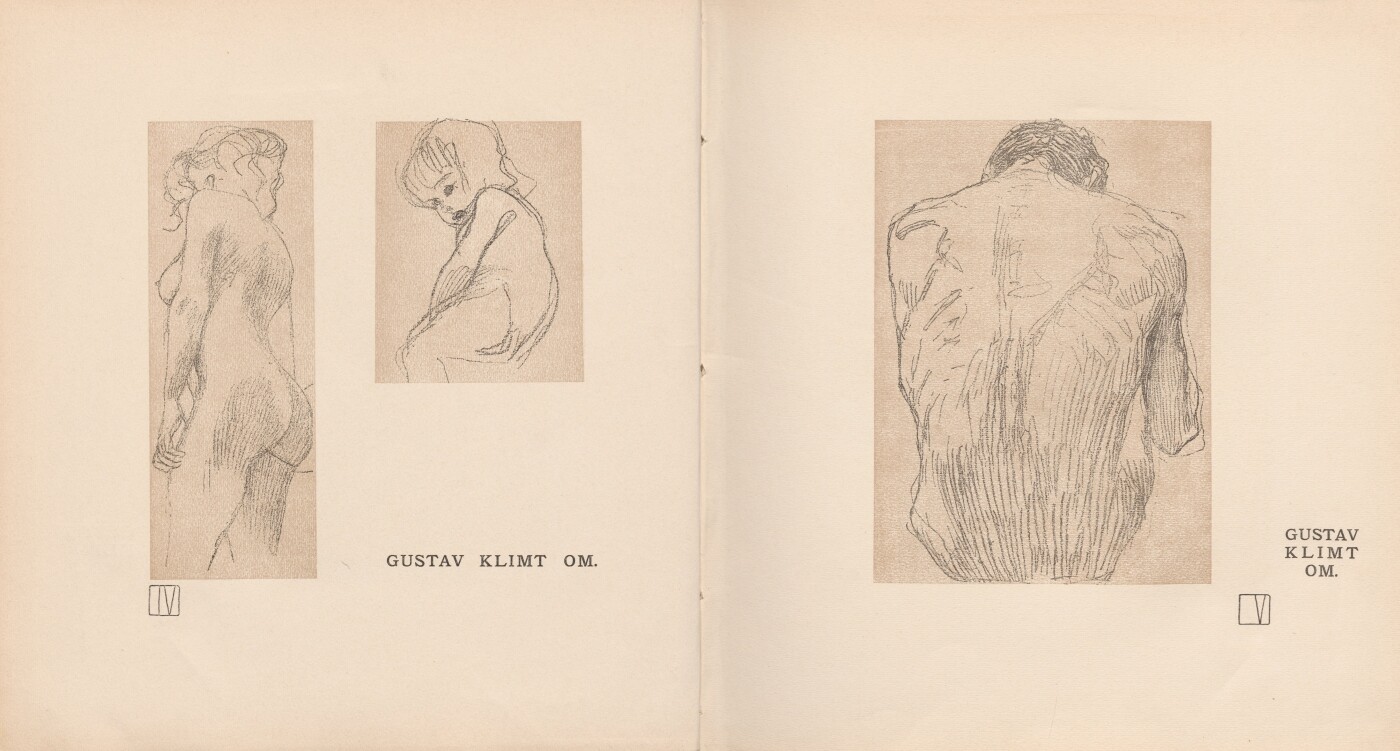 Vereinigung bildender KünstlerInnen Wiener Secession (Hg.): Ver Sacrum. Mitteilungen der Vereinigung bildender Künstler Österreichs, 4. Jg., Heft 6 (1901).
Vereinigung bildender KünstlerInnen Wiener Secession (Hg.): Ver Sacrum. Mitteilungen der Vereinigung bildender Künstler Österreichs, 4. Jg., Heft 6 (1901).
© Klimt Foundation, Vienna -
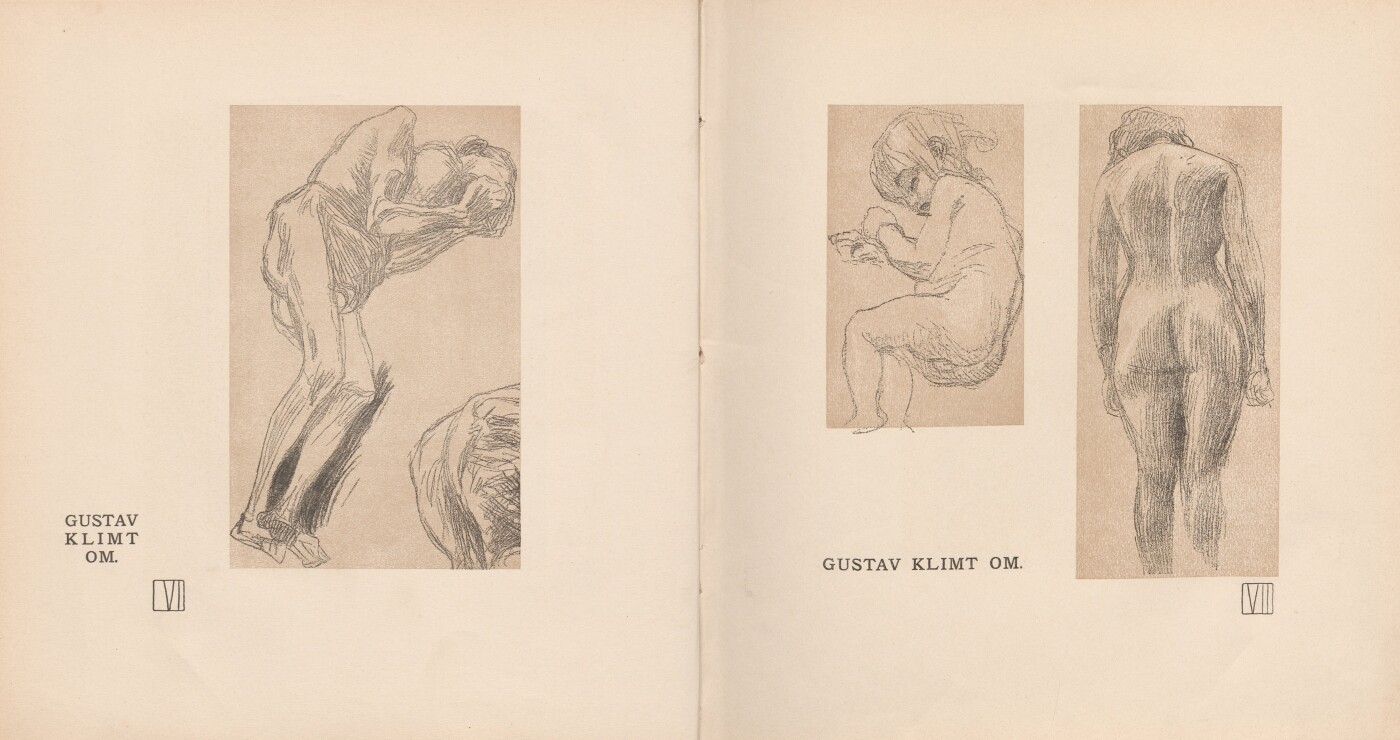 Vereinigung bildender KünstlerInnen Wiener Secession (Hg.): Ver Sacrum. Mitteilungen der Vereinigung bildender Künstler Österreichs, 4. Jg., Heft 6 (1901).
Vereinigung bildender KünstlerInnen Wiener Secession (Hg.): Ver Sacrum. Mitteilungen der Vereinigung bildender Künstler Österreichs, 4. Jg., Heft 6 (1901).
© Klimt Foundation, Vienna -
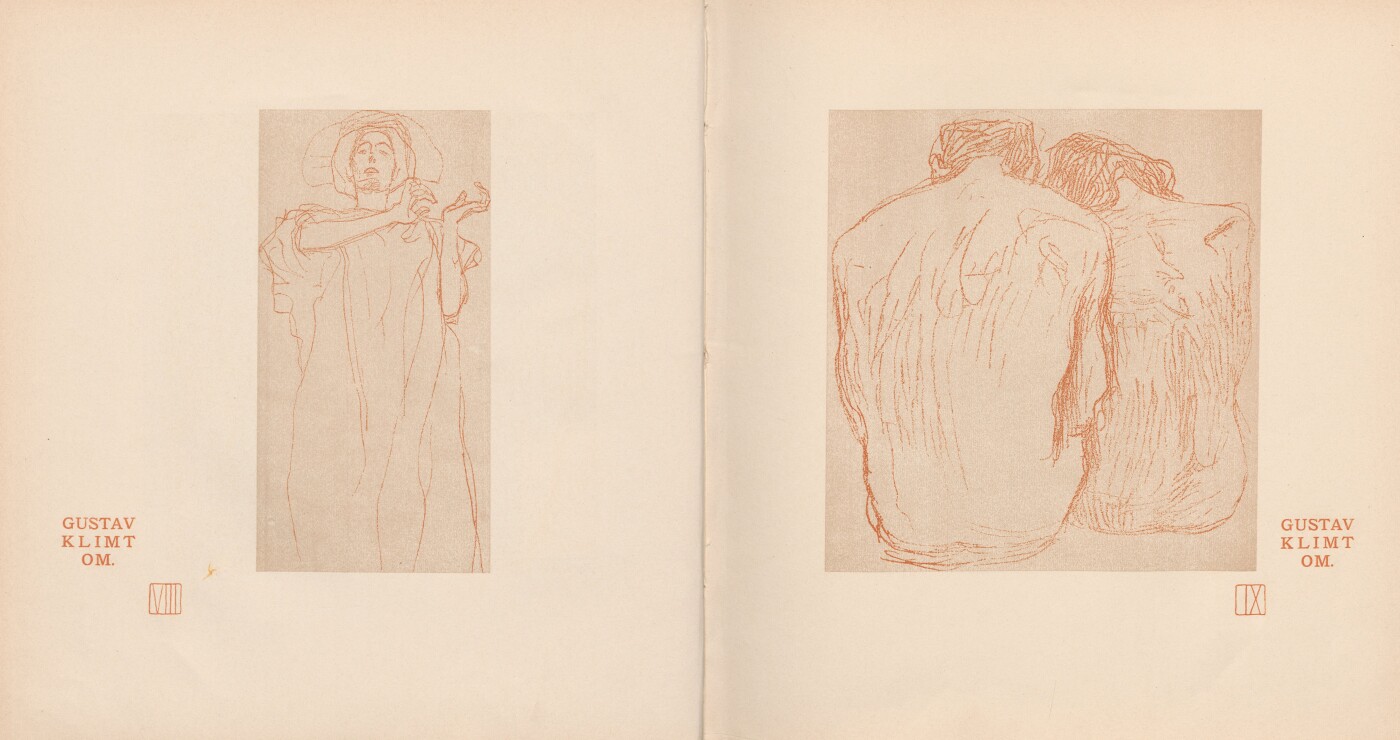 Vereinigung bildender KünstlerInnen Wiener Secession (Hg.): Ver Sacrum. Mitteilungen der Vereinigung bildender Künstler Österreichs, 4. Jg., Heft 6 (1901).
Vereinigung bildender KünstlerInnen Wiener Secession (Hg.): Ver Sacrum. Mitteilungen der Vereinigung bildender Künstler Österreichs, 4. Jg., Heft 6 (1901).
© Klimt Foundation, Vienna -
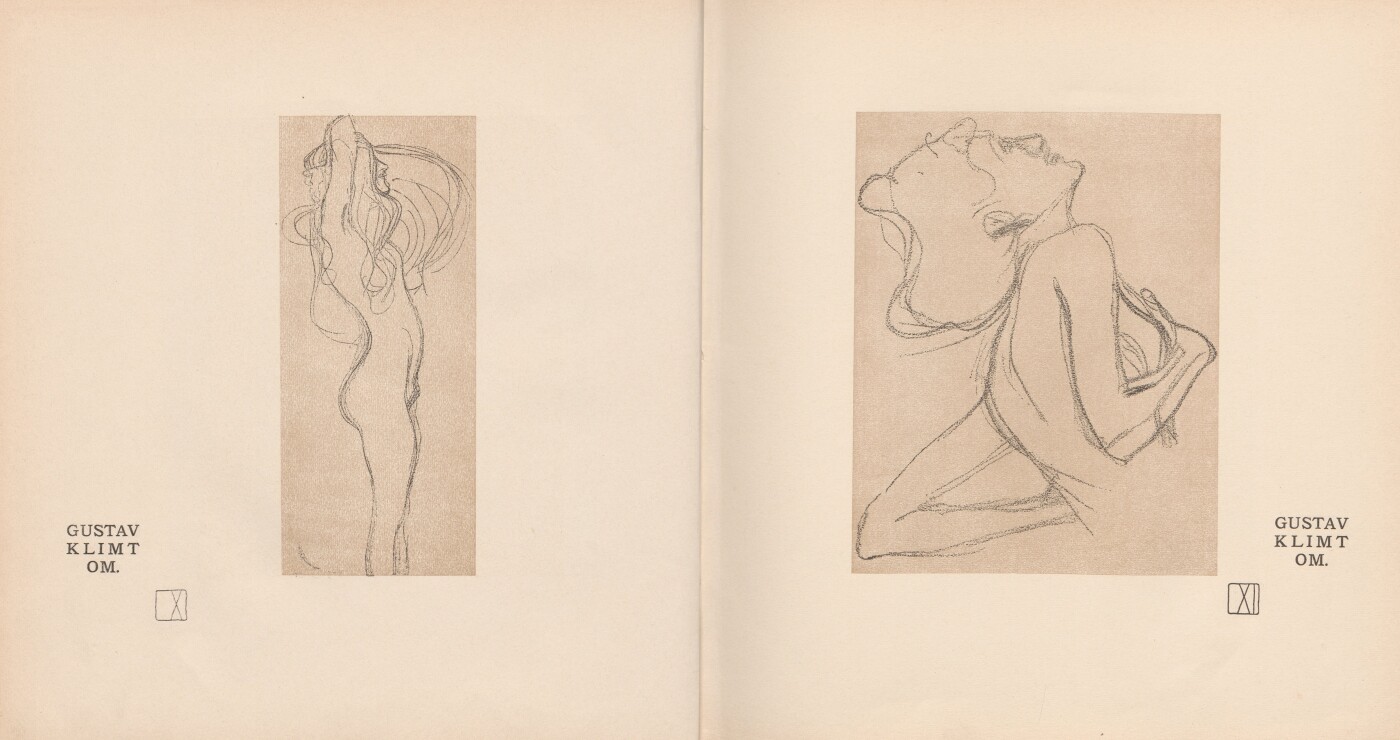 Vereinigung bildender KünstlerInnen Wiener Secession (Hg.): Ver Sacrum. Mitteilungen der Vereinigung bildender Künstler Österreichs, 4. Jg., Heft 6 (1901).
Vereinigung bildender KünstlerInnen Wiener Secession (Hg.): Ver Sacrum. Mitteilungen der Vereinigung bildender Künstler Österreichs, 4. Jg., Heft 6 (1901).
© Klimt Foundation, Vienna -
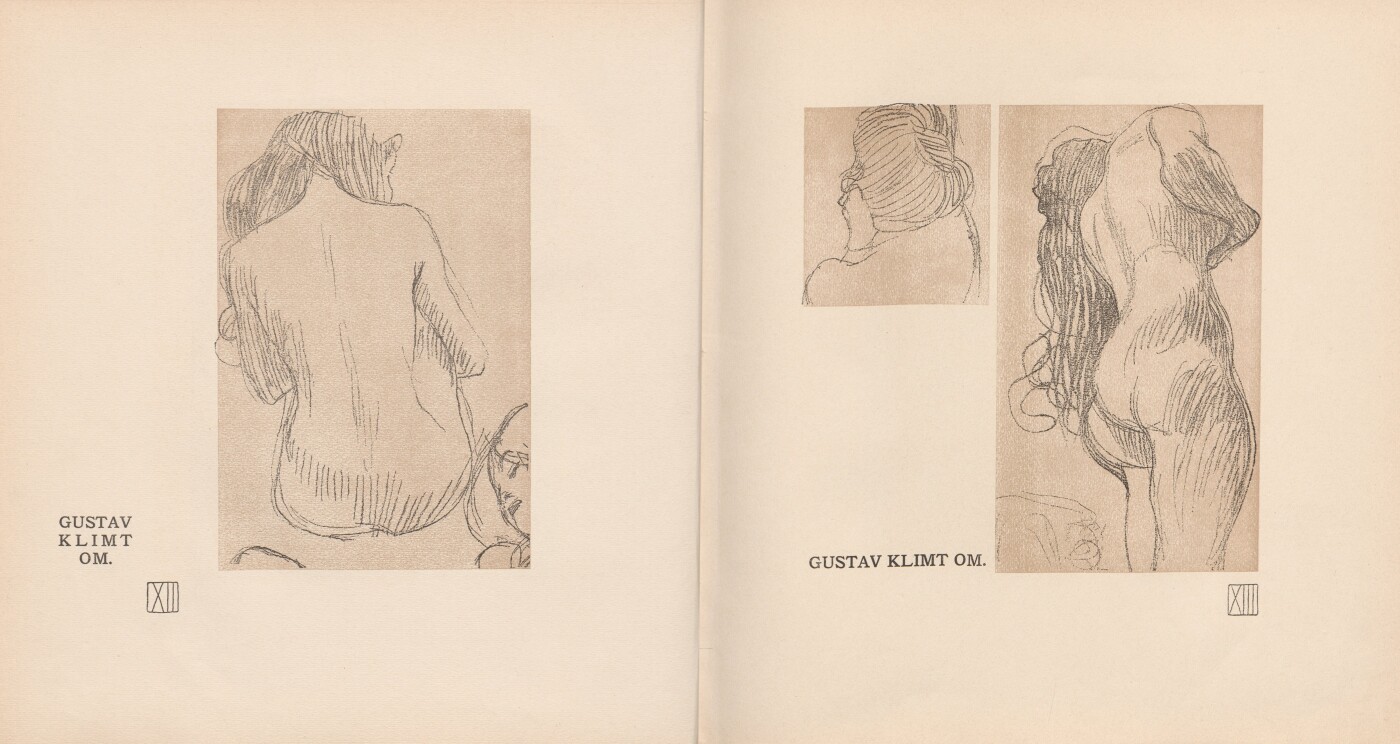 Vereinigung bildender KünstlerInnen Wiener Secession (Hg.): Ver Sacrum. Mitteilungen der Vereinigung bildender Künstler Österreichs, 4. Jg., Heft 6 (1901).
Vereinigung bildender KünstlerInnen Wiener Secession (Hg.): Ver Sacrum. Mitteilungen der Vereinigung bildender Künstler Österreichs, 4. Jg., Heft 6 (1901).
© Klimt Foundation, Vienna -
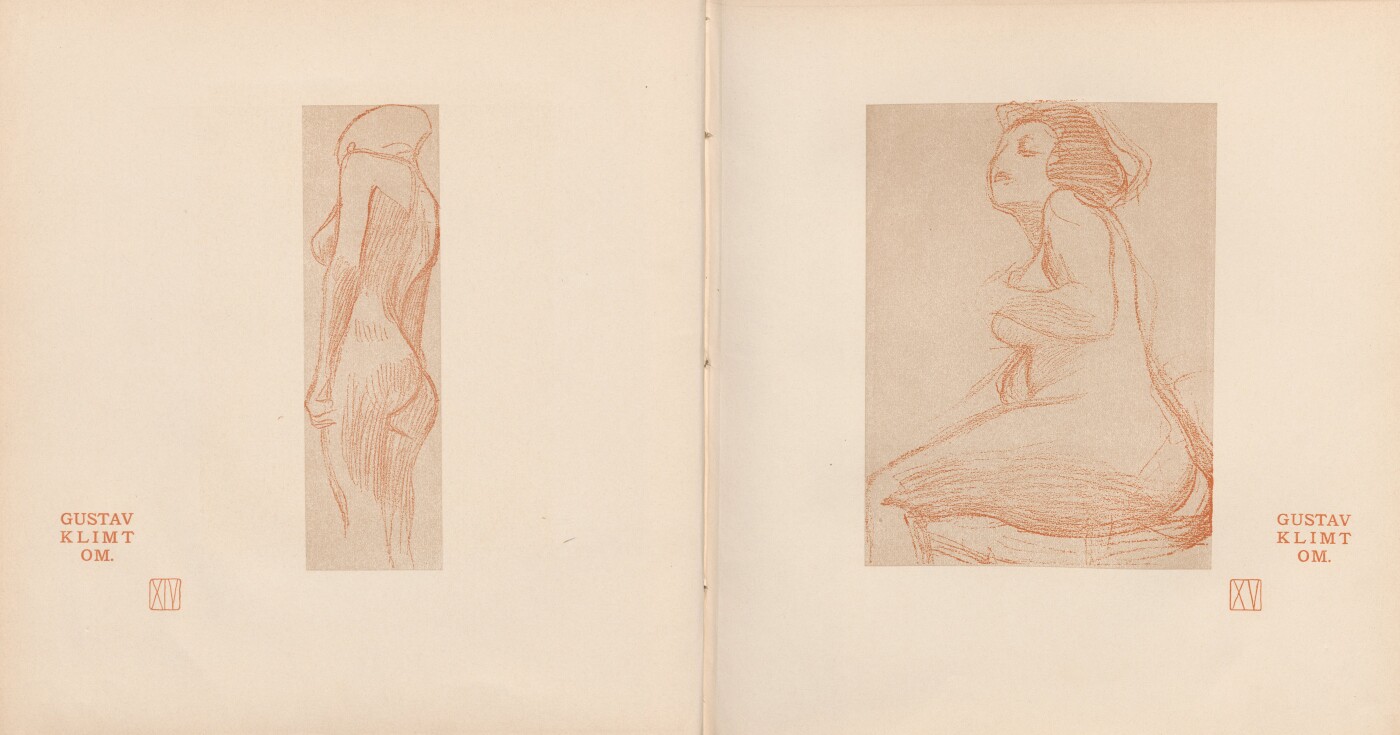 Vereinigung bildender KünstlerInnen Wiener Secession (Hg.): Ver Sacrum. Mitteilungen der Vereinigung bildender Künstler Österreichs, 4. Jg., Heft 6 (1901).
Vereinigung bildender KünstlerInnen Wiener Secession (Hg.): Ver Sacrum. Mitteilungen der Vereinigung bildender Künstler Österreichs, 4. Jg., Heft 6 (1901).
© Klimt Foundation, Vienna -
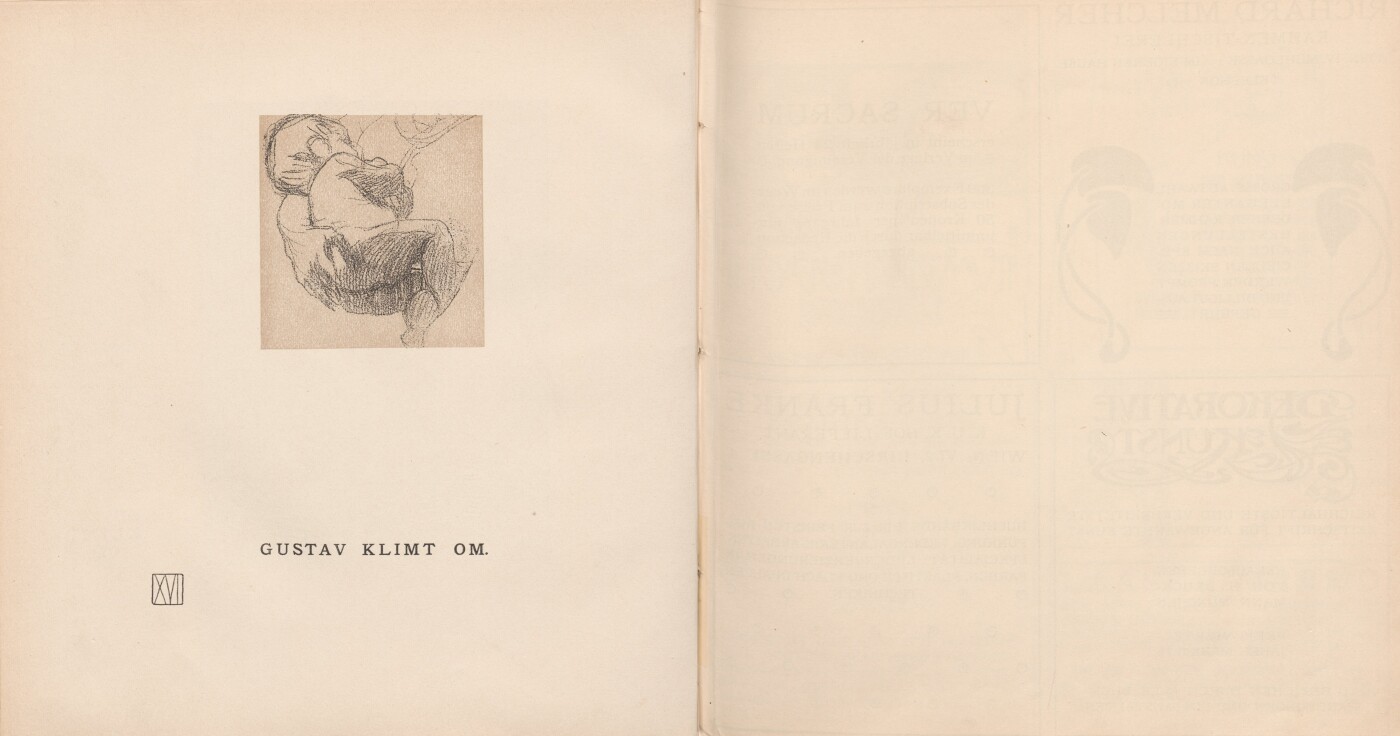 Vereinigung bildender KünstlerInnen Wiener Secession (Hg.): Ver Sacrum. Mitteilungen der Vereinigung bildender Künstler Österreichs, 4. Jg., Heft 6 (1901).
Vereinigung bildender KünstlerInnen Wiener Secession (Hg.): Ver Sacrum. Mitteilungen der Vereinigung bildender Künstler Österreichs, 4. Jg., Heft 6 (1901).
© Klimt Foundation, Vienna -
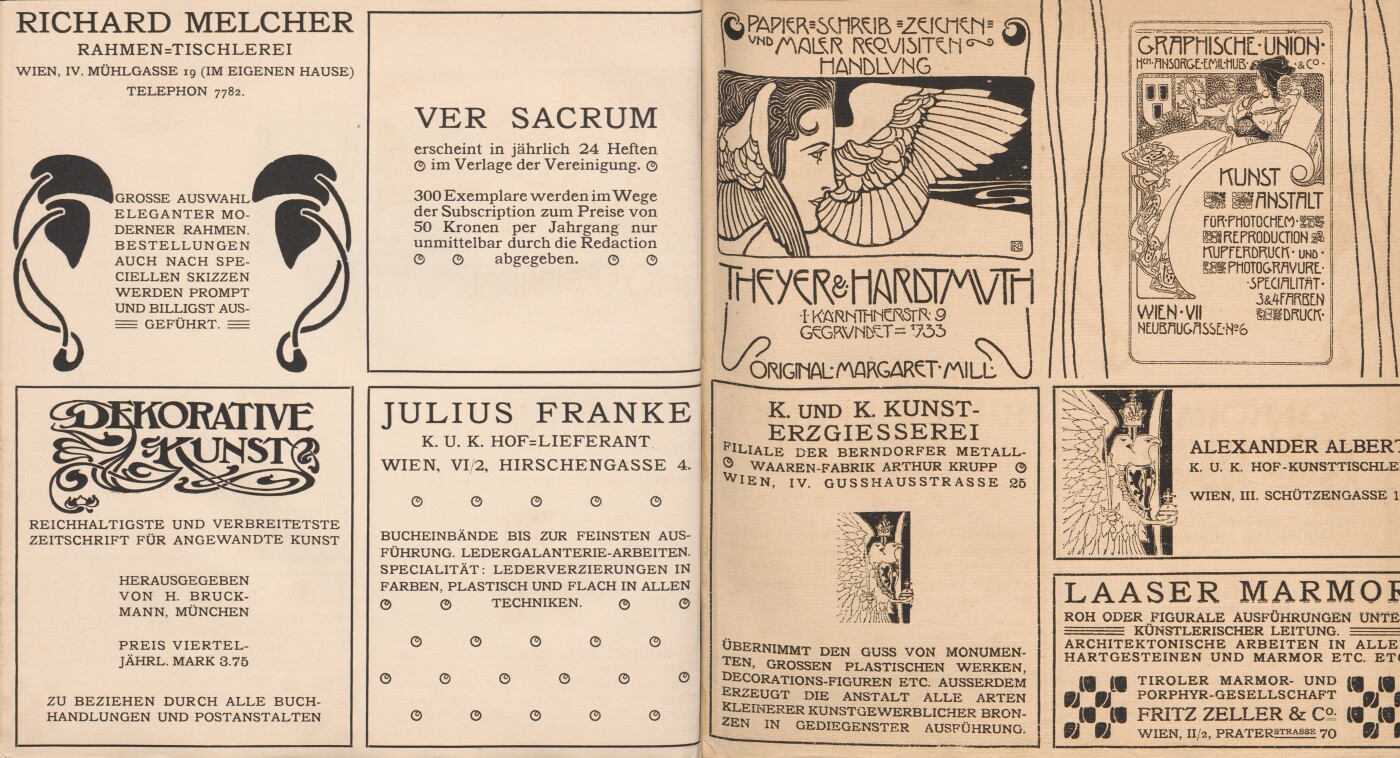 Vereinigung bildender KünstlerInnen Wiener Secession (Hg.): Ver Sacrum. Mitteilungen der Vereinigung bildender Künstler Österreichs, 4. Jg., Heft 6 (1901).
Vereinigung bildender KünstlerInnen Wiener Secession (Hg.): Ver Sacrum. Mitteilungen der Vereinigung bildender Künstler Österreichs, 4. Jg., Heft 6 (1901).
© Klimt Foundation, Vienna -
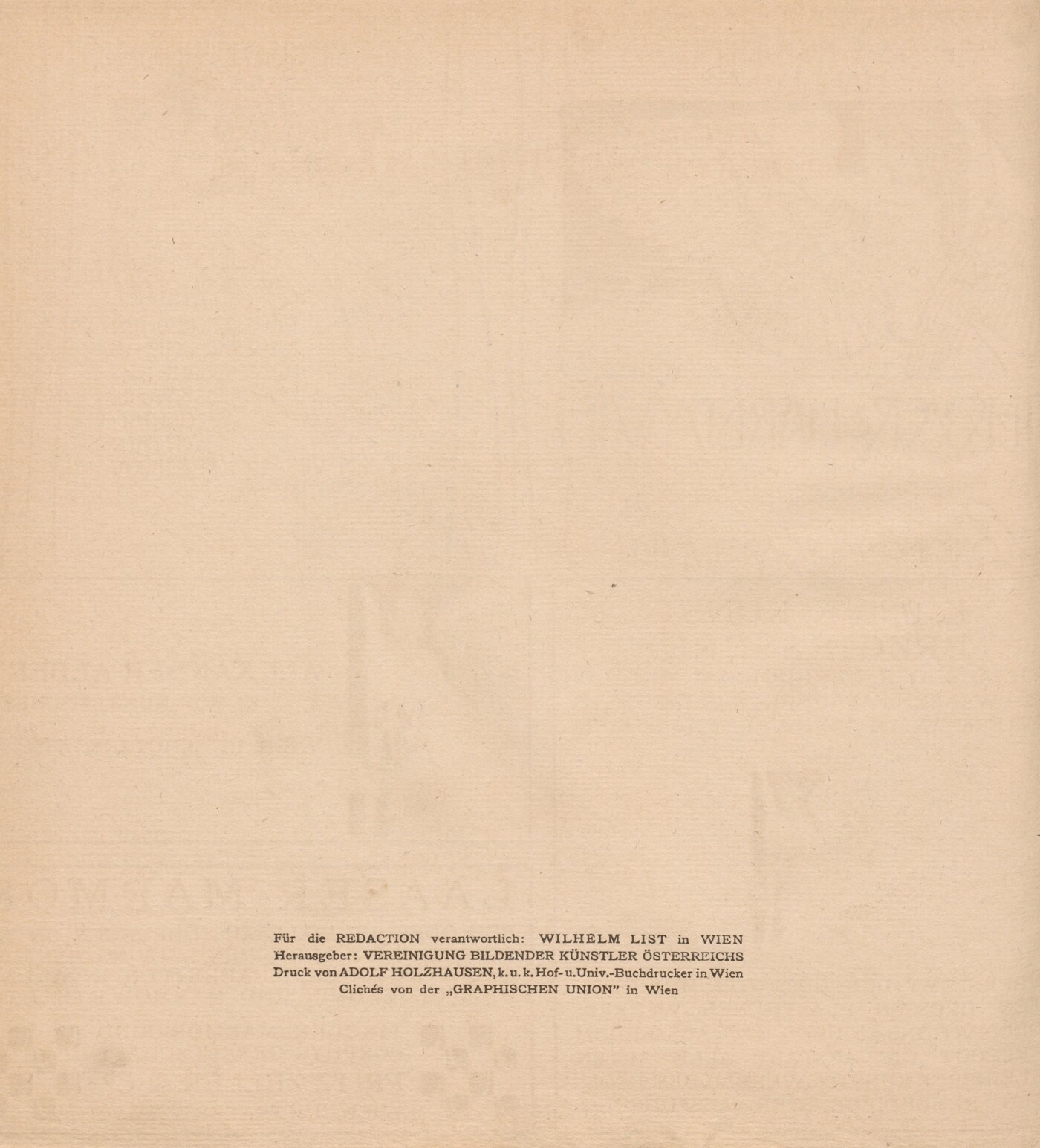 Vereinigung bildender KünstlerInnen Wiener Secession (Hg.): Ver Sacrum. Mitteilungen der Vereinigung bildender Künstler Österreichs, 4. Jg., Heft 6 (1901).
Vereinigung bildender KünstlerInnen Wiener Secession (Hg.): Ver Sacrum. Mitteilungen der Vereinigung bildender Künstler Österreichs, 4. Jg., Heft 6 (1901).
© Klimt Foundation, Vienna
The Faculty Paintings’ genesis, which began in 1898, illustrates Klimt’s development as a draftsman. The sketches, most of which represent individual figures, increasingly broke away from naturalistic, three-dimensional representation. If Klimt had still aimed to create subtle nuances of light and dark in 1897/98, starting in 1900 he focused on the annulment of depth and volume in favor of expressive movement. The elongated, almost fluid forms of the human body are accentuated through long lines and vertical hatching. In conjunction with the lack of hands and legs, this leads to what seems to be the figure’s projection from and subsequent fusion with the surface of the sheet.
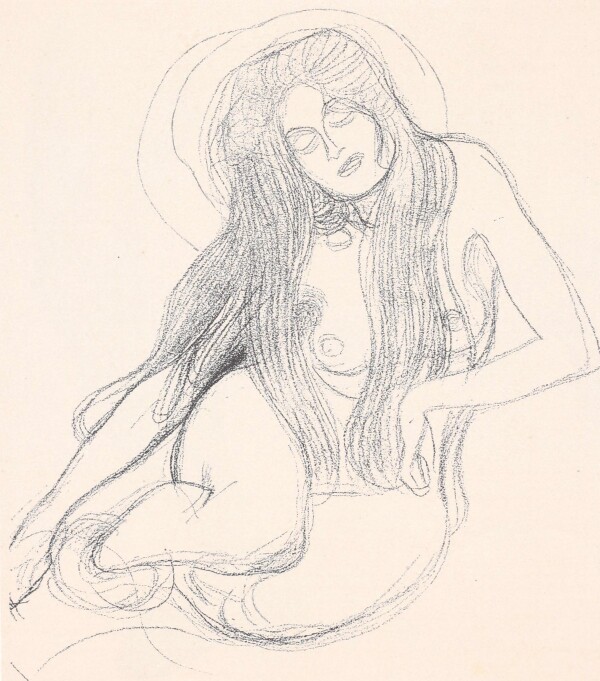
Gustav Klimt: Seated female nude, 1902, in: Vereinigung bildender KünstlerInnen Wiener Secession (Hg.): Ver Sacrum. Mitteilungen der Vereinigung bildender Künstler Österreichs, 5. Jg., Heft 10 (1902).
© Klimt Foundation, Vienna
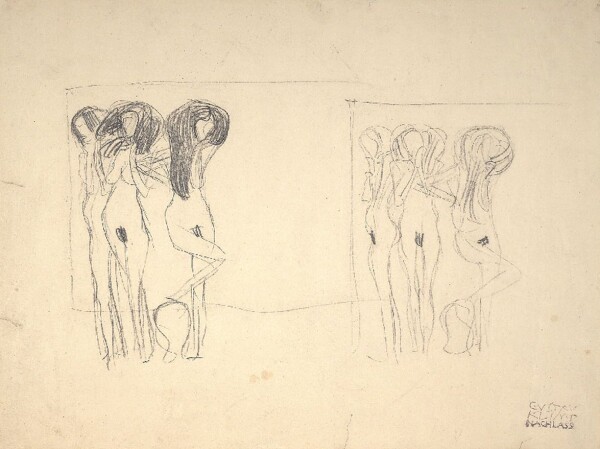
Gustav Klimt: Two composition sketches for the "Three Gorgons" in the Beethoven Frieze, 1901, The Albertina Museum
© The ALBERTINA Museum, Vienna
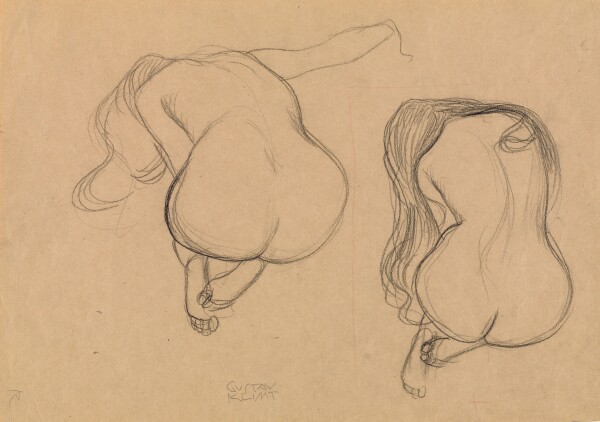
Gustav Klimt: Two studies of a seated nude with long hair, 1901/02, The J. Paul Getty Museum
© The J. Paul Getty Museum, Los Angeles
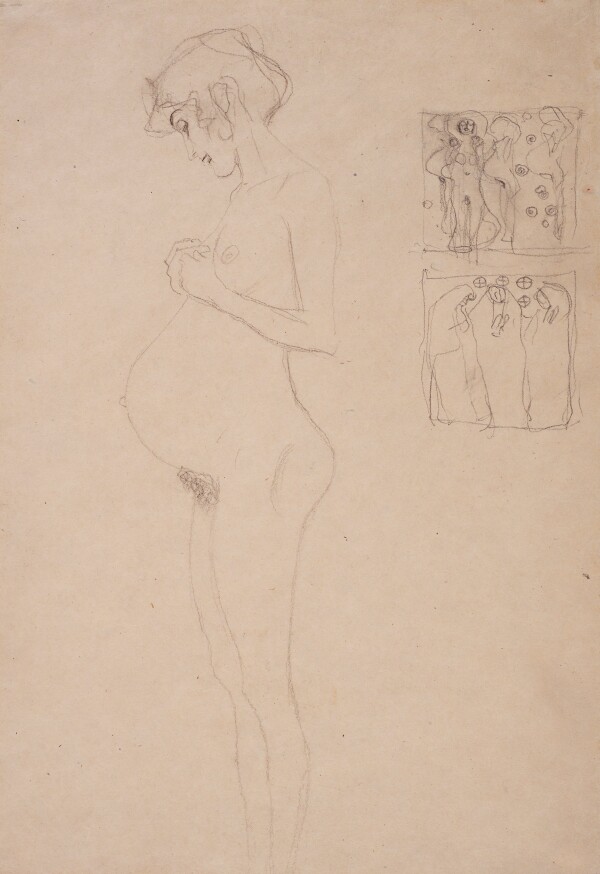
Gustav Klimt: Standing pregnant nude woman facing left, two compositional sketches. Study for "Hope I", circa 1902, Leopold Museum
© Leopold Museum, Vienna
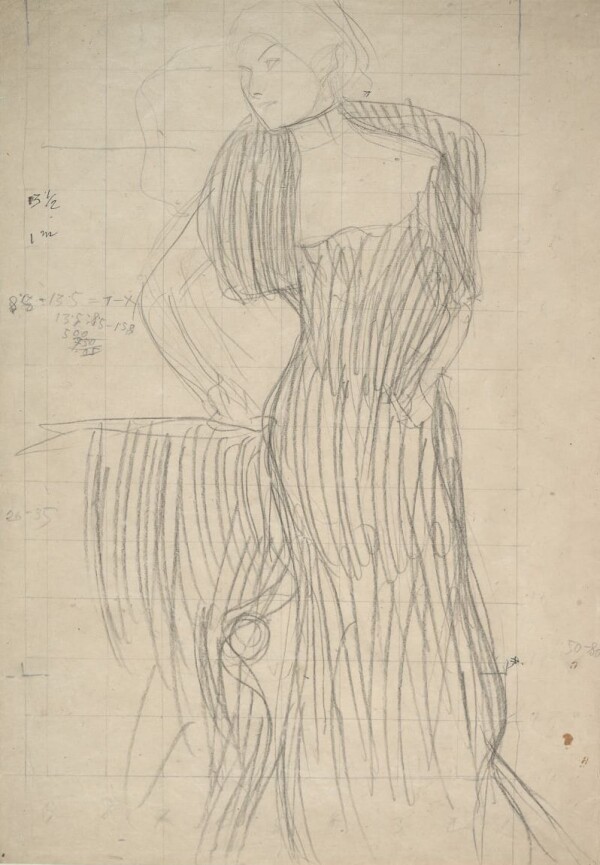
Gustav Klimt: Study for "Portrait of Rose von Rosthorn-Friedmann", 1900/01, The Albertina Museum
© The ALBERTINA Museum, Vienna
Studies for the Beethoven Frieze
Klimt’s studies for the Beethoven Frieze (1901/02, Belvedere, Wien) constitute a coherent set of works. In the summer of 1901, Klimt began with the first sketches for the monumental frieze, which was to be presented at the “XIV. Ausstellung der Vereinigung bildender Künstler Österreichs Secession” [“14th Exhibition of the Association of Austrian Artists Secession”] in 1902, an event dedicated to Max Klinger and Ludwig van Beethoven. Out of some 300 figure studies, roughly 125 preparatory designs on paper are known today. Sheets marked R in the lower right corner probably come from Carl Reininghaus, the first owner of the frieze. A selection of these works and the frieze itself subsequently entered the Lederer Collection, where Klimt eventually signed them, albeit belatedly.
The Beethoven Frieze sketches stand out for their minimal use of internal drawing. The figures are mostly defined by thick, dominant contours. Special focus is placed on the modeling of the hair, gestures, and posture. On the basis of the sketches, Klimt worked out all the individual figures in terms of their expressive quality and according to their position in the frieze. Almost all studies for this work are executed in chalk on kraft paper.
Two compositional sketches for the Three Gorgons (1901, Albertina, Vienna, Inv. 39315, S 1980: 802) represent an exception in this otherwise self-contained creative process, not only in terms of motif, but also functionally. The study is one of the few surviving schematic representations that focus purely on the compositional arrangement of the figures instead of their appearance in detail as separate pictorial elements. Neither did Klimt choose the medium of charcoal for this summary sketch, but pencil, which is more suitable for swiftly composed sketches.
The drawing style adopted by Klimt, which is dominated by outlines without modulation through shading or hatching, was strongly dependent on two inspirations. On the one hand, he borrowed from the drawing style of fellow artists like Jan Toorop, Fernand Khnopff, Edvard Munch, and others. Especially in a sketch for Lust (private collection, S 1980: 813), the similarity to Edvard Munch’s graphic art is obvious. On the other hand, many drawings are reminiscent of Japanese woodcuts in their emphasis on linearity and outlines. Furthermore, Far Eastern pictorial elements also found their way into the preparatory sketches for the Beethoven Frieze. Figure studies related to Gnawing Grief Klimt initially wrapped in kimonos. There is evidence that Klimt owned several books on Japanese art, which he also enjoyed studying during his summer retreat on the Attersee – where he also made the sketches for the frieze.
Studies for Goldfish
The painting Goldfish (1901/02, Kunstmuseum Solothurn, Dübi-Müller-Stiftung, Solothurn) may be seen as Klimt’s response to the harsh criticism caused by the presentation of his Faculty Painting of Medicine. Particularly the figure of a crouching nude with red hair seen from behind and presenting her buttocks to the viewer in a suggestive, mocking manner provoked an éclat. Most of the studies for this painting had originally been made for other works and were subsequently revisited by Klimt for the composition of Goldfish. Thus, sketches for said back view of a nude (1901, The J. Paul Getty Museum, Los Angeles, inv. no. 2009.57.2, S 1980: 862) could be linked to studies for the figure of Gnawing Grief in the Beethoven Frieze. Another study (private collection, S 1980: 860) also shows the figure in the foreground of Goldfish, already vividly worked out by hatching and contrasts of light and dark. The shadowy sketch to her right probably served for the preparation of the back view of the black-haired nude sitting more upright. The great care with which the artist studied the crouching nude with bare buttocks and which he did not bestow on the other figures clearly identifies the red-haired woman as the main figure in the composition.
Studies for Hope I
Klimt’s exploration of the themes of birth and death in the painting Hope I (1903/04, National Gallery of Canada, Ottawa) is often associated with the early death of his illegitimate son Otto Zimmermann on 11 September 1902. The painting was preceded by an extensive series of studies of heavily pregnant women, some in the protective embrace of a male partner. Klimt shows them in profile, so that the bulging belly is in the focus of the composition. Due to their stylistic proximity to the drawings for the Beethoven Frieze, the sketches are dated around 1902. The representations of the figures increasingly extend beyond the frame, so that both heads and feet are mostly incomplete. This resulted in Klimt’s switching to larger formats in the years to come. What is also striking about the series is that Klimt expanded his spectrum to include the medium of colored pencil in red and blue. In addition to soft chalk and hard pencil, the painter still resorted to kraft paper; a few years later he would draw the sketches for Hope II on more expensive Japan paper.
Portrait Studies
Other important drawings are to be seen in connection with Klimt’s portraits of the first years after 1900: The sketches for Portrait of Rose von Rosthorn-Friedmann (1900/01, private collection) and Portrait of Marie Henneberg (1901/02, Stiftung Moritzburg, Kunstmuseum des Landes Sachsen-Anhalt, Halle an der Saale), as well as the first compositional studies for Portrait of Adele Bloch-Bauer I (1907, Neue Galerie New York), which was completed in 1907, all show solely the women posing in their elegant dresses. The focus here is never on finishing the part of the face; the sitters predominantly appear as robed figures. With regard to the background, Klimt apparently left all options open for himself. Large parts of the detailed design of the face and background seem to have been developed directly on the canvas when the artist was already painting.
Literature and sources
- Marian Bisanz-Prakken (Hg.): Gustav Klimt. Die Zeichnungen, Ausst.-Kat., Albertina (Vienna), 14.03.2012–10.06.2012; Getty Center (Los Angeles), 03.07.2012–23.09.2012, Munich 2012.
- Marian Bisanz-Prakken (Hg.): Heiliger Frühling. Gustav Klimt und die Anfänge der Wiener Secession 1895–1905, Ausst.-Kat., Albertina (Vienna), 16.10.1998–10.01.1999, Vienna 1999.
- Alice Strobl (Hg.): Gustav Klimt. Die Zeichnungen, Band I, 1878–1903, Salzburg 1980.
- Rainer Metzger: Gustav Klimt. Das graphische Werk, Vienna 2005.
- Ludwig Hevesi: Neue Bilder von Klimt. Die Medizin. 16. März 1901, in: Acht Jahre Sezession (März 1897–Juni 1905). Kritik – Polemik – Chronik, Vienna 1906, S. 316–324, S. 318.
- Ludwig Hevesi: Sezession Klimt-Ausstellung. 14. November 1903, in: Acht Jahre Sezession (März 1897–Juni 1905). Kritik – Polemik – Chronik, Vienna 1906, S. 443–452, S. 448.
- Ursula Storch (Hg.): Klimt. Die Sammlung des Wien Museums, Ausst.-Kat., Vienna Museum (Vienna), 16.05.2012–07.10.2012, Vienna 2012.
- Anette Vogel (Hg.): Gustav Klimt Beethovenfries. Zeichnungen, Ausst.-Kat., Balingen Town Hall (Balingen), 10.07.2010–26.09.2010, Munich 2010.
- John Collins: Klimt’s Hope I: New Documentation and its Interpretation, in: National Gallery of Canada (Hg.): National Gallery of Canada Review, Band 2 (2001), S. 27–58.
- Alice Strobl: Zu den Fakultätsbildern. Anlässlich der Neuerwerbung einer Einzelstudie zur „Philosophie“ durch die Graphische Sammlung Albertina, in: Albertina Studien, 2. Jg., Heft 4 (1964), S. 138-169.
- Marian Bisanz-Prakken: Gustav Klimt und die „Stilkunst“ Jan Toroop, in: Klimt-Studien. Mitteilungen der Österreichischen Galerie, Heft 66-67 (1978/79), S. 146–214.
- Ludwig Hevesi: Feuilleton. Eine Klimt-Ausstellung (Sezession), in: Pester Lloyd, 18.11.1903, S. 2.
- Brief von Gustav Klimt am Attersee an Maria Zimmermann in Wien, mit skizziertem Motivsucher (um den 03.08.1902). S64/17.
- Bestellschein von Gustav Klimt in Wien an die Buchhandlung Artaria & Co in Wien (20.09.1907). H.I.N. 76.134/2, .
- Neues Wiener Journal, 22.08.1925, S. 6.


